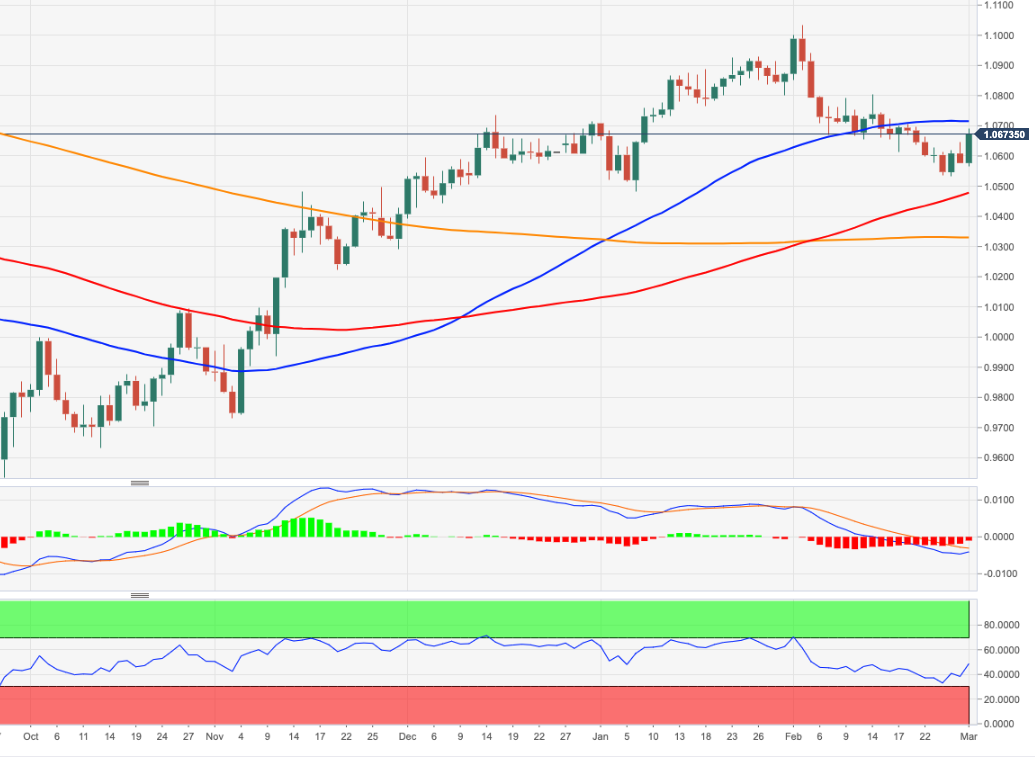- Analytics
- News and Tools
- Market News
CFD Markets News and Forecasts — 01-03-2023
- EUR/JPY is marching towards 145.50 gradually as chances of more rates from the ECB look solid.
- Along with Germany, the price index in Spain and France has also surprised market participants with an upside release.
- Tokyo’s inflation is seen lower despite expansionary monetary policy from the BoJ.
The EUR/JPY pair is approaching the critical resistance of 145.50 gradually in the early Tokyo session. The cross rebounded firmly from below 144.00 after a perpendicular fall amid a surprise rise in the German Harmonized Index of Consumer Prices (HICP) (Feb) data. The annual preliminary HICP jumped to 9.3% against the consensus of 9.0% and the 9.2% figure released earlier. On a monthly basis, the German HICP has jumped by 1% vs. the expectations of 0.7%.
A surprise rise in German inflation has bolstered the expectations of further rise in interest rates by the European Central Bank (ECB). Along with Germany, the price index in Spain and France has also surprised market participants with an upside release.
It looks like the upbeat labor market is demanding higher wages from firms and then pumping extra funds into the economy. The street is already anticipating that Eurozone might avoid a deep recession, which could be backed by upbeat domestic demand.
Post-release of German inflation, ECB policymaker Joachim Nagel reiterated on Wednesday that further significant rate hikes beyond March may be needed, as reported by Reuters. He further added, "Energy price drop has no essential bearing on ECB's medium-term inflation projections." ECB policymaker expects the "German economy to contract in Q1; gradual pick up from Q2 seen but no major improvement seen."
For further action, Eurozone inflation data will be keenly watched, which is scheduled for Thursday. The preliminary Eurozone HICP (Feb) is seen declining to 8.2% from the former release of 8.6%. Apart from that, the Unemployment Rate (Jan) is expected to decline to 6.5% versus 6.6% released earlier.
The Japanese Yen is likely to dance to the tunes of the Tokyo inflation data, which will release on Friday. Tokyo’s headline Consumer Price Index (CPI) (Feb) is expected to decline to 4.1% from the prior release of 4.4%. The Japanese economy is struggling to accelerate domestic demand despite immense initiatives from Bank of Japan (BoJ) policymakers and the administration.
On Wednesday, Bank of Japan (BoJ) board member Junko Nakagawa also cited the current monetary policy as appropriate as an expansionary policy is highly essential for supporting the economy and fueling wages.
- USD/CHF picks up bids to reverse the previous day’s pullback moves.
- Swiss PMI, Real Retail Sales also came in softer after downbeat Q4 GDP.
- US ISM PMI details, hawkish Fed talks keep inflation fears on the table and propel the US Treasury bond yields.
- Second-tier data, risk catalysts are the key to clear directions.
USD/CHF licks its wounds around 0.9400, following a downbeat start of the March month, as the Swiss currency pair picks up bids during early Thursday. In doing so, the quote justifies downbeat statistics at home, versus firmer details of the US data, as well as the strong Treasury bond yields and hawkish Fed talks, which could recall the US Dollar bulls.
That said, Swiss Real Retail Sales shrank 2.2% YoY in January versus 2.2% expected growth a revised down previous reading of -3.0%. On the same line was the Swiss SVME Purchasing Managers’ Index for February as it marched 48.9 market forecasts versus 49.3 prior. It should be noted that the Swiss Gross Domestic Product (GDP) arrived at 0% in the fourth quarter (Q4) of 2022 vs. an expected growth of 0.3% and 0.2% recorded in the third quarter.
On the other hand, US ISM Manufacturing PMI details renew inflation fears as the headline gauge rose to 47.7 from 47.4 prior, versus the 48.0 expected but the Prices Paid and New Orders marked the highest figures in five and four months respectively.
Not only the data but hawkish Federal Reserve (Fed) talks also challenge the previous day’s US Dollar weakness, as well as the USD/CHF pullback. Minneapolis Federal Reserve (Fed) President Neel Kashkari said, "Wage growth is now too high to be consistent with 2% inflation." The policymaker also added and noted that it is concerning that the Federal Reserve's rate hikes so far have not brought down service inflation.
It’s worth noting, however, that the previously softer US data dump and China-inspired risk-on mood, as well as month-start consolidation, seemed to have teased the USD/CHF bears.
Amid these plays, the US 10-year Treasury bond yields rose to the highest levels since early November 2022 by poking the 4.0% mark whereas the two-year counterpart rallied to the June 2007 levels by piercing the 4.90% mark. The jump in the US Treasury bond yields suggests the market’s fears of inflation and recession, which in turn probed bulls on Wall Street and weigh on S&P 500 Futures of late, suggesting a likely rebound on the US Dollar.
Looking ahead, a light calendar pushes the USD/CHF traders to keep track of the risk catalysts for fresh impulse.
Technical analysis
A 13-day-old bullish channel, currently between 0.9345 and 0.9480, keeps USD/CHF buyers hopeful.
- GBP/USD finds interest around 1.2000 as the USD Index is demonstrating signs of volatility contraction.
- Upbeat forward demand and higher prices paid by producers indicate a rebound in US inflation.
- BoE Bailey reiterated that the UK labor market is extremely tight.
The GBP/USD pair has sensed buying interest after a marginal correction to near 1.2000 in the early Asian session. The Cable is still inside the woods amid a mixed market mood. The US Dollar Index (DXY) is looking to sustain its auction above the 104.00 support after a recovery move from below 103.70 as the United States ISM Manufacturing PMI gamut conveyed a rebound in the inflationary pressures.
S&P500 futures witnessed pressure as investors are still struggling to ignore fears of more rates from the Federal Reserve (Fed). Hawkish commentaries delivered by Fed policymakers fueled US Treasury yields. The return offered on 10-year US government bonds jumped to 4%.
Minneapolis Fed President Neel Kashkari reiterated on Wednesday that inflation in the US is still very high and that their job is to bring it down, as reported by Reuters. He further added that he is open-minded on a 25 basis points (bps) hike versus a 50 bps increase.
Considering the whole US ISM Manufacturing PMI (Feb) gamut, it would be appropriate to consider a rebound in the US Consumer Price Index (CPI) as forward demand and prices paid by producers have skyrocketed.
The ISM Manufacturing New Orders Index accelerated to 47.0 from the expectations of 43.7 and the former release of 42.5. And the Manufacturing Price Paid climbed to 51.3 vs. the consensus of 45.0 and the former release of 44.5. Higher prices paid by manufacturers will be added to the goods offered by them and will amp up the inflationary pressures.
Ambiguous commentary from Bank of England (BoE) Governor Andrew Bailey has pushed the Pound Sterling inside the woods. An absence of clear guidance on interest rates kept investors on the sidelines. BoE Bailey said that some further increase in bank rates may turn out to be appropriate but added that nothing is decided, as reported by Reuters. However, he reiterated that the United Kingdom's labor market is extremely tight.
- NZD/USD seesaws in a choppy range after confirming a bullish chart formation and refreshing two-week high.
- Convergence of 21-day EMA, 200-day EMA challenges Kiwi pair buyers.
- Looming bull cross on MACD defends upside bias.
NZD/USD bulls struggle to justify the falling wedge breakout as the key moving averages challenge upside near the mid-0.6200s during early Thursday. However, the impending bull cross on the MACD indicator keeps the Kiwi pair buyers hopeful, especially after the confirmation of the bullish chart pattern the previous day.
The upside break of a one-month-old falling wedge bullish formation failed to cross the convergence of the 200-day Exponential Moving Average (EMA) and the 21-day EMA, around 0.6270 by the press time.
Should the quote crosses the immediate hurdle, as expected due to the MACD conditions and falling wedge confirmation, the NZD/USD can quickly poke the mid-February swing high surrounding 0.6390.
In a case where the Kiwi buyers keep the reins past 0.6390, as well as cross the 0.6400 threshold, the highs marked in the last December and the previous month, respectively near 0.6515 and 0.6540, could act as buffers during the theoretical run-up targeting 0.6600.
Meanwhile, pullback moves remain less important until the quote stays beyond the aforementioned wedge’s top line, close to 0.6175 at the latest.
It’s worth noting that January’s low of 0.6190 acts as the immediate support for the NZD/USD bears to watch during the fresh fall.
That said, lows marked during November 14 and 17 around 0.6060 appear the key for the pair sellers to track as a break of which won’t hesitate to challenge the 0.6000 psychological magnet.
NZD/USD: Daily chart
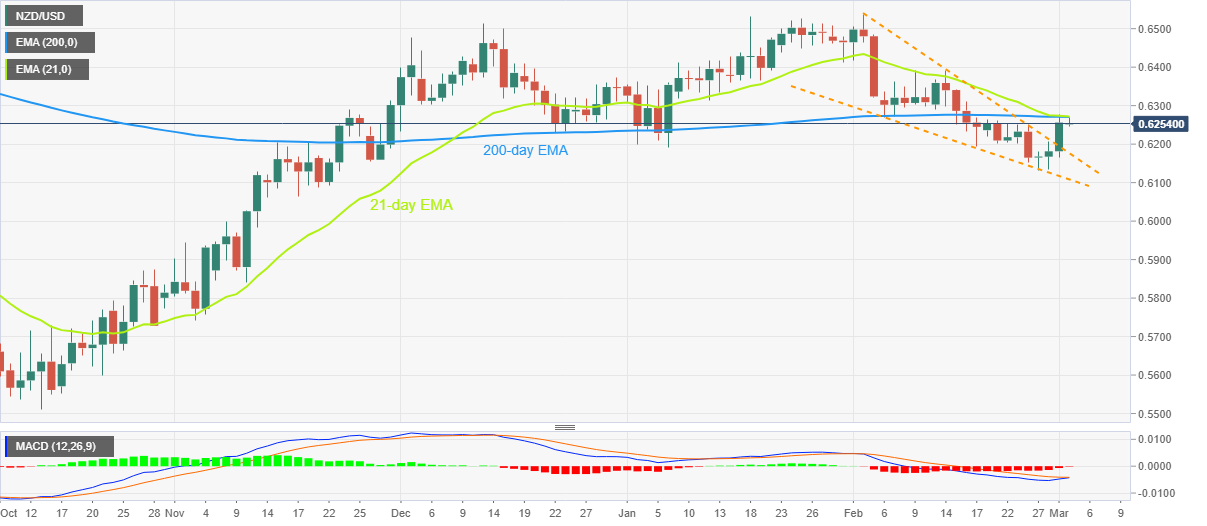
Trend: Further upside expected
- AUD/USD struggles to defend the previous day’s rebound from a two-month low, grinds higher of late.
- Downbeat Aussie data contrasts with China-inspired optimism to challenge bulls.
- Softer US Dollar allowed Aussie buyers to begin March on a positive note.
- Strong US Treasury bond yields, mixed US data appears a challenge for the bulls.
AUD/USD remains sidelined around 0.6755 as traders await more signals to back the latest rebound from a two-month low during early Thursday morning in Asia. In doing so, the Aussie pair struggles to justify the softer US Dollar and China-linked market optimism amid strong US Treasury bond yields and mostly upbeat US data.
That said, the Aussie pair managed to reverse the Aussie GDP and inflation-induced pessimism after strong China activity data for February. The risk barometer pair also benefited from China Finance Minister Liu He’s comments as he showed readiness to bolster the nation’s fiscal spending. The policymaker also mentioned that the foundation of China's economic recovery is still not stable and challenges the AUD/USD bulls afterward.
Elsewhere, US ISM Manufacturing PMI details renew inflation fears as the headline gauge rose to 47.7 from 47.4 prior, versus the 48.0 expected but the Prices Paid and New Orders marked the highest figures in five and four months respectively.
Ahead of the data, Minneapolis Federal Reserve (Fed) President Neel Kashkari said, "Wage growth is now too high to be consistent with 2% inflation." The policymaker also added and noted that it is concerning that the Federal Reserve's rate hikes so far have not brought down service inflation.
It should be observed the US 10-year Treasury bond yields rose to the highest levels since early November 2022 by poking the 4.0% mark whereas the two-year counterpart rallied to the June 2007 levels by piercing the 4.90% mark. The jump in the US Treasury bond yields suggests the market’s fears of inflation and recession, which in turn challenge the risk-barometer AUD/USD pair. That said, Wall Street closed mixed while the S&P 500 Futures struggled for clear directions of late.
Looking forward, Australia’s Building Permits for January may offer immediate direction ahead of the US Weekly Initial Jobless Claims. However, major attention will be on Friday’s US ISM Services PMI amid fears of strong services inflation.
Technical analysis
Unless crossing a convergence of the one-month-old descending resistance line and the 200-DMA, around 0.6795, as well as staying beyond the 0.6800 round figure, the AUD/USD bulls are off the table.
- After printing an inverted hammer on Tuesday, GBP/JPY capped its fall.
- The GBP/JPY would face strong support at the confluence of the 100/200/20-day EMAs.
- GBP/JPY Price Analysis: In the near term, it’s neutral to upward biased.
The GBP/JPY finished Wednesday’s session printing a doji, meaning that neither buying/selling pressure dominated the session. Nevertheless, Tuesday’s session formed an inverted hammer, usually a bearish biased candlestick, so the GBP/JPY could extend its losses. At the time of writing, the GBP/JPY exchanges hand at 163.62
GBP/JPY Price Action
On Wednesday, the GBP/JPY traded within a 100 pip range throughout the day, though closed nearby the open. For the third time, the GBP/JPY achieved a daily close below a four-month-old downslope trendline, meaning sellers are leaning into that trendline.
The Relative Strength Index (RSI), albeit in bullish territory, is almost flat, while the Rate of Change (RoC) suggests that buying pressure is waning. Therefore, further downside is expected.
Therefore, if the GBP/JPY currency pair breaks below the daily low of 163.58 from February 28th, it would increase the likelihood of a further drop toward the weekly low of 162.59. If the currency pair falls below that level, it could reach the area where the 100 and 20-day Exponential Moving Averages (EMAs) intersect at approximately 161.89/74.
Alternatively, if the GBP/JPY currency pair rises, the first resistance level would be 164.00. If it surpasses that level, GBP buyers may push the pair towards the next level of resistance at 165.00, followed by a challenge of the year-to-date high at 166.00.
GBP/JPY Daily chart
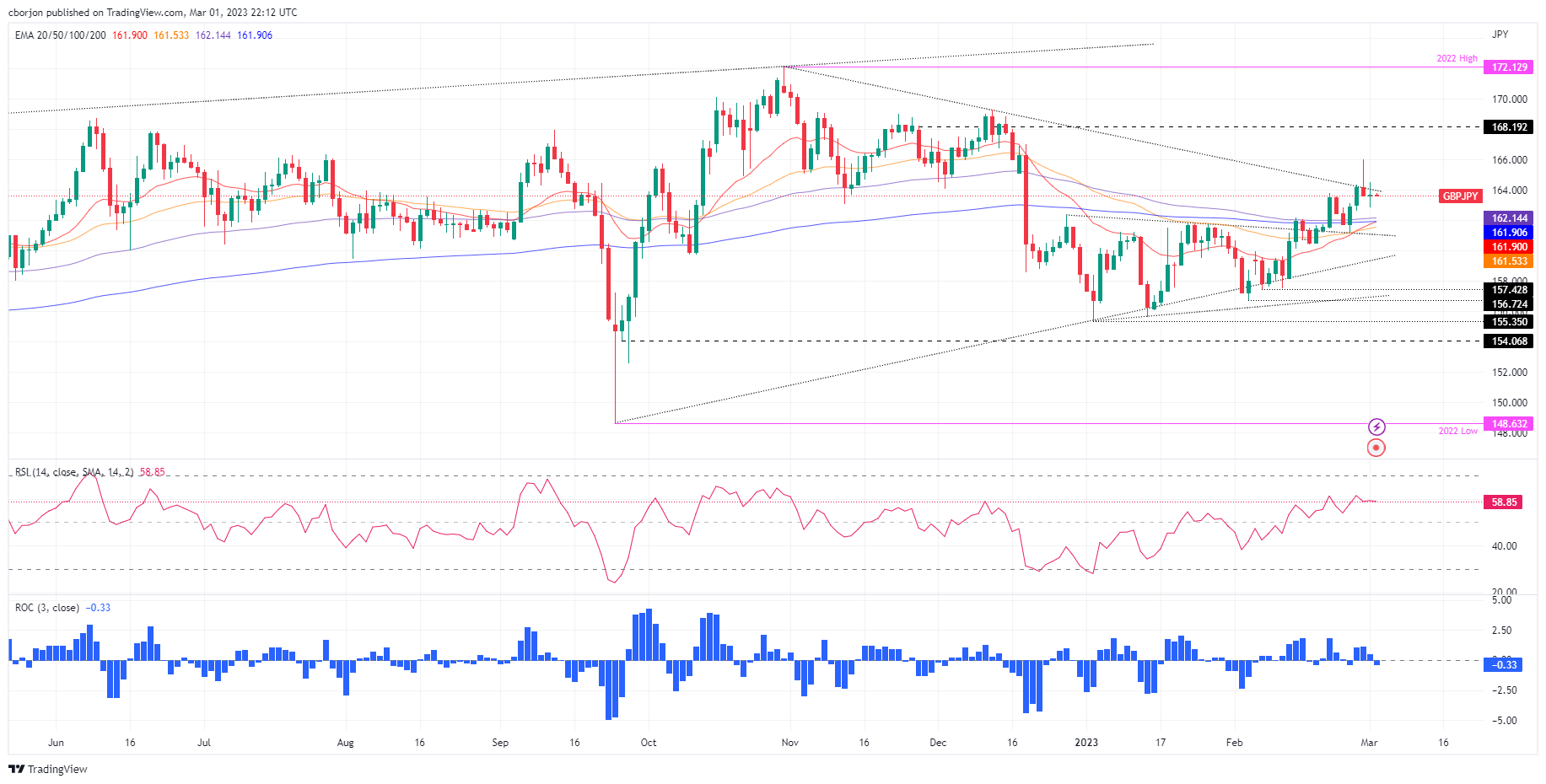
GBP/JPY Technical levels
- EUR/USD is aiming to reclaim the 1.0700 resistance as the risk-off mood has faded.
- The Fed needs not to be in a hurry to calm down the policy-tightening spell.
- A rebound in German inflation has bolstered the case of 50 bps rate hike continuation.
The EUR/USD pair has turned sideways after failing to recapture the round-level resistance of 1.0700 in the late New York session. The major currency pair is expected to recapture the aforementioned resistance as the risk-off mood has faded after hopes of recovery in China post the release of the Caixin Manufacturing PMI overshadowed the risk of a global recession.
S&P500 settled Wednesday’s session with some losses after Federal Reserve (Fed) policymakers sounded hawkish while delivering guidance on interest rates. The US Dollar Index (DXY) has retreated to near 104.00 after failing to extend recovery above 104.20, portraying mix market mood. Meanwhile, the demand for US government bonds remained extremely weak, which led to a jump in the 10-year US Treasury yields to 4%.
Atlanta Fed President Raphael Bostic expected the central bank to push the terminal rate to the 5.00%-5.25% range as the United States Consumer Price Index (CPI) is extremely sticky. Apart from that, the Fed policymaker expects the central bank to keep the elevated terminal rate stable well into 2024.
Meanwhile, the release of the US ISM Manufacturing PMI gamut claimed that the inflationary pressures have rebounded and the Fed should not be in a hurry to calm down the policy tightening spell. The Manufacturing PMI remained contracted consecutively for the fourth time amid higher rates by the Fed. The economic data landed at 47.7, lower than the consensus of 48.0.
However, the forward demand looks extremely solid as New Orders Index jumped to 47.0 from the expectations of 43.7 and the former release of 42.5.
On the Eurozone front, stronger-than-anticipated German Harmonized Index of Consumer Prices (HICP) cleared that the road towards achieving price stability for the European Central Bank (ECB) is full of troubles. The German HICP climbed to 9.3% from the estimates of 9.0% and the former release of 9.2%. ECB President Christine Lagarde has already announced that the central bank is looking to hike interest rates further by 50 bps in its March monetary policy.
- Gold price probes three-day winning streak with a retreat from one-week high.
- Softer US Dollar, China-inspired optimism favor XAU/USD buyers amid a lack of major United States data/events.
- US ISM Manufacturing PMI details, upbeat Treasury bond yields challenges Gold buyers.
Gold price (XAU/USD) retreat to $1,836, following a three-day rebound from a two-month low, as the metal buyers struggle to gain a major positive catalyst to back the latest run-up, especially amid upbeat United States data and Treasury bond yields. It’s worth noting, however, that the softer US Dollar and China-linked market optimism puts a floor under the XAU/USD price amid a lack of major data/events.
Gold price eases on United States data, yields
Gold price pares recent gains while easing from the short-term key technical hurdle surrounding $1,845 after the United States ISM Manufacturing PMI details renew inflation fears. That said, the headlines gauge rose to 47.7 from 47.4 prior, versus the 48.0 expected. However, the details were quite interesting as Prices Paid and New Orders marked the highest figures in five and four months respectively.
On the other hand, the US 10-year Treasury bond yields rose to the highest levels since early November 2022 by poking the 4.0% mark whereas the two-year counterpart rallied to the June 2007 levels by piercing the 4.90% mark. The just in the US Treasury bond yields suggest the market’s fears of inflation and recession, which in turn underpin the hopes of the US Dollar rebound and the pullback of the XAU/USD.
Amid the upbeat data and strong yields, the Minneapolis Federal Reserve (Fed) President Neel Kashkari reiterated on Wednesday that inflation in the US is still very high and that their job is to bring it down, as reported by Reuters. "Wage growth is now too high to be consistent with 2% inflation," Kashkari added and noted that it is concerning that the Federal Reserve's rate hikes so far have not brought down services inflation.
US Dollar, China challenges XAU/USD bears
Although the Gold buyers seem to fade the momentum due to the latest swing in the US data and the hawkish Federal Reserve talks, not to forget upbeat yields, the XAU/USD sellers are off the table as the US Dollar remains weak and China flashes signs of a rebound.
That said, the US Dollar Index (DXY) began March on a back foot after posting the biggest monthly gain since September 2022, with a daily loss of nearly half a percent while poking the 104.40 level at the latest.
Elsewhere, strong prints of China’s Caixin and NBS Manufacturing PMIs for February join the Non-Manufacturing PMI for the said month to mark an upbeat economic rebound in the world’s biggest industrial player. Following the data, China Finance Minister Liu He showed readiness to bolster the nation’s fiscal spending while also mentioning that the foundation of China's economic recovery is still not stable.
Moving on, the Gold price may witness further consolidation of the recent gains amid a light economic calendar in the United States. However, scheduled readings of the Eurozone inflation data and risk catalysts surrounding China and Russia may keep entertaining the XAU/USD traders.
Gold price technical analysis
Gold price struggles to justify the previous day’s descending channel breakout as it retreats from the 61.8% Fibonacci retracement level of its up-move from December 2022 to February 2023, as well as the 100-bar Simple Moving Average (SMA).
The pullback move also gained support from the Relative Strength Index (RSI) line, placed at 14, as it hit the overbought territory.
Hence, a pullback towards the previous resistance line of a one-month-old bearish channel’s top line, close to $1,821 appears imminent.
However, bullish signals from the Moving Average Convergence and Divergence (MACD) indicator and multiple supports around $1,800 and $1,780 challenge the XAU/USD past $1,821.
Meanwhile, a convergence of the 100-SMA and the 61.8% Fibonacci retracement, also known as the “Golden Fibonacci ratio”, around $1,842-45, restrict the immediate run-up of the Gold price.
Following that, the 200-SMA hurdle of $1,880 appears the last defense of the Gold bears.
Hence, Gold price is likely to decline further but the downside room seems limited.
Gold price: Four-hour chart
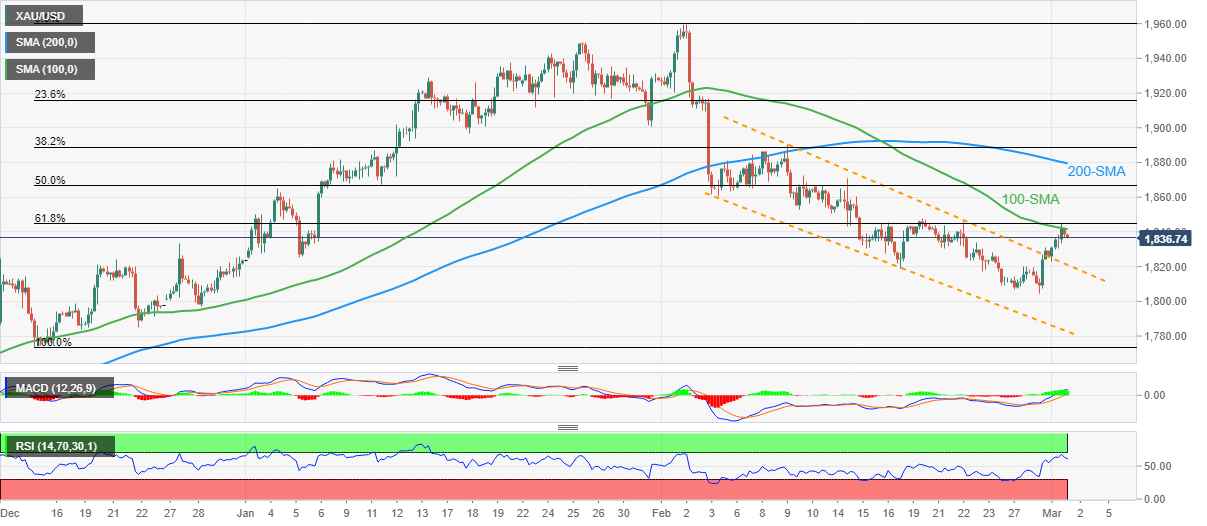
Trend: Pullback expected
- USD/CAD retreats from daily and weekly highs as the Asian session is about to begin.
- Despite dipping, oscillators remain bullish, meaning that further USD/CAD upside is expected.
- USD/CAD Price Analysis: Bullish reclaiming of 1.3600 could trigger a rally towards 1.3800.
The USD/CAD tumbled from weekly highs around 1.3658, dropping nearly 0.40%, as Wall Street closed with losses, while the greenback remained offered throughout the session. US economic data was mixed, though a subcomponent of the ISM Manufacturing PMI report for February sparked inflation fears in the United States (US). At the time of writing, the USD/CAD exchanges hands at 1.3594.
USD/CAD Price action
The USD/CAD is upward biased despite dipping below 1.3600, in a fall sponsored by overall US Dollar weakness. Technically speaking, the USD/CAD pair’s failure to print a lower low than Tuesday’s 1.3560 kept the uptrend intact, even though the Relative Strength Index (RSI) shifted downwards.
For a bearish continuation, USD/CAD sellers must achieve a daily close below 1.3560. Once that is achieved, the USD/CAD next support would be the January 19 daily high turned support at 1.3520, ahead of testing the 1.3500 psychological level.
On the other hand, and in the most likely scenario, the USD/CAD first resistance would be the 1.3600 psychological level. A breach of the latter will expose the year-to-date (YTD) high at 1.3665, followed by the 1.3700 figure, and then the November 3 daily high at 1.3808.
USD/CAD Daily chat
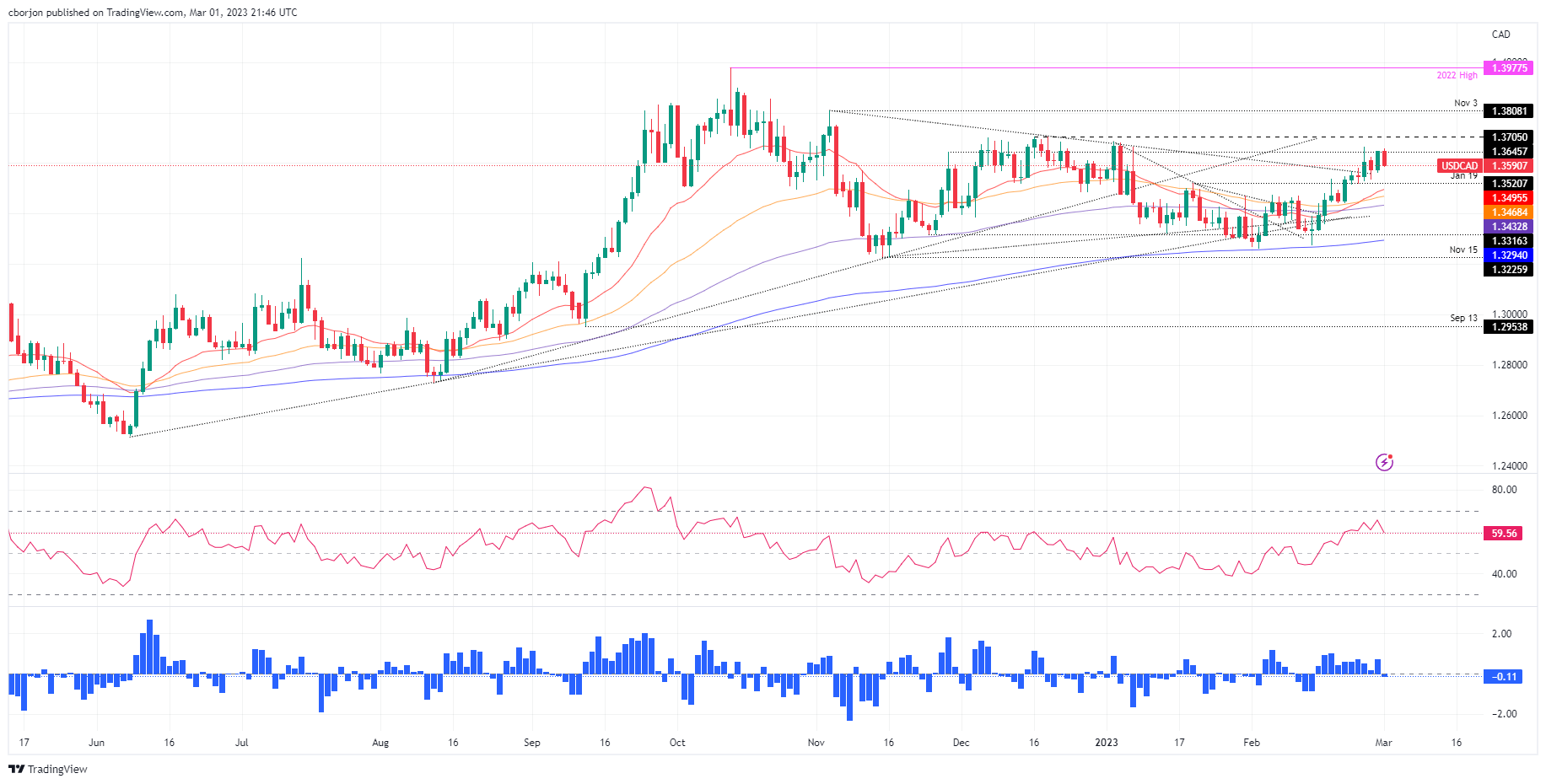
USD/CAD Technical levels
- USD/JPY shorts are in the market but need to break 135.20.
- USD/JPY bears eye a break of 135.20 to open the risk of a move to 134.00.
USD/JPY could be setting itself up for a fade on rallies to break trendline support. The following illustrates a bearish bias given the week's template so far.
USD/JPY technical analysis
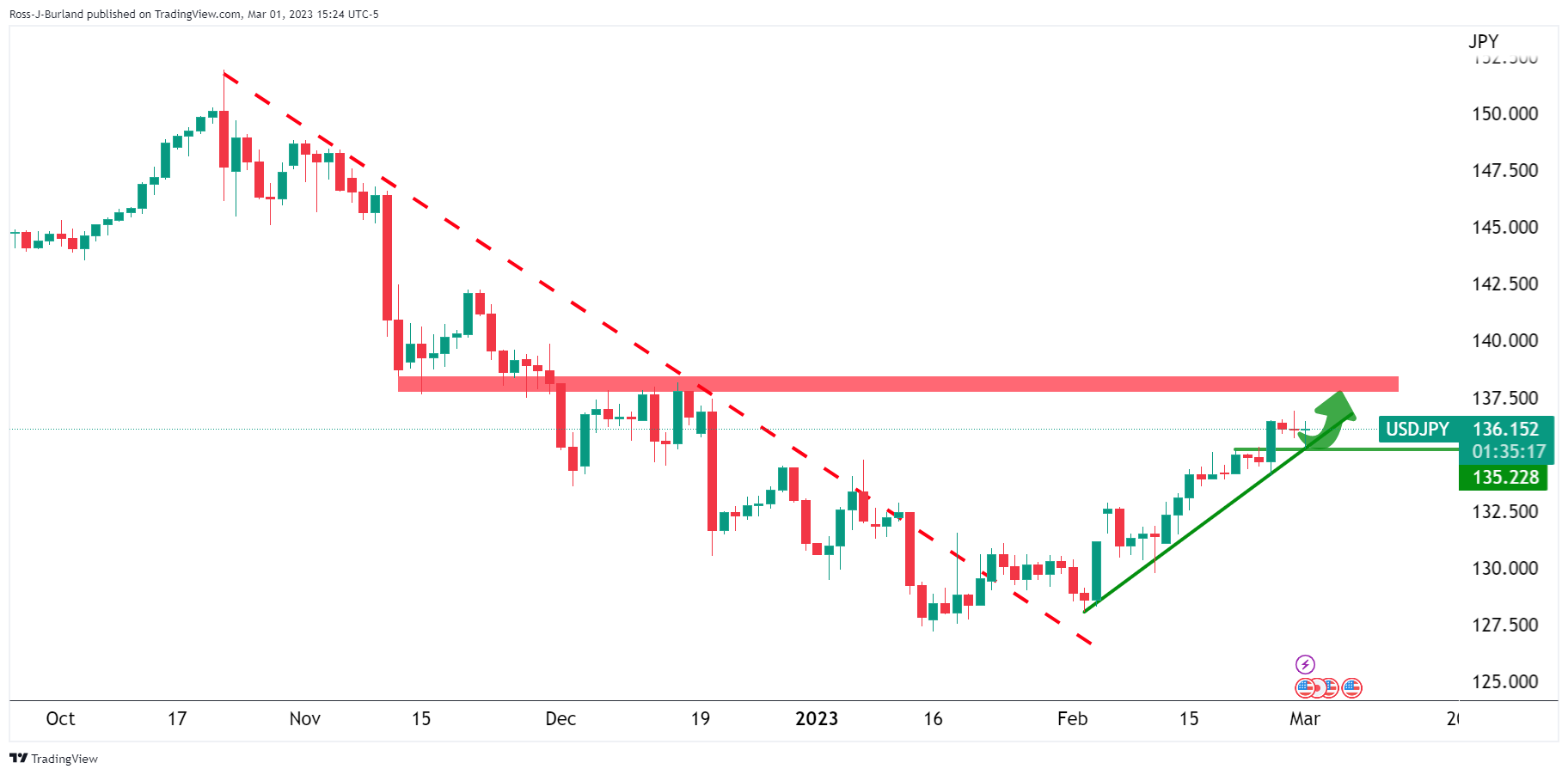
On the face of it, things would appear bullish given the trendline and holding above the 135.20s horizontal support that guards 134.05 below it.
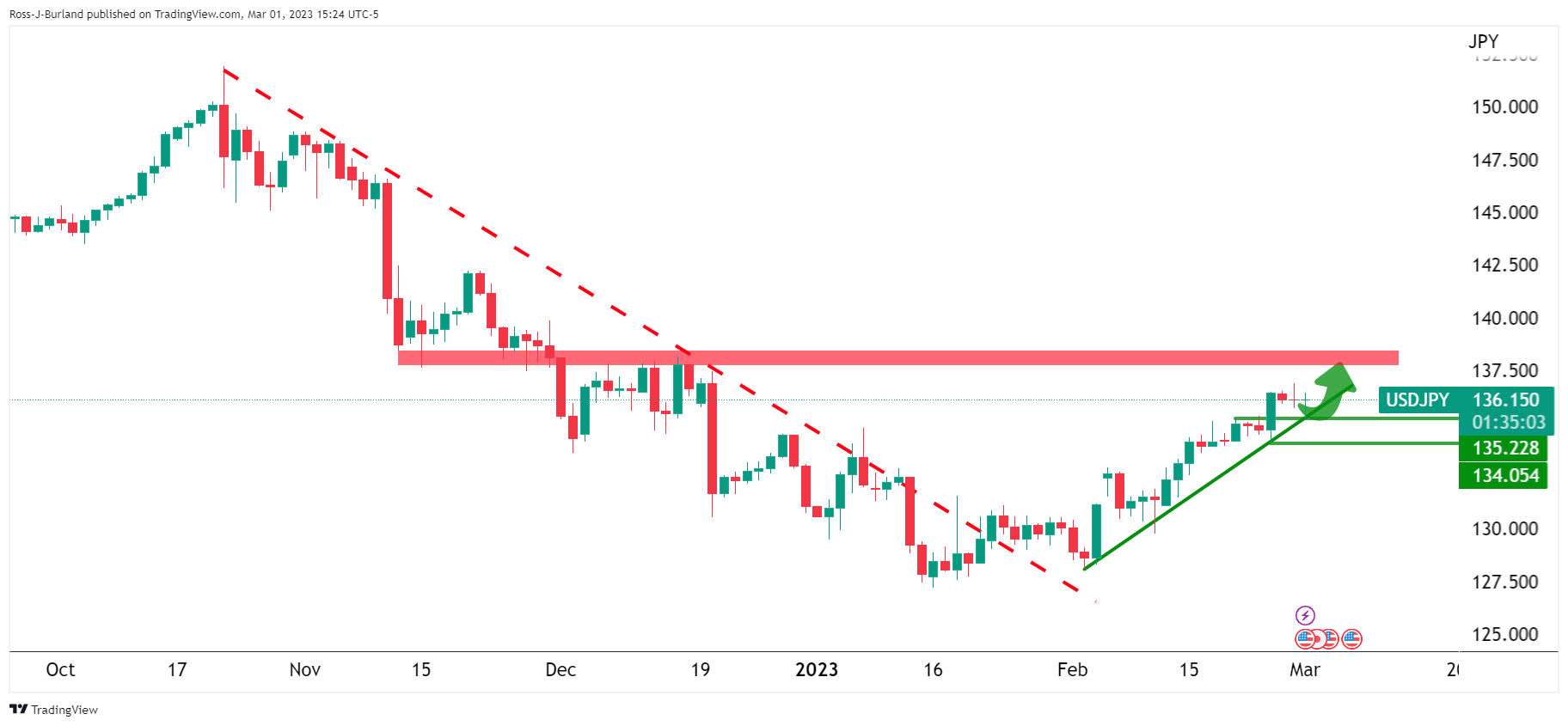
However, when zooming down to the week's template so far, we can see a failed break out on Tuesday that was followed up by shorts on Wednesday and breaking structure around 135.70/90:
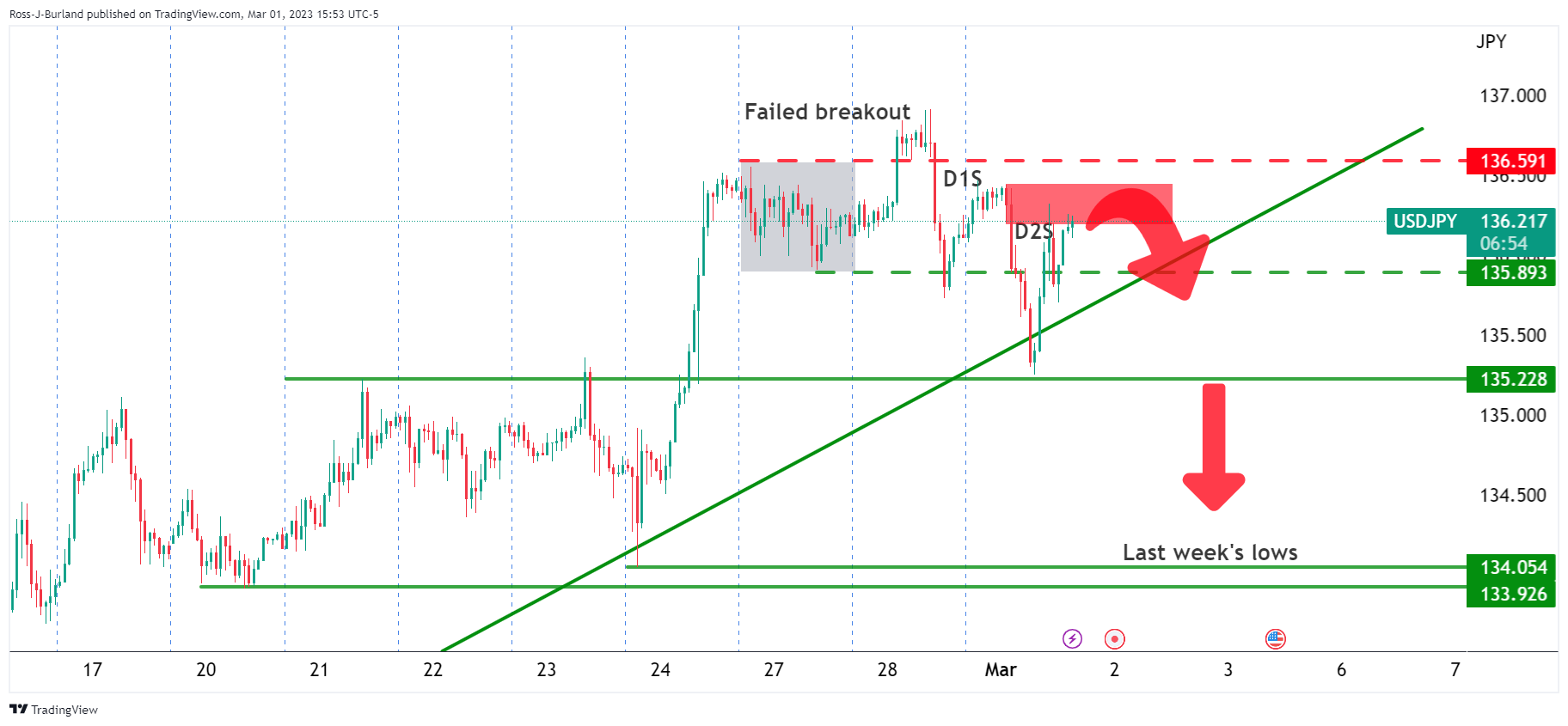
We have Day 1 shorts (D1S) and Day 2 Shorts in the market which is building the case for a significant move lower. The thesis is that bears are lurking up high and will be looking to sell at a premium, fading any rallies in the high-volume sessions such as in London and US. A break of 135.20 opens the risk of a move to 134.00 for the near future for a test of last week's lows.
- NZD/USD was the strongest peer in the FX space and rallied more than 1%.
- US manufacturing activity stabilized, but input prices rose, sparking inflation concerns.
- NZD/USD Price Analysis: Will test solid resistance around 0.6280-0.6300, with daily Mas hoovering around the area.
Despite sentiment shifting sour, the NZD/USD rallies and stays firm above the 0.6250 area, bolstered by a softer greenback, albeit UST bond yields are rising sharply. US equities are pointing toward registering losses, which could weigh on risk-sensitive currencies at the beginning of the Asian session. At the time of writing, the NZD/USD is gaining 1.16% or 71 pips.
NZD/USD continued its uptrend on a soft US Dollar
Wall Street is set for a lower close. The Institute for Supply Management (ISM) reported that the February US Manufacturing Purchasing Managers’ Index (PMI) was 47.7, lower than the estimated value of 48. Although it seems to have stabilized compared to the previous month’s reading of 47.4., the prices subcomponent increased significantly, causing concerns about inflation among investors.
That augmented speculations that the Federal Reserve would continue tightening monetary conditions as traders pushed back rate cuts, as the CME FedWatch Tool reported.
The NZD/USD trimmed some of its earlier gains on the ISM release and dipped toward 0.6222, before resuming the uptrend, despite hawkish comments by Federal Reserve officials.
Neil Kashkari of the Minnesota Fed commented that he’s open to raising rates by 25 or 50 bps at the upcoming meeting, while he foresees rates peaking around 5.4%. Of late, Atlanta’s Fed President Raphael Bostic commented that rates need to go as high as 5% - 5.25% and stood there “well into 2024.”
On the New Zealand (NZ) docket, the lack of data kept investors leaning on US Dollar dynamics and expectations that the Reserve Bank of New Zealand (RBNZ) is expected to raise rates in April, with odds for a 50 bps standing at 51%, per money market futures.
NZD/USD Technical analysis
The NZD/USD is neutral to upward biased, even though it sits below the daily Exponential Moving Averages (EMAs). However, at the time of typing, it faces solid resistance with the 50 and 200-day EMAs, at 0.6293 and 0.6282, respectively. If the NZD/USD cracks the 200-day EMA, that will exacerbate a rally above the 0.6300 mark. Otherwise, failure to do it would pave the way for further downside.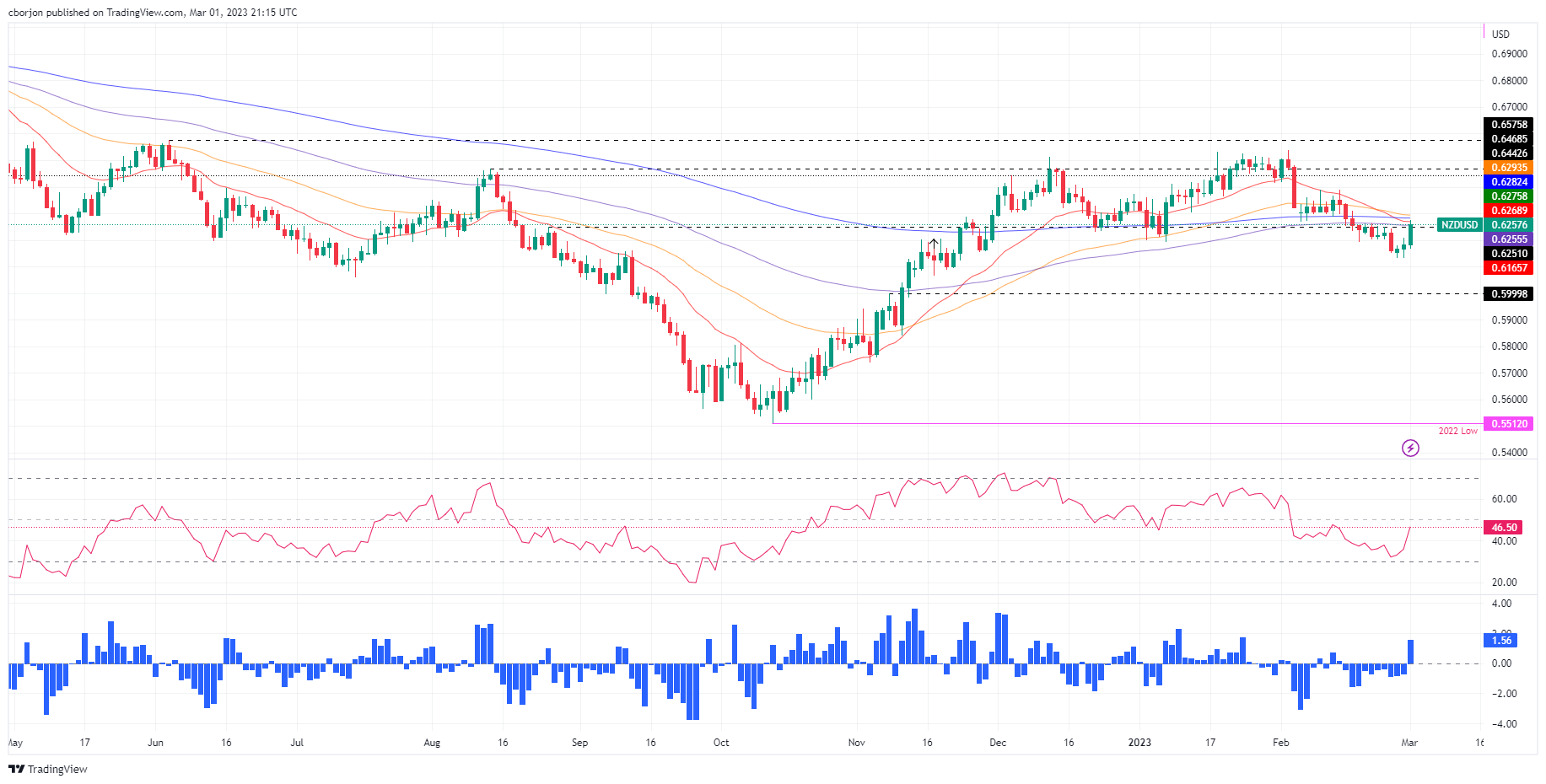
Trend: Neutral upwards.
What to watch?
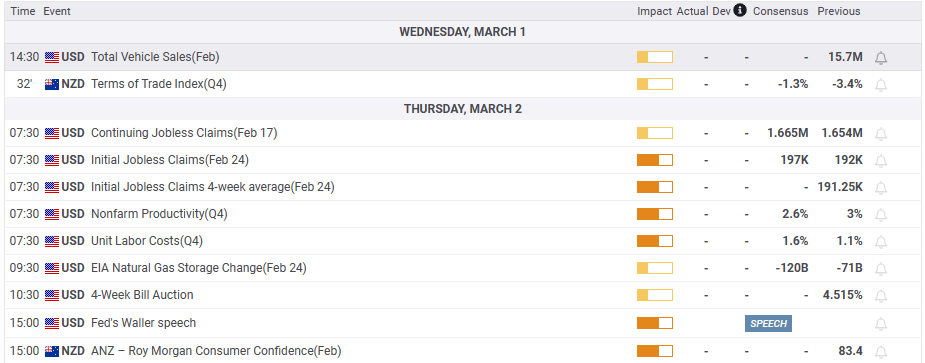
What you need to take care of on Thursday, March 2:
The US Dollar dropped across the board on Wednesday, even as US yields jumped. Most European stock markets posted losses, and in Wall Street, indexes were mixed. The market hit bottom after the release of the US ISM Manufacturing PMI but then recovered.
The February Index rose to 47.7, showing the sector remains in contraction territory. The surprise came from the Price Paid Index, which jumped 6.8 points to 51.3 and triggered a sell-off in Treasuries and a short-lived recovery of the US Dollar. Currencies reflected somewhat more optimism than equities. Chinese PMIs rose above 50, leading to hopes for the economic outlook.
Market participants will continue to look closely at the bond market after a day in which US and European bond yields jumped after inflation figures. The economic calendar shows for Thursday Eurozone CPI, European Central Bank minutes and US Initial Jobless Claims.
The Euro was among the top performers across the FX board, boosted by higher-than-expected German inflation numbers and hawkish ECB expectations. EUR/USD hit weekly highs near 1.0700 and then pulled back. The Pound lagged with GBP/USD testing levels under 1.2000. USD/JPY ended flat on Wednesday despite higher government bond yields.
AUD/USD rebounded from monthly lows, being able to defend the 0.6700 support. The Kiwi was the best performer on Wednesday, with NZD/USD hitting the highest level in two weeks at 0.6275. USD/CAD dropped modestly and is hovering around 1.3600.
Gold rose for the second day in a row despite higher yields, finding resistance at $1,845/oz. Bitcoin was unable to regain $24,000 and pulled back.
Like this article? Help us with some feedback by answering this survey:
- US Dollar is under pressure in risk-on markets.
- Euro rallies to a one-week high and China is bouncing back.
The US Dollar is broadly weaker to kick off March after posting a 3% gain for February while risk appetite roared back to life on the evidence of a stronger-than-expected recovery in the Chinese economy.
At the time of writing, DXY, an index that measures the greenback vs. a basket of currencies, is losing 0.36% after falling from a high of 105.09 and reaching a low of 104.09 on the day so far, backing down from its first monthly gain after a four-month losing streak.
A bunch of strong U.S. economic data in recent weeks has raised market expectations that the Federal Reserve has further to go in hiking rates. Futures pricing continues to edge higher, with a peak rate climbing on Wednesday to 5.45% in the fed funds by September. However, China's Non-manufacturing activity grew at a faster pace in February, while the Caixin/S&P Global manufacturing PMI reading for last month likewise surpassed. The offshore yuan jumped 1.3% to 6.8683 per dollar, set for its largest one-day gain since late November.
The US Dollar has also struggled to hold up vs. the Pound and Euro. For instance, the pound surged 1% at the start of the week after Britain struck a post-Brexit Northern Ireland trade deal with the European Union. However, the euro, which is the majority of the basket in the DXY, is firmer due to the latest German inflation data exceeding expectations, supporting the case for the European Central Bank to raise interest rates further. The data comes ahead of key eurozone inflation data on Thursday while the Single Currency rises to a one-week high of 1.0691.
- GBP/USD bears are in town and eye a move towards last week's lows.
- Failed breakout to the upside for the week leaves a bearish bias on the charts.
GBP/USD shorts are in the market. Still, the price moved up marginally at times due to a weaker US Dollar on Wednesday, trimming gains made earlier in the session on the back of the Bank of England Governor Andrew Bailey who said there are still no decisions on the terms of whether interest rates would need to rise again.
Nevertheless, the downside bias is playing out as the following technical analysis shows:
GBP/USD daily chart

The bulls have run into a trendline resistance on the daily chart and rallies have ended with lower peaks in the process forming a bearish bias for the foreseeable future.
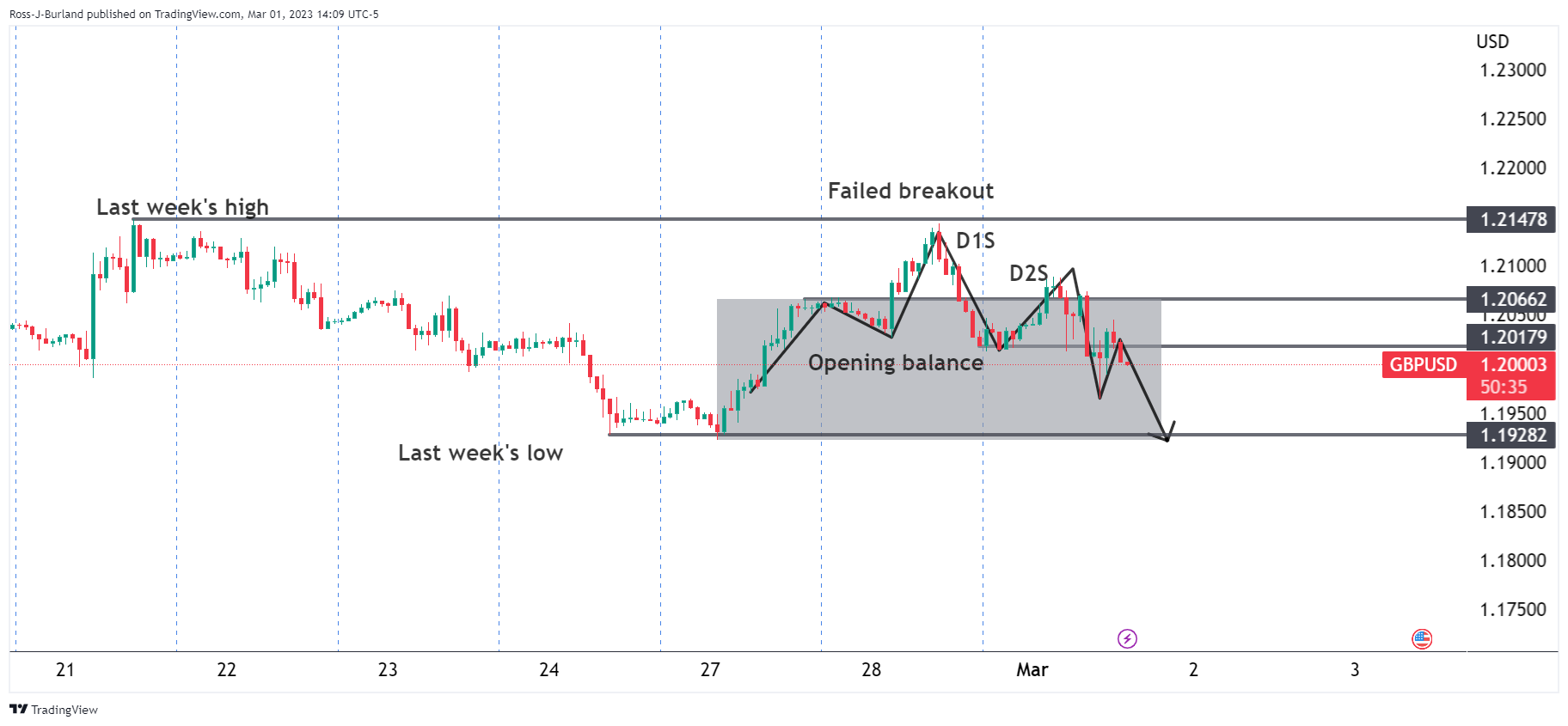
The topping pattern is more evident o the lower time frames with the head and shoulders engulfing the opening balance range for the week so far. There has been a failed breakout at last week's highs which tips the balance in favour of the sorts that came in at D1S, (Day 1 Shorts) on Tuesday. We are seeing D2S on Wednesday as the price breaks the prior day's lows and a bearish close could offer a sell-high opportunity on Thursday:
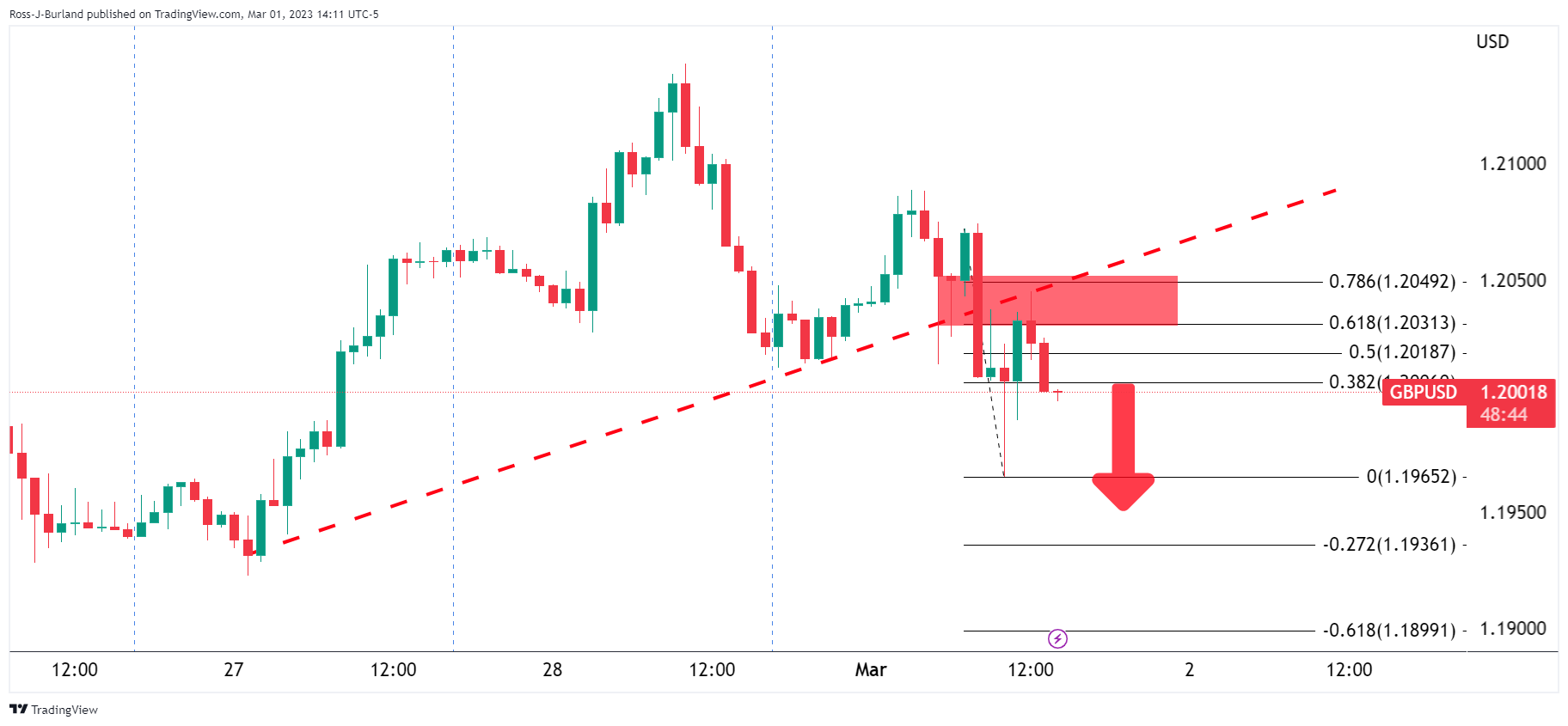
Zooming in on the head and shoulders pattern, the bears are in play and resisted in the 1.2050s and eye last week's lows.
- Silver price holds to its earlier gains but remains at risk, of closing the session below $21.00 a troy ounce.
- US ISM Manufacturing PMI missed estimates, though it showed some improvement.
- Federal Reserve officials emphasized the need to raise rates to the 5.25% - 5.50% area.
Silver price advances in the North American session after finding resistance above the $21.00 area, though it clings to gains of 0.33%. Bolstered by a softer US Dollar (USD) after United States (US) data missed estimates, the white metal is extending its gains for two straight days. At the time of writing, the XAG/USD trades at around $20.90s.
US manufacturing activity improved, but higher input prices overshadowed the data
Sentiment shifted sour on US manufacturing data. The ISM revealed February’s Manufacturing PMI came at 47.7, below estimates of 48, though it appeared to stabilize, with the prior’s month reading at 47.4. However, the prices subcomponent jumped, reigniting inflation worries amongst investors, as witnessed by US money market futures, with traders expecting rates to climb as high as 5.50%, with no rate cuts in 2023.
A knee-jerk reaction tumbled the XAG/USD from $21.11 to $20.89 a troy ounce. However, Silver’s fall was capped by the US Dollar, which continued to weaken through the US session.
Earlier, Federal Reserve officials crossed newswires and continued their hawkish rhetoric. Minnesota’s Fed President Neil Kashkari (voter) said interest rates should reach 5.4% in December and stay at that level. He also mentioned that he would consider increasing rates by either 25 or 50 basis points during the upcoming Fed meeting.
Later, Atlanta’s Fed President Raphael Bostic commented that rates need to go as high as 5% - 5.25% and stood there “well into 2024.”
The Fed’s hawkish rhetoric did not help the greenback, which, by the US Dollar Index, is down 0.46% at 104.471. Contrarily, the US 10-year Treasury bond yield is advancing seven basis points, eyeing a break above the 4% threshold, a headwind for precious metals prices.
XAG/USD Technical analysis
Silver’s daily chart portrays XAG/USD as downward biased. The bearish case is further cemented by crossing the 20-day EMA below the 200-day EMA, which could exacerbate a test of the YTD low at around $20.43. XAG/USD’s recovery in the last couple of days is sponsored by a technical signal, with the Relative Strength Index (RSI) exiting from oversold conditions, which triggered a buy signal. Failure to extend its gains above $21.00 could pave the way for further downside.
The XAG/USD first support would be the February 27 daily low of $20.56, which, once cleared, it could pave the way to the YTD low at $20.43. On the other hand, if Silver stays afloat above $21.00, the XAG/USD could test the February 24 high at $21.39.
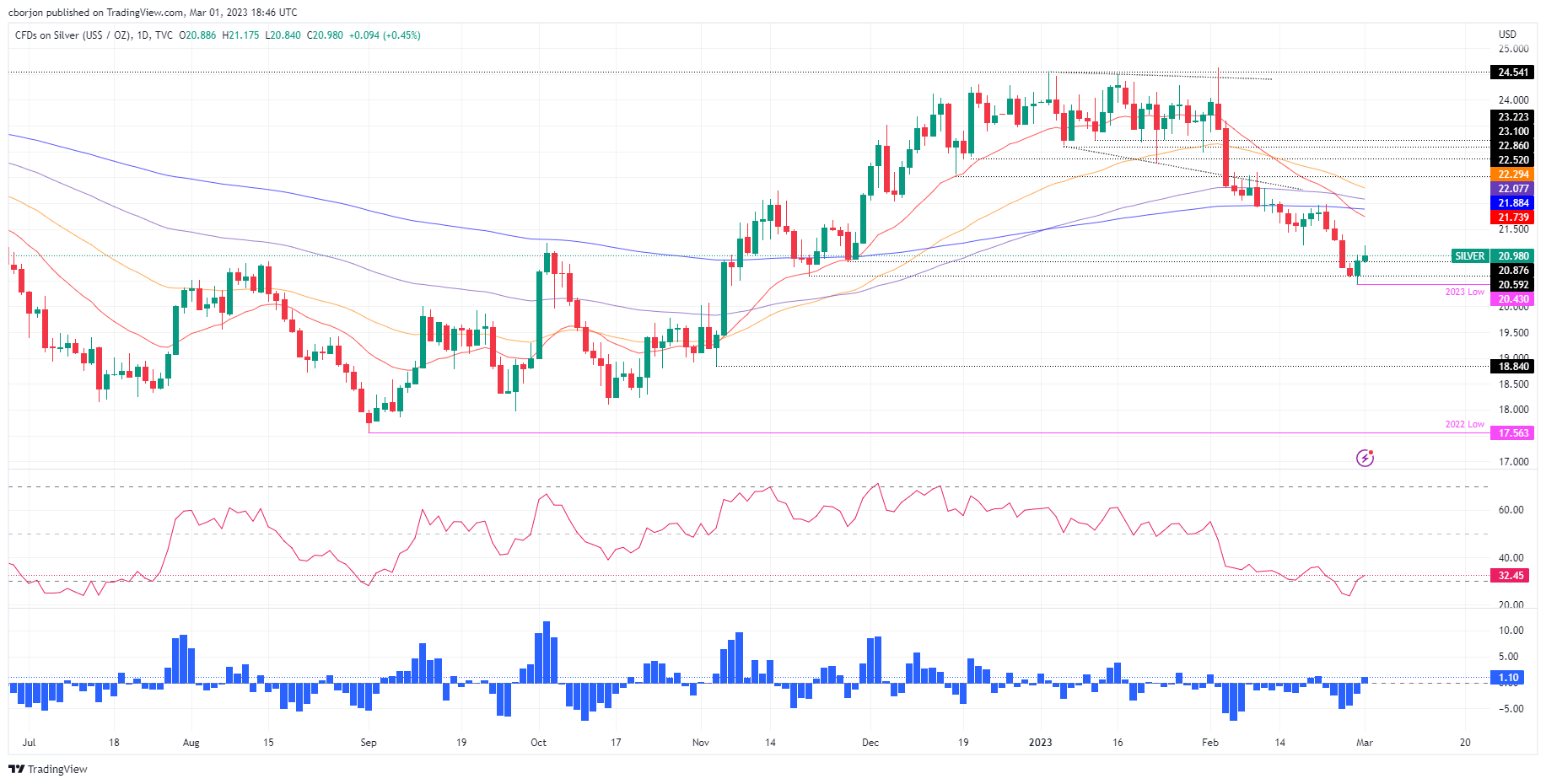
What to watch?
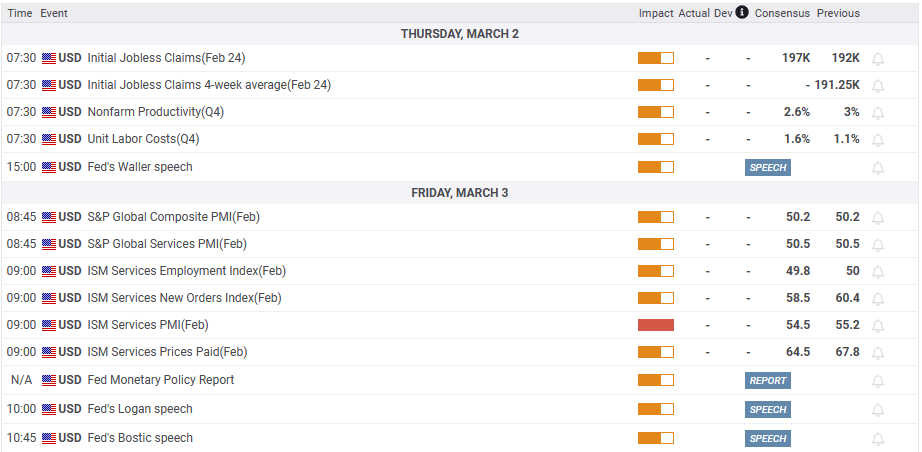
- AUD/USD rallies towards trendline resistance.
- Bears could be lurking in the 0.68s as W-formation is a pull.
AUD/USD bulls were thrown a lifeline in Asia following Chinese data that surprised in a big way to the upside, following a disappointment in local data from Australia that would have otherwise tipped the bias to the bears for the foreseeable future.
The following illustrates the potential from here for the price to continue higher for the foreseeable future but also notes that there could be a pull in gravity due to the daily chart's W-formation.
In prior analysis, it was noted that AUD/USD had reached toward a 50% mean reversion area and had been starting to come under pressure. However, it was also noted that this was not to say that the correction is on the way out. Instead, it could have been building up into a geometrical pattern:

A target of the 78.6% Fibonacci higher up near 0.6800 would align with the daily trendline resistance as follows:
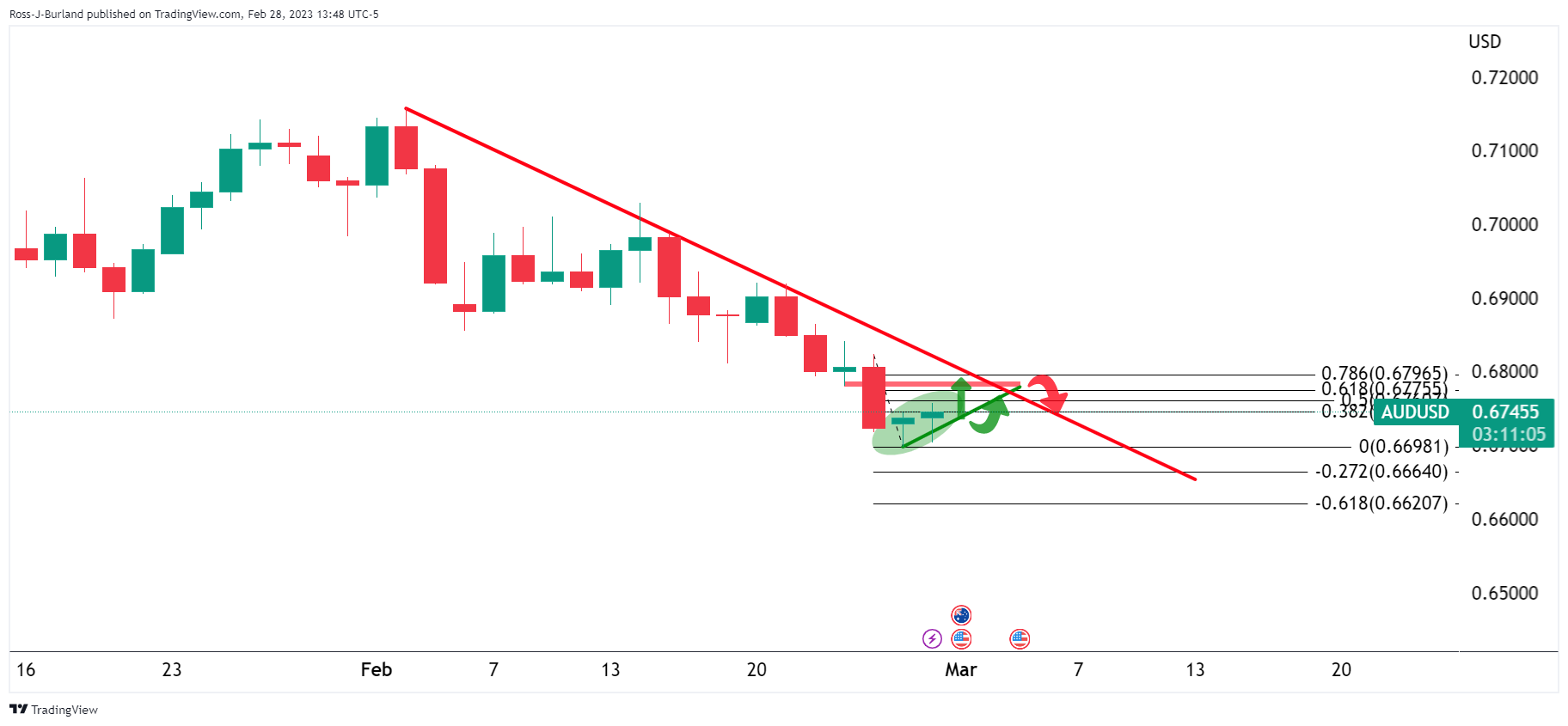
However, the cracks started to come through in Asia: Aussie data dump crashes AUD/USD
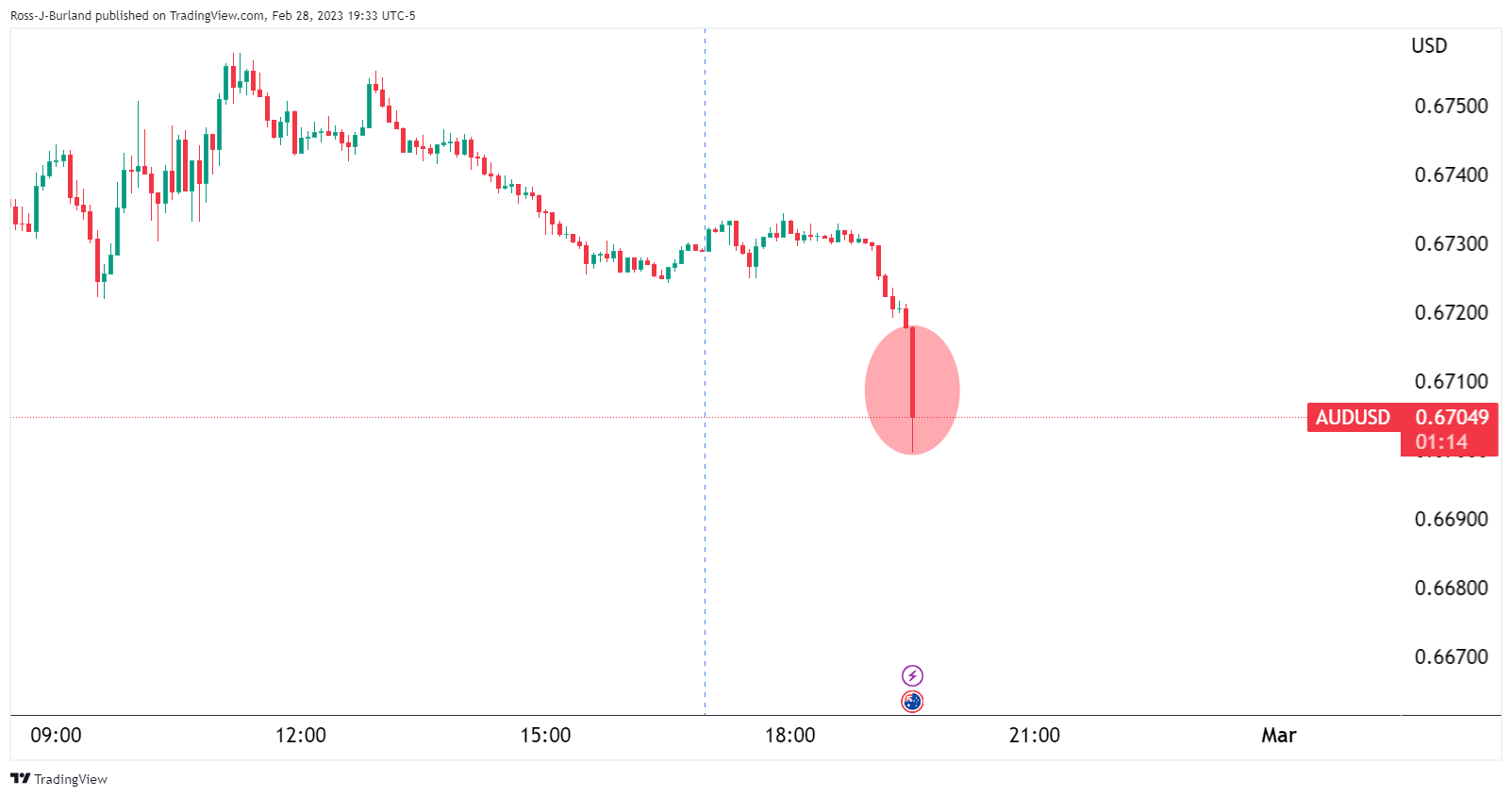
AUD/USD had broken a trendline support, invalidating a thesis for a stronger correction (in the meantime), resisted by the 50% mean reversion of the prior bearish impulse:
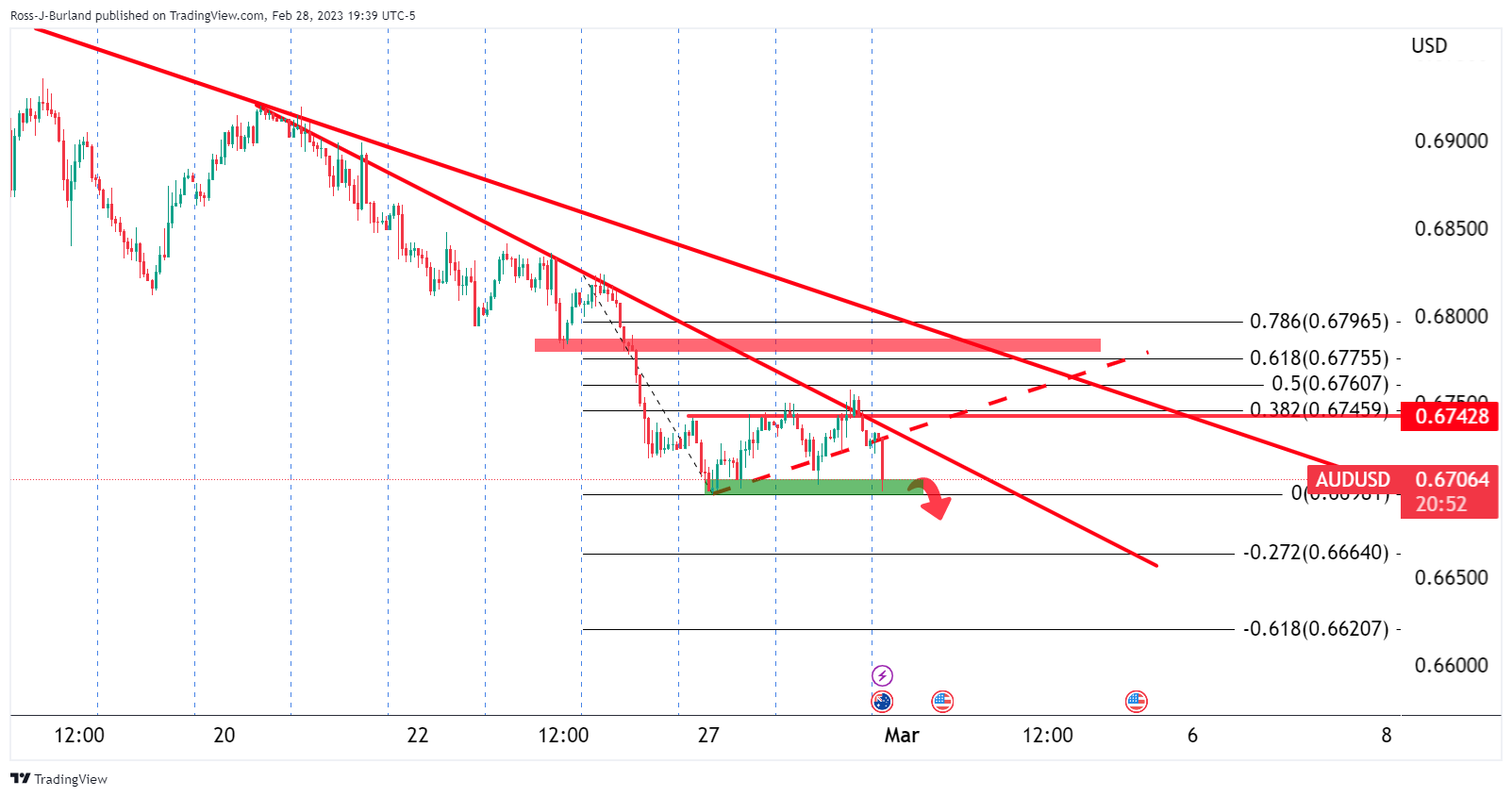
It was stated that the data would be expected to continue to weigh on the Aussie as aggressive monetary tightening is likely cooling the economy and therefore casting a move dovish sentiment over the Reserve Bank of Australia.
However, along came Chinese data to the rescue, throwing the bulls a much-needed lifeline:
China NBS Manufacturing / Non-manufacturing PMIs beats are a welcome surprise for AUD bulls
We have seen a significant recovery in AUD/USD as follows:
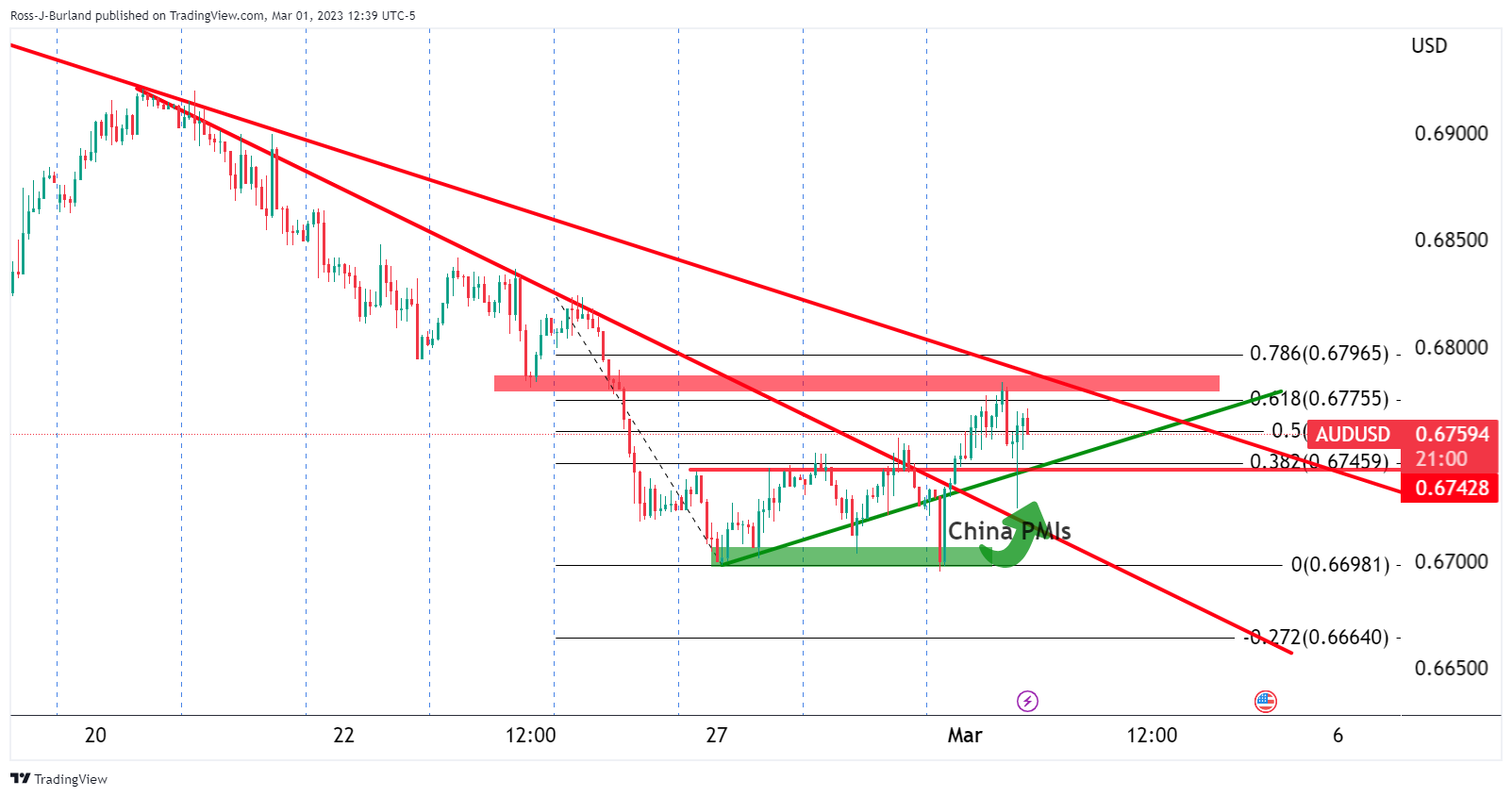
This puts 0.6800 back on the map.
However, from a daily chart standpoint, the trendline resistance is a roadblock for higher:
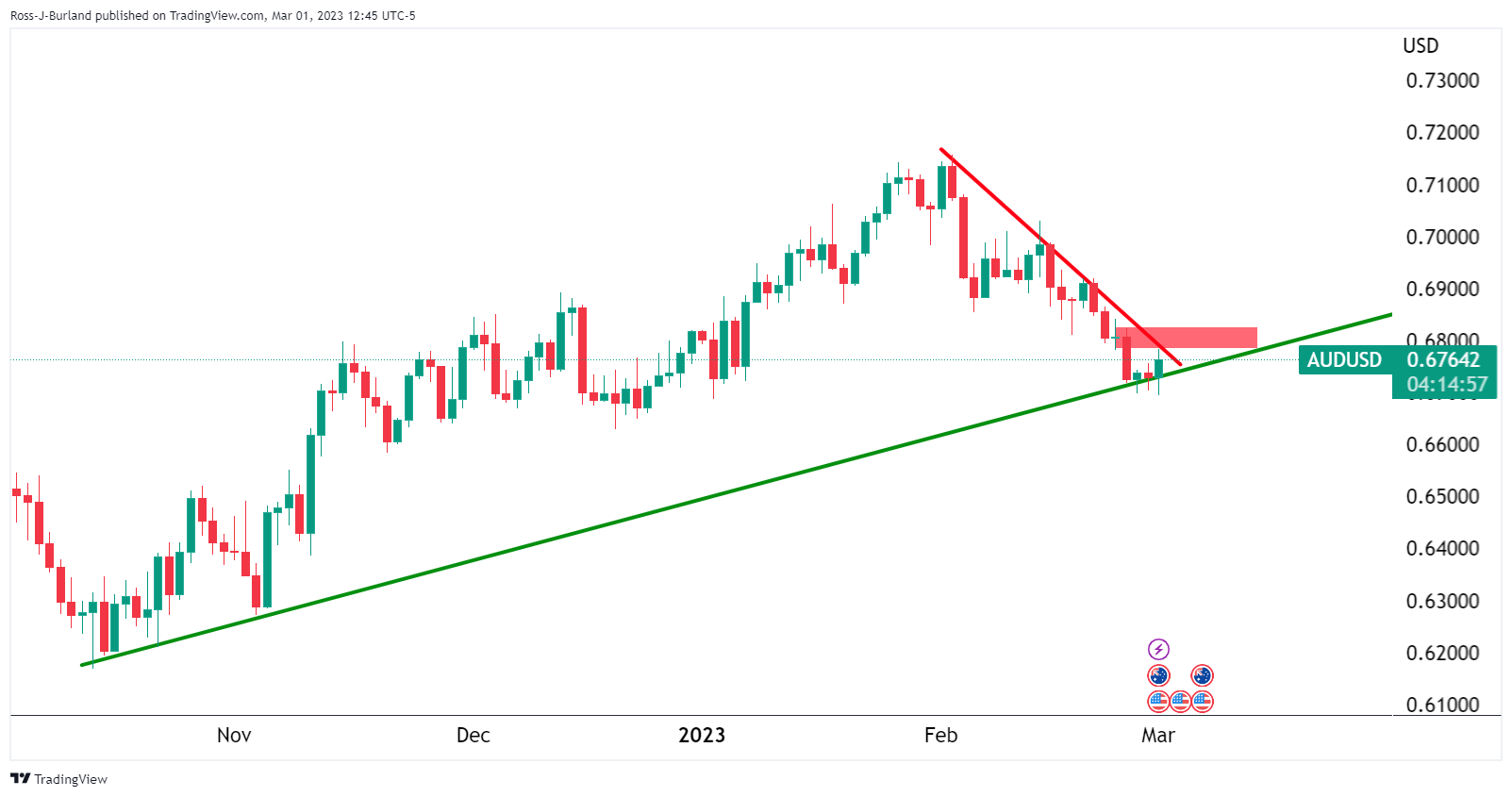
Coupled with the W-formation, there could be a weight of gravity on the bulls for the foreseeable future:
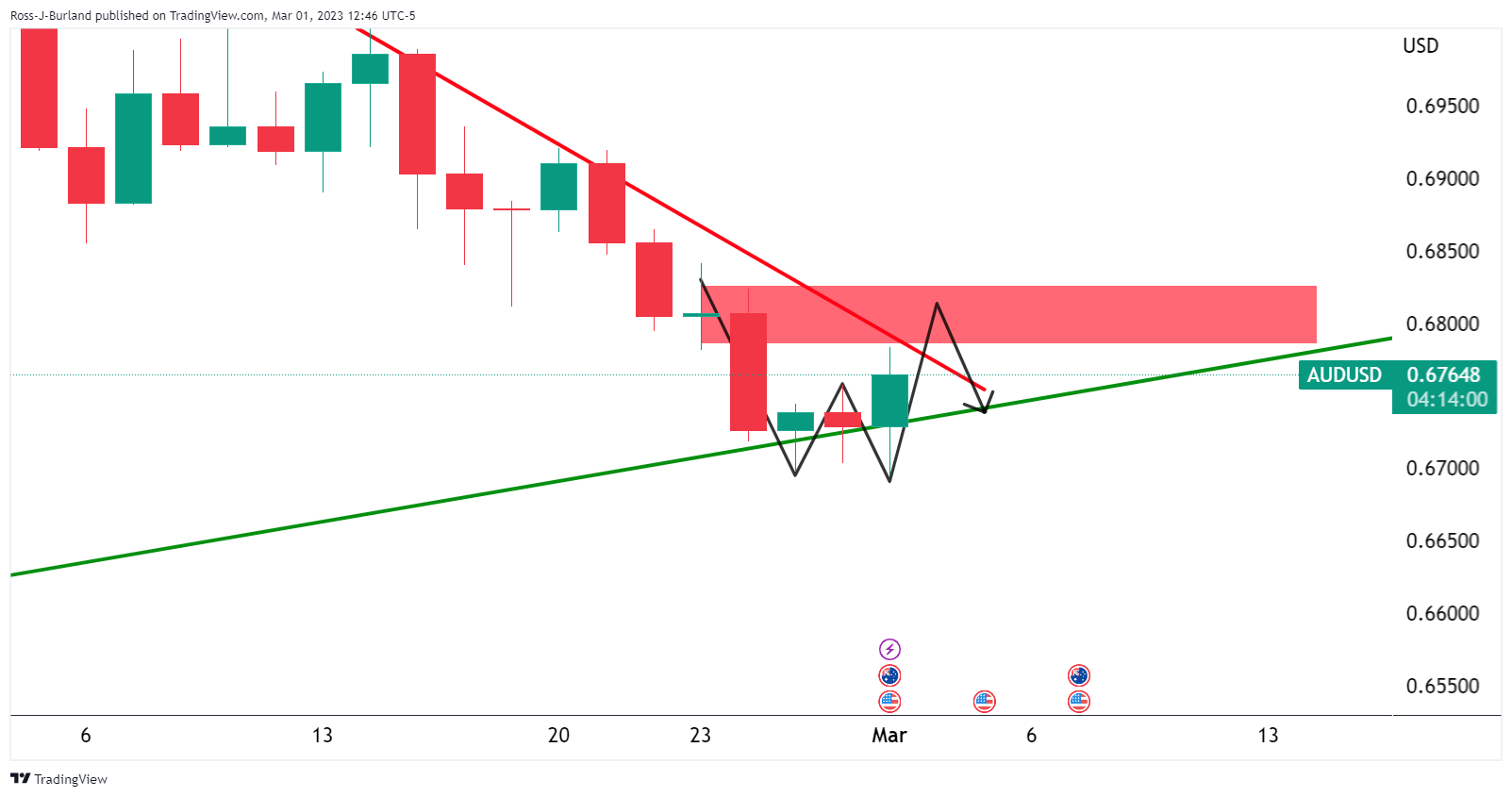
- USD/CHF is trapped within the 0.9340-0.9425 region for the fourth straight day.
- USD/CHF Price Analysis: Negative divergence in the 4-hour chart opened the door for further losses.
The USD/CHF is trimming some of Tuesday’s gains, dropping slightly above the 100-day Exponential Moving Average (EMA), which sits at 0.9384, after hitting a daily high of 0.9428. At the time of writing, the USD/CHF exchanges hands at 0.9387, below its opening price by 0.36%.
USD/CHF Price action
Since the start of the week, the USD/CHF remains range-bound within the 0.9340-0.9425 area. The Relative Strength Index (RSI) portrays buyers in charge, but its slope turned south, suggesting pressure is waning.
The USD/CHF 4-hour chart paints a different picture. As price action edged up, the RSI reached lower peaks. That means a negative divergence has formed, which usually anticipates a reversal. However, the USD/CHF would face solid support levels, as the EMAs are resting below the spot price.
Therefore, the USD/CHF first support would be the 20-EMA at 0.9374. A breach of the latter will expose the weekly low of 0.9341, followed by the 50-EMA at 0.9335, ahead of testing the 0.9300 mark. Once cleared, the next stop for USD/CHF sellers would be the 100-EMA at 0.9295, closely followed by the 200-EMA at 0.9278.
USD/CHF 4-hour chart
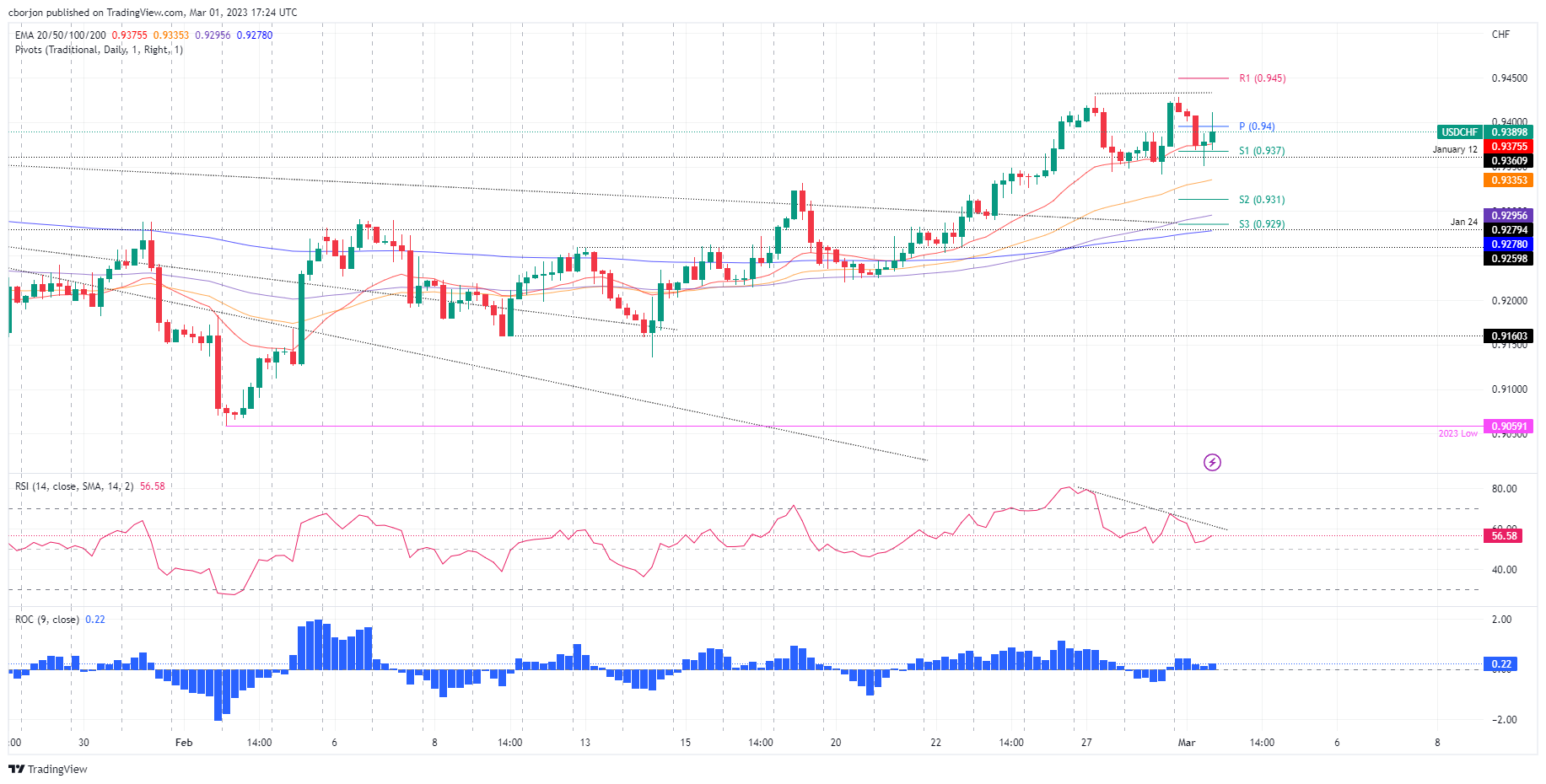
USD/CHF Key technical levels
- USD/JPY failed to gain traction, despite rising US Treasury bond yields.
- Federal Reserve officials are still expecting rates at around 5.25%, according to December’s 2022 dot-plots.
- Manufacturing activity in the United States remains depressed, though a jump in input prices keeps traders worried about further Fed tightening.
The USD/JPY remains pressured, though capped by recent US economic data, as the US ISM Manufacturing PMI for February fell short of estimates. However, some subcomponents show that again prices are rising. The USD/JPY is exchanging hands at 136.08.
USD/JPY continues to consolidate after mixed US ISM Manufacturing PMI
US equities are trading mixed after the release of the ISM. The reading came at 47.7, below estimates of 48 for February, meaning that factories still feel the impact of the Federal Reserve’s (Fed) aggression. Delving into the report, the Prices Index rose to 51.3, past the 45.1 estimates, spurring a knee-jerk reaction in the US Dollar Index (DXY), and the USD/JPY spiked to 136.31.
Lately, investors have turned less optimistic about inflation in the United States (US). Money market futures are pricing the Federal Funds Rate (FFR) at around 5.25% -5.50% by June 2023, and no rate cuts throughout the year.
Earlier, S&P Global Manufacturing PMI for the US came shorter than the prior’s month data, at 47.3 vs. 47.8, a prelude of what was coming, later with data released by the ISM.
Federal Reserve officials insist on their hawkish rhetoric led by Neil Kashkari, President of the Federal Reserve Bank of Minneapolis. He said interest rates should reach 5.4% in December and stay at that level. He also mentioned that he would consider increasing rates by either 25 or 50 basis points during the upcoming Fed meeting and added that the dangers associated with not tightening monetary policy are greater than those of tightening it too much.
Contrarily, Atlanta’s Fed President Raphael Bostic believed that rates need to go as high as 5% - 5.25% and stood there “well into 2024.” He added that the economy has the momentum to support higher rates without a major downturn.
Despite the hawkishness provided by Kashkari, the USD/JPY failed to edge higher. Additionally, rising UST yields, like the 10-year benchmark note rate, approach the 4% threshold, but sentiment keeps USD/JPY traders on the sidelines, waiting for additional US economic data.
USD/JPY Technical analysis
The USD/JPY daily chart shows the major consolidating at around 136.00. Back-to-back doji’s in the daily time frame suggest that buyers and sellers are at equilibrium. The Relative Strength Index (RSI) is almost flat but nearby overbought conditions, while the Rate of Change (RoC) indicates sellers are gathering momentum.
For a bullish resumption, the USD/JPY must clear the YTD high of 136.91, so the pair might test 138.00. Otherwise, a fall below 135.25 would pave the way toward 135.00.

What to watch?

Gold Price has managed to stay above its 200-Day Moving Average (DMA). This level stands at $1,775 and is expected to floor the bright metal, strategists at Credit Suisse report.
Move above $1,890/1,900 needed to clear the way for a retest of $1,973/98
“Gold has broken below its 55-DMA, currently seen at $1,859, but has so far managed to remain clearly above the long-term 200-DMA, currently seen at $1,775. We continue to look for this to remain a floor and for the broader risk to turn higher again from here in due course.”
“Above $1,890/1,900 is needed to clear the way for a retest of $1,973/98. Beyond here stays seen needed to reassert an upward bias for a test of long-term resistance from the $2,070/72 record highs of 2020 and 2022.”
- US Dollar rises across the board after the ISM report.
- Inflation indicators of the ISM Manufacturing rise significantly.
- EUR/USD trims gains, holds above critical short-term support levels.
The EUR/USD retreated after the release of the ISM Manufacturing PMI that boosted, at least momentarily, the US Dollar across the board. The pair pulled back from 1.0691, the highest level in a week to 1.0640.
After finding support at the 1.0640 area, the EUR/USD is moving back toward the daily highs as Dollar’s momentum after data fades. The pair is hovering around 1.0670, slightly below the 20-day Simple Moving Average. Despite the retreat the short-term bias continues to point to the upside.
USD up on data, but not for long
Data released in the US showed activity in the Manufacturing sector contracted again in February with the ISM PMI rising from 47.4 to 47.7 (below 50 marks contraction), against market consensus of 48. The Price Paid Index rose from 44.5 to 51.3, surpassing expectations of a 45 reading.
The inflation indicators of the ISM report pushed Treasury yields to the upside. The US 10-year bond yield reached 4% for the first time since November. The US Dollar reacted to the upside but lost impulse during the last minutes, as stocks and commodity prices rebounded.
The Euro is among the top performers on Wednesday following German inflation data that came in above expectations. The figures add pressure to the European Central Bank. A 50 basis point rate hike seems warranted in March and the focus is on the meetings ahead.
Technical levels
Eurostat will release the preliminary estimate of Eurozone Harmonised Index of Consumer Prices (HICP) data for February on Thursday, March 2 at 10:00 GMT and as we get closer to the release time, here are the expectations forecast by the economists and researchers of six major banks regarding the upcoming EU inflation print.
Headline is expected at 8.2% year-on-year vs. 8.6% in January while core is expected to remain steady at 5.3%. On a monthly basis, the HICP in the old continent is expected to fall by 0.3% in the reported period as against the previous decrease of 0.2%. The core HICP is likely to show no growth at 0% in February vs. -0.8% prior.
Commerzbank
“In the euro area, inflation continues to be strongly dominated by the development of energy and food prices. In February, energy prices fell significantly, which will probably push the inflation rate down from 8.6% to 8.1%. However, from the ECB's point of view, it is probably more significant that the core inflation rate remains at a high 5.3%. This shows that underlying inflation remains high.”
TDS
“Softer energy inflation likely continued to weigh on headline inflation in the EZ. That said, on MoM basis, energy inflation likely stayed resilient, in part as subsidized prices won't have declined by as much as wholesale prices. Core will be the main focus though, and another strong print will add more pressure on the ECB to keep hiking in 50 bps clips after Mar.”
Nomura
“We expect the headline rate to be unchanged at 8.6%, but see core rising to 5.6%, which will be the highest since 1993.”
SocGen
“We expect the February HICP to decelerate from 8.6% to 8.2% YoY, dragged down by energy inflation but core inflation should be up 0.2pp to 5.5% YoY and will likely stay above 3.5% this year.”
Citibank
“Eurozone headline inflation should edge lower in the February flash HICP but only slightly, confirming the passthrough of lower gas prices takes time. However, we expect another solid MoM print on core CPI. Services inflation should edge higher while the January uptick in core goods HICP is likely to reverse only partially and probably not before March/April. Euro Area HICP, February: Citi Forecast 8.5% YoY, Prior 8.6% YoY; Core CPI, Feb: Citi Forecast 5.4% YoY, Prior 5.3% YoY.”
Wells Fargo
“All signs point to headline inflation having already peaked and now trending lower. On the other hand, it is less clear when underlying inflation will begin to recede substantially. In response to still-present inflation pressures, we do not think the ECB is finished monetary tightening quite yet. We expect the ECB to follow through on its guidance for another 50 bps rate hike in the Deposit Rate in March and expect two additional 25 bps increases in May and June, which would see a peak at 3.50% for the current cycle.”
In an essay published on Wednesday, Atlanta Fed President Raphael Bostic said that he maintains the view the policy rate needs to rise to the 5.00%-5.25% range and remain at that level well into 2024, as reported by Reuters.
"A narrative has gained momentum among some commentators that the Fed should consider reversing its course of raising the federal funds rate lest we go too far and cause undue economic hardship," Bostic further elaborated. "History teaches that if we ease up on inflation before it is thoroughly subdued, it can flare anew."
Market reaction
The US Dollar Index showed no immediate reaction to these remarks and was last seen losing 0.4% on the day at 104.52.
A stronger USD is expected in the near-term. However, economists at CIBC Capital Markets believe that medium-term USD risks are to the downside.
USD could be supported in the near-term
“The USD could be supported in the near-term by resilience in the economy and continued Fed hikes, and although we may add a hike to our existing forecast, we still expect the Fed to undershoot the market's hiking expectations, weighing on the USD into mid-year, as attention turns to other advanced economies that are raising interest rates.”
“Q2 2023: 100.4 | Q3 2023: 99.5 (DXY)”
- GBP/USD turned negative after the release of the US ISM Manufacturing PMI.
- Fed’s Kashkari said he’s open to raising 25 or 50 bps.
- BoE Bailey commented that the BoE is not done hiking rates.
GBP/USD is sliding, even though the market sentiment is upbeat on positive data from China. In addition, a Bank of England (BoE) official was more hawkish than expected, sponsoring a leg-up in the GBP/USD. At the time of writing, the GBP/USD exchanges hands at 1.2005, below its opening price by 0.15%.
GBP/USD shifted negative, despite hawkish BoE’s Bailey comments
Sentiment turned mixed in the session. Data from China revealed that manufacturing activity in the second-largest economy entered the expansionary territory, a tailwind for riskier assets. That boosted global equities, except for the United States (US), with the Dow Jones trading in the green while the S&P 500 and the Nasdaq fluctuated.
The GBP/USD has retreated some of its earlier gains due to Fed officials speaking, namely the Minnesota Fed President Neil Kashkari (voter). Kashkari said that in December, he thought that rates needed to go to 5.4% and hold, and added that he’s open at the next Fed meeting to increase rates 50 or 25 bps. He said that the risks of untightening are much more significant than overtightening.
The US ISM Manufacturing PMI came at 47.7, below 48.0 estimates, which sponsored a leg toward the daily low at 1.1964.
Also read: Breaking: ISM Manufacturing PMI edges higher to 47.7 in February vs. 48 expected
Although Kashakri’s comments weighed in the GBP/USD, an earlier BoE Governor Andrew Bailey’s speech capped the GBP/USD fall. Bailey commented that the BoE is not done with hiking rates and emphasized that BoE will inevitably need to do more. He added that further increases in the Bank Rate might be appropriate. Added that if the BoE falls short on rates, it will only have to do more later on.
On Brexit news, the Senior Democratic Unionist Party official, Charles Whip Wilson, said that the party is studying the deal’s details and would not make a knee-jerk decision on whether to accept it. Wilson said that was “an indication that the government knew this deal was not great and was trying to persuade unionists to accept it on the basis that we have great respect for the monarchy.”
Of late, the S&P Global Manufacturing PMIs for the US came at 47.3 vs. a previous reading of 47.9, and at around 15:00 GMT, the release of the ISM Manufacturing PMI would shed some light on the status of the US economy.
GBP/USD Key technical levels
EUR/USD is set to hold support at 1.0483/63 to maintain a broader range, according to analysts at Credit Suisse.
Break below 1.0463 to warn of a more significant downturn
“Near-term risk stays seen lower for a deeper corrective setback to next support at the 38.2% retracement of the 2022/2023 rally and early January YTD low at 1.0483/63. We look for this to prove better support if tested though and to act as the bottom end of a broad ~1.05-1.10 range for now.”
“Below 1.0463 would warn of a potentially more significant downturn, although we would still need to see the 200-DMA at 1.0331 removed to suggest this is indeed the case.”
“Above 1.0806 remains needed to clear the way for strength back to test the 50% retracement of the 2021/2022 fall at 1.0944. An eventual weekly close above here should see a move back to the 1.1035 current YTD high and eventually what we look to be tougher resistance at 1.1185/1.1275.”
- EUR/USD rose sharply and pokes with the key 1.0700 hurdle.
- The surpass of 1.0804 opens the door to extra advances.
EUR/USD strongly reverses Tuesday’s decline and trades at shouting distance from the 1.0700 barrier on Wednesday.
There is a temporary up barrier at the 55-day SMA at 1.0715 prior to the weekly high at 1.0804 (February 14). A convincing move above the latter could open the door to extra gains in the short-term horizon with the immediate target at the 2023 peak at 1.1032 (February 2).
Looking at the longer run, the constructive view remains unchanged while above the 200-day SMA, today at 1.0328.
EUR/USD daily chart
Minneapolis Federal Reserve (Fed) President Neel Kashkari reiterated on Wednesday that inflation in the US is still very high and that their job is to bring it down, as reported by Reuters.
"Wage growth is now too high to be consistent with 2% inflation," Kashkari added and noted that it is concerning that the Federal Reserve's rate hikes so far have not brought down services inflation.
Market reaction
The US Dollar Index stays on the back foot following these comments and was last seen losing 0.55% on a daily basis at 104.35.
Economists at HSBC expect the Canadian Dollar to struggle for the time being.
Hard to make an idiosyncratic case for near-term CAD strength
“The near-term local focus is likely to be on the Bank of Canada’s (BoC) meeting on 8 March. The BoC has already signalled a conditional pause and the market has taken this on board, with just 2 bps priced in for March and 8 bps by April (Bloomberg, 27 February 2023).”
“Beyond the BoC, the focus for USD/CAD will move to the employment reports from both the US and Canada on 10 March, and then to the US CPI release on 14 March. But in the end, it is hard to make an idiosyncratic case for near-term CAD strength.”
“Like its central bank, the CAD looks likely to hit the pause button.”
Economists at CIBC Capital Markets update their USD/MXN forecasts.
USD/MXN Q1 forecast revised lower to 19.50
“We have revised our USD/MXN Q1 forecast lower to 19.50, from the previous 20.00, but kept our year-end forecast at 19.80.”
“Local and external dynamics remain supportive of the Peso in the immediate term; nevertheless, Mexico’s large dependence on US growth is likely to prompt quick and sharp rebounds in USD/MXN should US labour/growth indicators deteriorate in the coming months.”
“Q2 2023: 20.00 | Q3 2023: 20.50 (USD/MXN)”
- EUR/GBP gains strong positive traction on Wednesday and rallies to over a one-week high.
- The stronger inflation figures from the Eurozone’s three biggest economies boost the Euro.
- A modest pickup in demand for the British Pound does little to hinder the strong move up.
The EUR/GBP cross catches aggressive bids on Wednesday and builds on the previous day's bounce from the vicinity of the 100-day SMA support near the 0.8755-0.8750 region, or a one-month low. The strong move up remains uninterrupted through the mid-European session and lifts spot prices to over a one-week top, around the 0.8875-0.8880 region in the last hour.
The shared currency's relative outperformance comes amid rising bets for additional jumbo interest rate hikes by the European Central Bank (ECB) in the coming months. The expectations were lifted by signs of rebounding inflation in France, Spain and Germany - the Eurozone's three biggest economies. This, in turn, lifts the yield on Germany’s rate-sensitive two-year bond to its highest level since the 2008 financial crisis.
Apart from this, a sharp US Dollar pullback from a multi-week high further boosts the Euro and provides a goodish lift to the EUR/GBP cross. A weaker Greenback, meanwhile, also benefits the British Pound, which remains supported by the latest optimism over the UK-EU agreement on the new Northern Ireland protocol. Adding to this, speculations for additional rate hikes by the Bank of England (BoE) could cap gains for the cross.
From a technical perspective, the EUR/GBP bulls have been showing resilience near the 100-day SMA and the subsequent move-up supports prospects for additional gains. Hence, some follow-through strength, back towards reclaiming the 0.8900 mark, now looks likely a distinct possibility. The momentum could get extended towards the 0.8950-0.8955 intermediate hurdle en route to the YTD peak, around the 0.8980 zone touched in February.
Technical levels to watch
- DXY comes under heavy downside pressure and approaches 104.00.
- Further weakness should leave the 105.30 region as a near-term top.
DXY gives away around a cent following the earlier bullish attempt to the area just above 105.00 the figure on Wednesday.
The dollar needs to clear the February peak at 105.35 (February 27) to allow for the recovery to dispute the 2023 top at 105.63 (January 6). Failing to do so, the dollar could spark a deeper pullback and thus leave the 105.30 region as an interim top for the time being.
In the longer run, while below the 200-day SMA at 106.50, the outlook for the index remains negative.
DXY daily chart
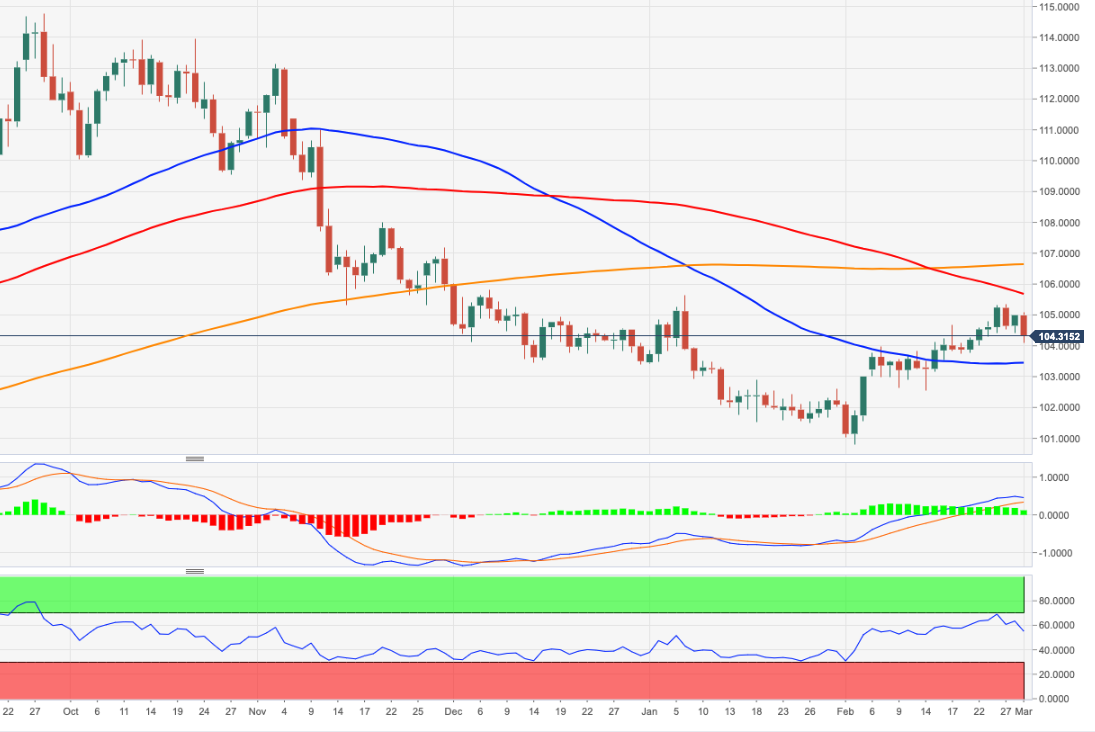
- USD/CAD comes under intense selling pressure on Wednesday amid broad-based USD weakness.
- The upbeat Chinese PMIs boost investors’ confidence and weigh heavily on the safe-haven buck.
- An intraday downtick in Oil prices could undermine the Loonie and help limit losses for the major.
The USD/CAD pair continues losing ground heading into the North American session and reverses a major part of the previous day's positive to the 1.3660 area. The pair currently trades near the 1.3585 area, or the daily low, and is pressured by the heavily offered tone surrounding the US Dollar.
In fact, the USD Index, which tracks the Greenback against a basket of currencies, retreats sharply from a multi-week high amid a slight recovery in the global risk sentiment. The upbeat Chinese PMI prints released earlier this Wednesday confirmed that recovery in the world's second-largest economy gained momentum in February. This, in turn, boosts investors' confidence and weighs on the safe-haven buck.
The downside for the USD, however, is likely to remain limited amid firming expectations that the Fed will continue to raise interest rates for longer to tame inflation. Moreover, the incoming positive US macro data pointed to an economy that remains resilient, which should allow the US central bank to stick to its hawkish stance. This, in turn, favours the USD bulls and could lend support to the USD/CAD pair.
Furthermore, an intraday downtick in Crude Oil prices might undermine the commodity-linked Loonie and supports prospects for the emergence of some dip-buying around the USD/CAD pair. Investors remain worried that rising borrowing costs will dampen economic growth and dent fuel demand. This, along with signs of increasing US crude stockpiles and additional supply from OPEC - act as a headwind for the black liquid.
The aforementioned fundamental backdrop warrants some caution before placing aggressive bearish bets around the USD/CAD pair and positioning for any further depreciating move. Next on tap is the release of the US ISM Manufacturing PMI, which, along with the broader risk sentiment, will drive the USD demand and provide some impetus. Traders will also take cues from Oil price dynamics to grab short-term opportunities.
Technical levels to watch
The USD continues to recover. Nonetheless, analysts at Credit Suisse look for key resistance from the 200-Day Moving Average and 38.2% retracement of the 2022/2023 fall at 106.15/45 to cap the DXY.
The market will eventually resolve the recent range lower
“We are mildly biased towards a slightly deeper recovery to 105.63, potentially the 38.2% retracement of the 2022/2023 fall and 200-DMA at 106.15/45. We would expect this to prove the extent of the recovery though, and we would look for this to cap to define the top of a broader range.”
“Post this consolidation phase, our bigger picture view remains that the market will eventually resolve its recent range lower, triggering further weakness later on in the year to test 99.82/37, then the 61.8% retracement at 98.98.”
- Annual CPI in Germany stayed unchanged at 8.7% in February.
- EUR/USD continues to push higher toward 1.0700 after the data.
Inflation in Germany, as measured by the Consumer Price Index (CPI), stayed unchanged at 8.7% on a yearly basis in February. This reading came in higher than the market expectation of 8.5%. On a monthly basis, the CPI was up 0.8%.
Meanwhile, the annual Harmonised Index of Consumer Prices (HICP), the European Central Bank's (ECB) preferred gauge of inflation, edged higher to 9.3% from 9.2% in January, compared to analysts' estimate of 9%.
Market reaction
EUR/USD preserves its bullish momentum after this data and was last seen rising 1.05% on the day at 1.0685.
EUR/USD has had a solid advance on the day as the pair rebounds from sub-1.06 levels. Economists at Scotiabank analyze the EUR technical outlook.
Major resistance is seen at 1.08
“Short-term EUR trading patterns lean bullish after the drift from yesterday’s high in the mid-1.06s found solid support overnight around 1.0580.”
“Gains through the mid-1.06s target additional EUR gains towards 1.07 potentially.”
“We spot major resistance at the 1.08 level.”
See – EUR/USD: 1.05 will be the bottom of the first quarter range after all – ING
- Siler gains traction for the second straight day and recovers further from the YTD low.
- The setup favours bearish traders and supports prospects for further near-term losses.
- A sustained strength beyond the $22.00 confluence could negate the negative outlook.
Silver builds on the previous day's recovery move from the $20.40 area, or a nearly four-month low and scales higher for the second successive day on Wednesday. The white metal, however, trims a part of its intraday gains and trades around the $21.00 mark, still up nearly 0.50% for the day heading into the North American session.
Looking at the broader picture, the XAG/USD on Tuesday showed some resilience below the 61.8% Fibonacci retracement level of the recent rally from the October 2022 low. The said support, around the $20.60 area, should now act as a pivotal point. Given that technical indicators on the daily chart have recovered from the oversold zone and are still holding deep in the negative territory, the bias still seems tilted in favour of bearish traders.
Hence, the ongoing recovery move is more likely to confront stiff resistance near 50% Fibo. level, around the $21.35 region, ahead of the mid-$21.00s. Any subsequent strength could be seen as a selling opportunity and runs the risk of fizzling out near the $22.00 confluence support breakpoint. The said handle comprises 100-day Simple Moving Average (SMA) and 38.2% Fibo. level, which if cleared could negate the near-term bearish bias.
A sustained strength beyond could trigger a short-covering rally and lift the XAG/USD towards the $22.55-$22.60 supply zone. Bulls might eventually aim to reclaim the $23.00 round-figure mark, which coincides with the 23.6% Fibo. level.
On the flip side, 61.8% Fibo. level, around the $20.60 area, now seems to protect the immediate downside. Some follow-through selling below the overnight swing low, around the $20.40 region, should make the XAG/USD vulnerable to weaken further. The downward trajectory should pave the way for a fall below the $20.00 psychological mark, towards testing the next relevant support near the $19.75-$19.70 region.
Silver daily chart
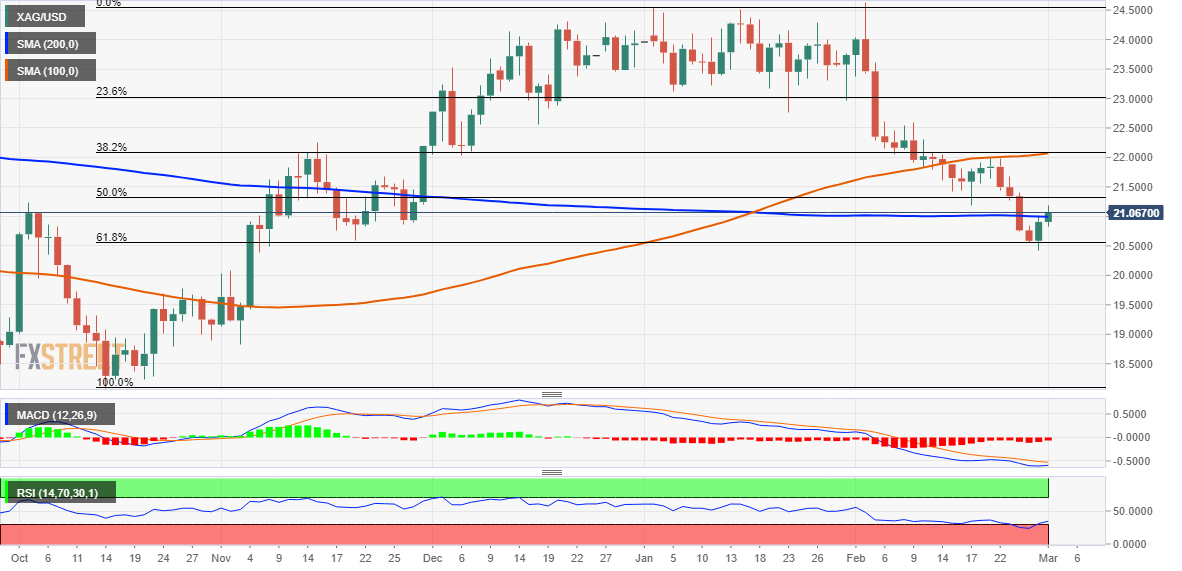
Key levels to watch
S&P 500 has fallen to key 200-Day Moving Average support and the 38.2% retracement of its rally at 3940/27. Strategists at Credit Suisse remain biased to look for a floor here.
Break below 3886 to suggest a more important downturn
“We continue to look for the 200DMA and the 38.2% retracement of the 2022/23 upmove at 3984/27 to hold in line with our view that this a temporary setback.”
“Above 4081/91 is needed to add weight to our view for strength back to 4195/4203, then what we look to be tougher resistance at the 61.8% retracement of the 2022 fall and summer 2022 high at 4312/4325. We look for this to then prove a tough barrier to define the top of what we believe could be a broad and lengthy range.”
“Below 3886 is needed to suggest we may have seen a ‘false’ break higher and more important downturn within the broad range, with the next support then seen at 3764.”
- EUR/JPY resumes the weekly leg higher above the 14400 mark.
- Immediately to the upside comes the 2023 high near 145.50.
EUR/JPY regains composure and advances past the 144.00 yardstick following Tuesday’s daily retracement.
The continuation of the current upside momentum faces the next hurdle at the 2023 high at 145.47 (February 28). Once this level is cleared, the par could then confront the December 2022 top at 146.72 (December 15) ahead of the 2022 high at 148.40 (October 21 2022).
In the meantime, while above the 200-day SMA, today at 141.54, the outlook for the cross is expected to remain positive.
EUR/JPY daily chart
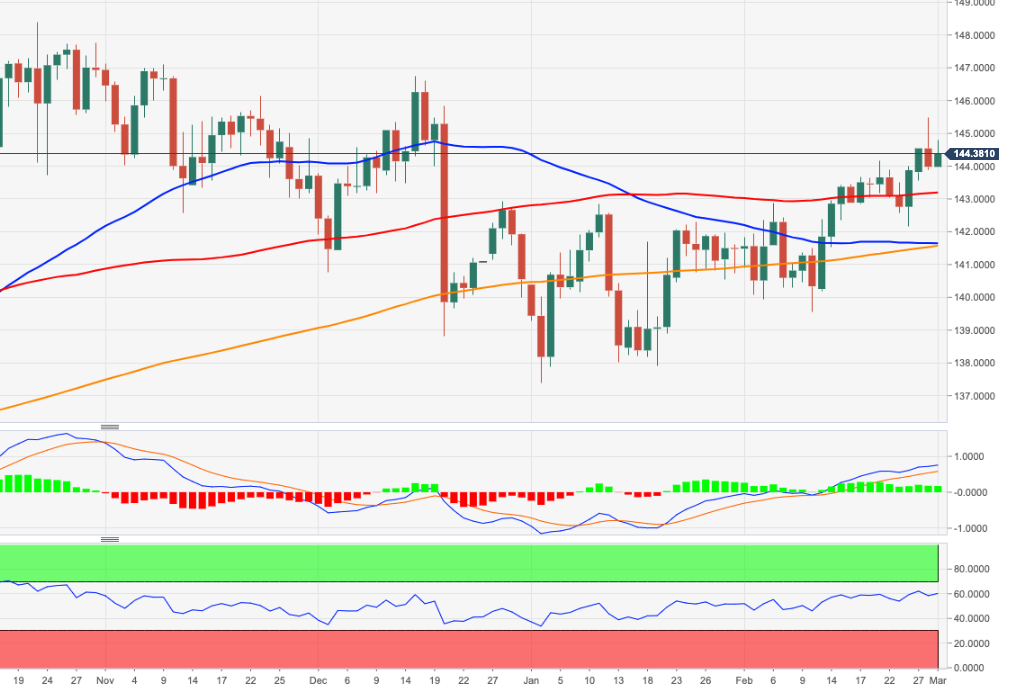
USD/JPY strength has extended to our target of the 38.2% retracement of the 2022/2023 fall and 200-Day Moving Average at 136.67/137.20. But analysts at Credit Suisse continue to look for a cap here and for the broader risk to turn lower again.
Close above 137.20 to open up further gains
“USD/JPY has extended its recovery to our target of. With the prior oversold condition now unwound, we continue to look for the 200-DMA and 38.2% retracement of the 2022/2023 fall at 136.67/137.20 to cap and for the broader risk to turn lower again.”
Below support at 134.05 is needed to add weight to our view, with support then seen next at 132.25/20, ahead of 129.80 and eventually 127.53/23 again.”
“Above 137.20 on a closing basis would suggest a more important low was established in January and strength can extend further with resistance next at 139.54/59.”
GBP/USD continues to hold support from its 200-Day Moving Average, never mind its key 1.1841 January low. Analysts at Credit Suisse look for the broader risk to eventually turn higher again from here.
GBP/USD to stay rangebound for now
“Cable continues to hold support from the 200-DMA at 1.1927 as looked for, never mind the key 1.1841 January low, and we continue to look for this to hold to keep the market trapped in a range of ~1.1850-1.2450.”
“Post this rangebound phase, we are still biased towards an eventual break above 1.2447/49 to target the May high and 61.8% retracement of the 2021/2022 fall at 1.2668/1.2758.”
“A break below 1.1841 at any stage would complete a bearish ‘double top’ to signal a much deeper sell-off, and likely a stronger USD rally more broadly, with support seen next at 1.1646.”
Today's focus is likely to be on the US Dollar again. Antje Praefcke, FX Analyst at Commerzbank, analyzes how the ISM's February Manufacturing PMI could impact the greenback.
Dollar undisputed
“The ISM index for February is likely to attract increased attention.
The market expects that the index will remain under the expansion/contraction mark of 50, but is likely to recover a little. That would constitute a rather more positive signal for USD.”
“However, as the market has already gone a long way in its expectations the upside potential in USD is likely to be limited.”
“A small excursion towards the lows seen at the start of the week might be seen again. However, as the Eurozone inflation data is due for publication tomorrow, I would be cautious about excessive Dollar gains.”
“I am more inclined to expect a strong reaction if the ISM index were to disappoint. In that case, EUR/USD is likely to rise a little further.”
Economists at Barclays Research see scope for further upside in the EUR/USD pair.
Ongoing policy normalization by the ECB supports medium-term EUR upside
“A faster exit from zero-COVID in China and a maturing tightening cycle for the Fed, given signs that US inflation is peaking, imply more upside for the EUR in 2023.”
“By our estimates, there is an additional 3-4% upside potential in EUR/USD from China’s reopening alone, which however seems to be on hold given geopolitical concerns surrounding the China-Russia rapprochement.”
“Upside risks to energy prices from geopolitics and China’s reopening have yet to materialize. Ongoing policy normalization by the ECB also supports medium-term EUR upside, notwithstanding some ambiguity in February’s message.”
- USD/JPY comes under some selling pressure on Wednesday amid broad-based USD weakness.
- The Fed-BoJ policy divergence could lend support to the pair and help limit any further losses.
- A positive risk tone could undermine the safe-haven JPY and further warrants caution for bears.
The USD/JPY pair attracts some sellers following an intraday uptick to the 136.45 area on Wednesday and moves further away from the YTD peak touched the previous day. Spot prices slide closer to the mid-136.00s during the first half of the European session, though any meaningful corrective decline seems elusive.
A sharp US DOllar retracement slide from a multi-week high turns out to be a key factor exerting some pressure on the USD/JPY pair. The downside, however, is likely to remain limited, at least for the time being, amid the divergent Bank of Japan(BoJ)-Fed monetary policy outlook. This, in turn, warrants some caution for aggressive bearish traders and positioning for deeper losses.
In fact, the incoming BoJ Governor Kazuo Ueda and Deputy Governor nominee Shinichi Uchida recently stressed the need to maintain the ultra-loose monetary policy to support the fragile domestic economy. In contrast, the US central bank is universally expected to stick to its hawkish stance for longer and continue hiking interest rates in the wake of stubbornly high inflation.
The prospects for further policy tightening by the Fed remain supportive of elevated US Treasury bond yields and favour the USD bulls. Apart from this, signs of stability in the equity markets, bolstered by the upbeat Chinese PMIs, could undermine demand for the safe-haven Japanese Yen (JPY). This, in turn, should lend some support to the USD/JPY pair and help limit the downside.
Hence, it will be prudent to wait for strong follow-through selling before confirming that the USD/JPY pair's recent appreciating move witnessed over the past month or so has run out of steam. Traders now look forward to the release of the US ISM Manufacturing PMI. This, along with the US bond yields, will influence the USD price dynamics and provide some impetus to the major.
Technical levels to watch
European Central Bank (ECB) policymaker Joachim Nagel reiterated on Wednesday that further significant rate hikes beyond March may be needed, as reported by Reuters.
Additional takeaways
"Favoring steeper reduction of APP portfolio from July."
"Rate cut talk non-starter until sufficient evidence of underlying inflation drop towards targets."
"Energy price drop has no essential bearing on ECB's medium term inflation projections."
"German inflation to average between 6% and 7% in 2023; rate could be well above 2% in both 2024 and 2025."
"Not expecting visible recovery until H2, full year GDP drop could be smaller than 0.5% December forecast."
"German economy to contract in Q1; gradual pick up from Q2 seen but no major improvement seen."
Market reaction
EUR/USD preserves its bullish momentum after these comments and was last seen rising 0.72% on the day at 1.0652.
Bank of England (BoE) Governor Andrew Bailey said on Wednesday that some further increase in bank rate may turn out to be appropriate but added that nothing is decided, as reported by Reuters.
Key takeaways
"I would caution against suggesting either that we are done with increasing bank rate, or that we will inevitably need to do more."
"We will reach our conclusions with a determined focus on achieving the 2% inflation target on a sustained and lasting basis."
"Economy is evolving much as we expected it to."
"Inflation has been slightly weaker, and activity and wages slightly stronger, though I would emphasize ‘slightly’ in both cases."
"We have to monitor carefully how the tightening we have already done is working its way through the economy."
"If we do too little with interest rates now, we will only have to do more later on."
"We must ensure that the situation does not get worse through homemade inflation taking hold."
"UK labour market remains very tight."
Market reaction
GBP/USD's reaction to these comments were muted and the pair was last seen trading at 1.2060, where it was up 0.35% on a daily basis.
The UK and EU have, at last, agreed on a deal that makes life easier for firms trading between Great Britain and Northern Ireland. However, the UK-EU deal is no game changer for Sterling, economists at ING report.
Welcome news, but not a game changer
“The global risk environment and a potential narrowing in UK-Eurozone interest rate differentials are likely to prove more important drivers of Sterling than the new UK-EU deal.”
“Our preference is for EUR/GBP to find support in the 0.87/0.88 area and end the year closer to 0.89/0.90.”
“GBP/USD is a different story, where we continue to look for some Federal Reserve easing by the end of the year and a weaker Dollar. Our baseline view assumes that GBP/USD finds support under 1.20 in this first quarter and manages to trade in a 1.25-1.30 range by year-end.”
- AUD/USD shows resilience below the 0.6700 mark and rebounds from a nearly two-month low.
- The upbeat Chinese PMI prints benefit the Australian Dollar amid a sharp intraday USD downfall.
- Looming recession risks, hawkish Fed expectations to act as a tailwind for the USD and cap gains.
The AUD/USD pair stages a recovery from sub-0.6700 levels, or a nearly two-month low touched earlier this Wednesday and scales higher through the first half of the European session. The momentum lifts spot prices to a fresh weekly high, around the 0.6775-0.6780 region in the last hour, with bulls now eyeing to test the 200-day Simple Moving Average (SMA) support breakpoint.
The upbeat Chinese data benefits the China-proxy Australian Dollar and prompt aggressive short-covering around the AUD/USD pair amid a sharp intraday US Dollar downfall. In fact, the official Chinese PMI prints for February indicated that business activity in the country rose to pre-COVID levels and that recovery in the world's second-largest economy is gaining steam. This largely offsets the softer-than-expected Australian macro data.
The Australian Bureau of Statistics reported that the economy expanded by 0.5% in the three months to December, lower than the 0.8% expected and 0.6% in the previous quarter. On an annualized basis, fourth quarter GDP rose 2.7%, as expected, though marked a significant slowdown from the 5.9% growth recorded in the previous quarter. Another report showed that Consumer Price Index (CPI) missed market estimates and decelerated from 8.4% to 7.4% in January.
The latest optimism, meanwhile, leads to a modest recovery in the global risk sentiment and weighs heavily on the safe-haven Greenback. This, in turn, is seen as another factor pushing the AUD/USD pair higher, though hawkish Fed expectations and looming recession risks could keep a lid on any further gains. The markets seem convinced that the Federal Reserve will stick to its hawkish stance for longer in the wake of stubbornly high inflation.
This remains supportive of elevated US Treasury bond yields and supports prospects for the emergence of some USD dip-buying. Furthermore, investors remain worried about economic headwinds stemming from rapidly rising borrowing costs. Adding to this, geopolitical tensions should cap any optimism in the markets and cap the risk-sensitive Aussie. This, in turn, warrants some caution before confirming that the pair has formed a near-term bottom.
Market participants now look to the US economic docket, featuring the release of the ISM Manufacturing PMI later during the early North American session. This, along with the US bond yields and the broader risk sentiment, should influence the USD price dynamics and allow traders to grab short-term opportunities around the AUD/USD pair.
Technical levels to watch
- EUR/USD reclaims the 1.0600 barrier and beyond.
- The dollar trades well on the defensive below the 105.00 level.
- Investors’ attention remains on the advanced CPI in Germany.
Increasing buying interest lifts EUR/USD to the area of multi-day peaks near 1.0660 on Wednesday.
EUR/USD focuses on German, US data
EUR/USD resumes the upside and leaves behind Tuesday’s daily decline on the back of the renewed and marked selling pressure in the greenback, which prompts the USD Index (DXY) to retreat to the sub-105.00 region.
Extra support for the European currency also came after ECB’s Müller noted that the current tightening cycle is having and effect, although inflation remains well elevated. He also suggested that expectations of rapid rate cuts are wishful thinking. His colleague Villeroy also said that the disinflation implemented will not result in a recession, at the time when he stressed the bank’s commitment to bring inflation back to the 2% goal by end of 2024.
In the docket, Germany’s jobs report showed the Unemployment Change rose by 2K in February and the Unemployment Rate held steady at 5.5% in the same period. Still in Germany, final Manufacturing PMI came at 46.3 9 (from 47.3), while the preliminary inflation figures will be released later in the European afternoon. In the broader Euroland, the final Manufacturing PMI matched the advanced print at 48.5.
In the US, the focus of attention will be on the ISM Manufacturing seconded by Construction Spending and the final Manufacturing PMI.
What to look for around EUR
EUR/USD woke up and reclaimed the area well north of 1.0600 the figure amidst some fresh downside pressure hurting the dollar on Wednesday.
In the meantime, price action around the European currency should continue to closely follow dollar dynamics, as well as the potential next moves from the ECB after the bank has already anticipated another 50 bps rate raise at the March event.
Back to the euro area, recession concerns now appear to have dwindled, which at the same time remain an important driver sustaining the ongoing recovery in the single currency as well as the hawkish narrative from the ECB.
Key events in the euro area this week: Germany/EMU Final Manufacturing PMI, Germany Unemployment Change, Flash Inflation Rate (Wednesday) – EMU Flash Inflation Rate, Unemployment Rate, ECB Accounts (Thursday) – Germany Balance of Trade, Final Services PMI, EMU Final Services PMI (Friday).
Eminent issues on the back boiler: Continuation of the ECB hiking cycle amidst dwindling bets for a recession in the region and still elevated inflation. Impact of the Russia-Ukraine war on the growth prospects and inflation outlook in the region. Risks of inflation becoming entrenched.
EUR/USD levels to watch
So far, the pair is gaining 0.68% at 1.0644 and a breakout of 1.0713 (55-day SMA) would target 1.0804 (weekly high February 14) en route to 1.1032 (2023 high February 2). On the flip side, the next support aligns at 1.0532 (monthly low February 27) seconded by 1.0481 (2023 low January 6) and finally 1.0328 (200-day SMA).
Growth in the Canadian economy ground to a halt in Q4. Following the publication of the data the Loonie eased. The losses were limited though. Still, economists at Commerzbank expect the CAD to struggle against USD and EUR.
Canadian GDP data confirms rate pause
“The Canadian GDP data for Q4 came in much lower than expected. It illustrated that the economy stagnated compared with the previous quarter. Moreover, the result for the previous quarter was revised to the downside.”
“The data is likely to confirm the BoC in its course. At the January meeting it had signalled that it wants to wait and see what the effects of the massive rate hikes last year will be on the economy and had announced a rate pause for the meeting next week.”
“The economic momentum is likely to suit the BoC and confirm it in its view that the stubbornly high core inflation levels will also return towards its target rate soon. It will be important for the Loonie now whether the Canadian data will confirm this picture.”
“CAD will continue to struggle with a recovery against USD and EUR, as core rate concerns are keeping rate expectations high there.”
EUR/USD got a lift yesterday. Economists at ING believe that the 1.05 level will be the bottom of the first quarter range.
EUR/CHF looks like it might end March near 1.00
“The continued re-pricing of the ECB curve is providing EUR/USD with some support against higher US rates and suggesting 1.05 will be the bottom of the EUR/USD's first quarter range after all. Certainly, the disinflation story is taking a back seat this month.”
“Today, we have a few ECB speakers and we should expect a relatively quiet 1.0565-1.0645 range for EUR/USD.”
“The more aggressive ECB pricing is also providing some support to EUR/CHF, which looks like it might end March near our 1.00 target.”
- USD/CAD meets with a fresh supply on Wednesday and is pressured by a combination of factors.
- Rising Crude Oil prices underpin the Loonie and weigh on the pair amid a sharp USD pullback.
- Looming recession risks, hawkish Fed expectations could limit the USD losses and lend support.
The USD/CAD pair comes under heavy selling pressure following an early uptick to the 1.3660 area, or a fresh weekly high on Wednesday and erodes a part of the previous day's strong gains. The pair maintains its offered tone through the first half of the European session and is currently placed near the lower end of the daily range, just below the 1.3600 mark.
Crude Oil prices gain positive traction for the second successive day, which underpins the commodity-linked Loonie and weighs on the USD/CAD pair. The upbeat Chinese PMI prints for February lifted hopes that recovery in the world's second-largest economy is gaining steam and boosted the outlook for fuel demand. Apart from this, the prospects for lower exports from Russia lend support to the black liquid.
The latest optimism, meanwhile, leads to a modest recovery in the global risk sentiment and triggers a sharp US Dollar corrective pullback from a multi-week high. This is seen as another factor contributing to the USD/CAD pair's intraday decline. That said, signs of rising crude stockpiles in the United States - the world's biggest oil consumer - and increasing supply from OPEC could cap any further gains for Oil prices.
According to sources, citing American Petroleum Institute (API) figures on Tuesday, US oil inventories rose by 6.2 million barrels in the week ended February 24. Adding to this, a Reuters survey found that OPEC pumped 28.97 million barrels per day (bpd) in February, up by 150,000 bpd from January. Investors also seem worried that the rising borrowing costs will dampen economic growth and dent fuel demand.
Furthermore, hawkish Fed expectations should help limit deeper losses for the Greenback and lend support to the USD/CAD pair. The markets now seem convinced that the US central bank will stick to its hawkish stance for longer in the wake of stubbornly high inflation. This remains supportive of elevated US Treasury bond yields and supports prospects for the emergence of some dip-buying around the USD.
Hence, it will be prudent to wait for strong follow-through selling before confirming that the USD/CAD pair has formed a near-term top ahead of the 1.3600 mark and placing fresh bearish bets. Traders now look to the US ISM Manufacturing PMI, which could influence the USD demand. Apart from this, Oil price dynamics could provide some impetus to the major and produce short-term trading opportunities.
Technical levels to watch
AUD/USD has retrace its gains following the release of the Gross Domestic Product (GDP) and inflation figures. Economists at Commerzbank expect the Aussie to struggle against the greenback.
Australian data mix supports AUD only briefly
“The Australian data mix this morning illustrates: the RBA’s 325 bps in previous rate hikes are having an effect, but more is likely to come.”
“Q4 GDP was expanding less than in the previous quarter. High levels of inflation, in January they remained at 7.4% YoY, are affecting the buying behaviour of consumers. At the same time the result means that the RBA is likely to become even more restrictive to control inflation.”
“AUD was able to benefit very briefly but soon focus returned to the USD, with hardly any currency, including the Aussie, standing a chance against it at present.”
- Gold price breaks out of descending parallel channel as market mood improves.
- US Dollar was sold off on a mix of soft US data and improving Chinese PMI numbrs.
- ISM Manufacturing and Services PMI releases still awaited for fresh impulse on XAU/USD.
Gold price has rallied in the first half of the trading week, breaking out of a bearish trend that had dominated XAU/USD price action for most of February, following a surprisingly hot US Nonfarm Payrolls report.
US 10-year Treasury bond yields faced once again a super-thick resistance at 4%, which is putting a hard cap on further US Dollar upside in the past trading days. While US 10-year T-bond yields are unable to break above this level, Gold price bulls should have the edge.
Gold news: Softer US inflation expectations, improving Chinese PMIs support XAU/USD
Soft data from the United States, led by decreasing inflation expectations in the CB Consumer Confidence report released on Tuesday, triggered some profit-taking on the US Dollar longs, as the reading might somewhat ease the pressure on the Federal Reserve to increase its interest rate hike path again.
This was followed on early Wednesday by higher-than-expected Purchasing Managers Index (PMI) readings in China, which improved the market mood in Asia. The first trading day in the month implies that a whole bunch of PMI surveys will be out around the world, which should bring fresh impulse to Gold price action.
United States Manufacturing and Services PMIs on the way
The Institute of Supply Management (ISM) will publish the Manufacturing PMI and the Services PMI on Wednesday and Friday, respectively, both at 15 GMT.
If the ISM Services PMI report reaffirms that rising wage costs are feeding into accelerating price pressures in the sector, the US Dollar is likely to hold its ground against Gold. Hence, the Prices Paid Index component will be watched closely by market participants.
It's worth noting, however, that the CME Group FedWatch Tool shows that markets are fully pricing in at least two more 25 basis points Federal Reserve rate hikes in March and May. Additionally, the probability of the Fed holding the policy rate unchanged in June stands at 25%.
The market turnaround has confirmed that the US Dollar does not have a lot of room on the upside, at least until the February jobs report and inflation data confirm or refute one more 25-bps hike in June.
In the meantime, investors are watching the US Treasury bond yields. 4% aligns as key resistance for the 10-year US T-bond yield and there could be a technical correction if that level stays intact. In that scenario, Gold price could turn north due to the inverse correlation with the US Treasury yields.
Gold price confirms Falling Wedge reversal pattern
Dhwani Mehta, Senior Analyst at FXStreet, reports the confirmation of the previously advised Falling Wedge pattern, which correctly hinted at a bullish reversal, and points at potential target levels for Gold price bulls:
Gold price confirmed falling wedge formation on the daily chart after yielding a daily close above the falling trendline resistance at $1,813 on Tuesday.”
“Should the upside break find its footing, the Gold price could advance further toward the previous week’s high at $1,848, above which the $1,850 psychological level will come into play.”
“Further up, the downward-sloping 21-Daily Moving Average (DMA) at $1,853 could challenge the bearish commitments.
Gold price in 2023: Up-and-down action
Financial markets have been a two-tale story for the early part of 2023, in which Gold price has reflected in its price action like no other asset. XAU/USD rode an uptrend during all of January with the market optimism about inflation slowing down and constant Federal Reserve dovish talk, only to see a drastic turnaround back to the old dynamics in February after a hot US Nonfarm Payrolls (NFP) report. The US economy adding more than 500K jobs in the month of January shifted the market expectations for the Fed easing its monetary policy, and the US Dollar has come back to the market King throne.
Gold price opened the year at $1,823.76 and reached a year-to-date high of $1,960 on February 2, right in between the first Federal Reserve meeting of the year and the surprising release of the US jobs report for January. Gold price went on a big downtrend from there, reaching year-to-date lows just above $1,800, where it found support.
-638132577618545430.png)
Gold price daily chart
- German Unemployment Rate held steady at 5.5% in January.
- Despite the mixed German jobs data, EUR/USD is holding higher ground near 1.0650.
Germany’s Unemployment Rate stood unchanged at 5.5% in January, the latest data published by Destatis showed on Wednesday. The market consensus was for a 5.5% reading.
The Unemployment Change arrived at 2K in January, rebounding from December’s drop of 15K while way below the market expectations of 19K.
Market reaction
The EUR/USD pair remains elavated near-daily highs after the data, last seen trading at 1.0647. The pair is gaining 0.67% so far.
European Central Bank (ECB) Governing Council member and French central bank governor Francois Villeroy de Galhau said on Wednesday, “Inflation in France should reach a peak during the first semester.”
Additional comments
“Expect growth in France to be slightly positive in 2023, slightly higher than the +0.3% forecast in December - before the expected recovery in 2024.”
“Now entering a new phase of monetary policy more comparable to a long-distance race.”
“It is preferable to reach the terminal rate by summer, by September at the latest.”
“We are committed to bring inflation back to 2% by end 2024.”
“Disinflation we will carry out will not lead to recession.”
Market reaction
EUR/USD holds the latest upside near 1.0635, adding 0.57% on the day. Hawkish ECB expectations drive the Euro through the roof. German inflation data is next in focus.
European Central Bank (ECB) Governing Council member Madis Muller said on Wednesday, “rate hikes are having an effect but inflation is still too high.”
“Expectations of rapid ECB rate cuts are wishful thinking,” Muller added.
Market reaction
The EUR/USD pair was last seen trading at 1.0637, up 0.60% on a daily basis.
GBP/USD trades in positive territory above 1.2050. The pair could regain the 1.21 handle today, analysts at ING report.
We will hear from BoE Governor Bailey today
“Look out for a speech by Bank of England Governor Andrew Bailey today. Money markets price the Bank Rate at 4.75% into September. Our team thinks that BoE rates will not need to be hiked that far, yet with inflation staying high for the time being, Governor Bailey may find it too early to disabuse the markets of that pricing.”
“GBP/USD could drift back to 1.2100 on the slightly softer Dollar today.”
FX option expiries for Mar 1 NY cut at 10:00 Eastern Time, via DTCC, can be found below.
- EUR/USD: EUR amounts
- 1.0425 1.7b
- 1.0450 793m
- 1.0500 1.8b
- 1.0590 1.2b
- 1.0690 1.4b
- USD/JPY: USD amounts
- 134.85 1.2b
- AUD/USD: AUD amounts
- 0.6790 1.3b
- USD/CAD: USD amounts
- 1.3580 500m
- 1.3620 859m
- 1.3750 800m
- NZD/USD: NZD amounts
- 0.6250 1.2b
- 0.6330 461m
- EUR/GBP: EUR amounts
- 0.8850 1.2b
Once USD/CNH clears the 7.0000 level it should be able to extend the upside momentum in the next few weeks, comment UOB Group’s Economist Lee Sue Ann and Market Strategist Quek Ser Leang.
Key Quotes
24-hour view: “We highlighted yesterday that ‘the pullback amid overbought conditions suggests USD is likely to consolidate today, expected to be within a range of 6.9500/6.9800’. USD subsequently traded in a relatively quiet manner between 6.9450 and 6.9649. Further consolidation appears likely, expected to be between 6.9400 and 6.9700.”
Next 1-3 weeks: “On Monday (27 Feb, spot at 6.9750), we highlighted that the strong boost in momentum from last Friday is likely to lead to further USD strength. We added, ‘The resistance levels to watch are at 7.0000 and 7.0200’. In the last couple of days, USD has not been able to make much headway to the upside. To maintain the upward momentum, USD has to break above 7.0000 within the next few days or the chances of further gains will diminish rapidly. On the downside, a breach of 6.9220 (no change in ‘strong support’ level) would indicate that the USD strength that started early this month has ended.”
Considering advanced prints from CME Group for natural gas futures markets, open interest shrank for the third session in a row on Tuesday, now by around 2.3K contracts. In the same direction, volume resumed the downtrend and dropped by nearly 55K contracts.
Natural Gas: Near-term top around $2.80?
The pronounced rebound in prices of the natural gas seems to have met some tough resistance near the $2.80 mark per MMBtu so far. Tuesday’s small gains were accompanied by shrinking open interest and volume, which hints at some consolidation in the short term ahead of a probable resumption of the downward bias.

- GBP/USD regains positive traction and draws support from a combination of factors.
- The upbeat Chinese PMIs boost investors’ confidence and weigh heavily on the USD.
- The Brexit optimism, BoE rate hike bets benefit the GBP and lend additional support.
The GBP/USD pair attracts fresh buyers in the vicinity of the 1.2000 psychological mark on Wednesday and stalls the overnight rejection slide from the 50-day Simple Moving Average (SMA). The intraday positive move picks up pace during the early European session and lifts spot prices to a fresh daily high, around the 1.2085 region in the last hour.
The US Dollar retreats from a multi-week high touched on Tuesday, which, in turn, is seen as a key factor pushing the GBP/USD pair higher. The upbeat Chinese PMI prints for February fuel optimism that a recovery in the world's second-largest economy is gaining steam and boosts investors' confidence. This is evident from signs of stability around the equity markets and weighs heavily on the safe-haven Greenback.
The British Pound, on the other hand, draws additional support from the new UK-EU agreement on the Northern Ireland protocol, which eliminates the risk of a potential trade war between the two sides. Adding to this, rising bets for additional rate hikes by the Bank of England (BoE) lend some support to the GBP/USD pair. Some analysts, however, still hope that the UK central bank would pause the current tightening cycle.
In contrast, the Federal Reserve is universally expected to stick to its hawkish stance for longer in the wake of stubbornly high inflation. This remains supportive of elevated US Treasury bond yields and should act as a tailwind for the USD. Moreover, worries about economic headwinds stemming from rapidly rising borrowing costs should cap any optimism in the markets and contribute to limiting losses for the safe-haven buck.
Hence, it will be prudent to wait for strong follow-through buying before positioning for an extension of the GBP/USD pair's solid bounce from a technically significant 200-day SMA. Traders now look to the final UK Manufacturing PMI, though the focus will remain on the BoE Governor Andrew Bailey's speech. Later during the early North American session, the US ISM Manufacturing PMI could influence the USD and provide some impetus.
Technical levels to watch
The US Dollar struggles to find demand. Economists at ING expect the US Dollar Index (DXY) to move within Monday’s range of 104.55-105.35.
ISM manufacturing data should remain soft at 48
“The US releases ISM manufacturing data which should remain soft at 48. More interest will be had in Friday's services ISM.”
“We suspect the China PMI story might dominate FX trading today and maintain a slightly offered tone for the Dollar. Yet DXY will probably trade well within Monday's range of 104.55-105.35.”
Further upside in USD/JPY should remain on the cards while above the 136.90 level according to UOB Group’s Economist Lee Sue Ann and Market Strategist Quek Ser Leang.
Key Quotes
24-hour view: “Yesterday, we expected USD to trade within a range of 135.80/136.60. However, USD popped to a high of 136.93 and then dropped sharply to close unchanged at 136.00. Upward momentum has not improved and USD is unlikely to advance further. Today, USD is more likely to trade sideways between 135.70 and 136.90.”
Next 1-3 weeks: “We highlighted on Monday (27 Feb, spot at 136.30) that after the strong rise late last week, upward momentum has been boosted and this will likely lead to further USD strength. We indicated, the next resistance level to watch is at 137.90. While USD rose to a fresh 2-week high of 136.93 yesterday, upward momentum has not improved further. USD must break and hold above 136.90 in the next 1-2 days or the chances of a move to 137.90 will rapidly diminish.”
Is Bank of England Governor Andrew Bailey acting as a brake for Sterling? Antje Praefcke, FX Analyst at Commerzbank, believes that the GBP could come under downside pressure again.
Effects of Brexit on the UK have not disappeared
“Will Bailey put a brake on Sterling’s rise? I think that is possible, depending on his comments. If the British economy were to hold up better than feared, it would be easier for the BoE to continue its rate hike cycle as it would have to take less consideration for economic developments. In addition, there is now relief about an agreement between the EU and UK on the Northern Ireland protocol. However, I am cautious as far as the current Sterling optimism is concerned.”
“The agreement about border regulations between the Republic of Ireland and Northern Ireland does not mean that the notable effects of Brexit on the United Kingdom have suddenly disappeared.”
“It is questionable whether the BoE will fulfill market expectations in connection with the key rate hike. That means if Bailey were to sound cautious today as regards the BoE’s future rate cycle, Sterling might come under depreciation pressure once again.”
Open interest in crude oil futures markets went up by more than 1K contracts on Tuesday following three consecutive daily pullbacks, according to preliminary readings from CME Group. In the same line, volume reversed two daily drops in a row and rose by around 109.7K contracts.
WTI: Initial target emerges at the $80.00 mark
Tuesday’s uptick in prices of the WTI was in tandem with increasing open interest and volume and is indicative that extra upside appears in store in the very near term. Against that, the commodity faces an immediate hurdle at the key $80.00 mark per barrel just ahead of the February high at $80.57 (February 13).
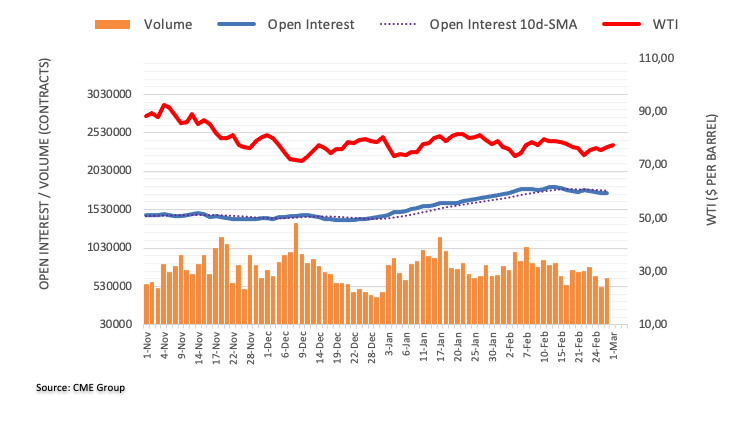
In the opinion of UOB Group’s Economist Lee Sue Ann and Market Strategist Quek Ser Leang, AUD/USD risks further pullbacks in the short term.
Key Quotes
24-hour view: “We highlighted yesterday that ‘the rebound amid oversold conditions suggest AUD is unlikely to weaken further’ and we expected AUD to consolidate within a range of 0.6710/0.6775. Our view for consolidation was not wrong even though AUD traded within a narrower range than expected (0.6704/0.6757). AUD could continue to consolidate, likely between 0.6695 and 0.6750.”
Next 1-3 weeks: “Our latest narrative was from two days ago (27 Feb, spot at 0.6735) where we highlighted that the outlook for AUD remains weak and the next levels to watch are at 0.6680 and 0.6630. Since then, AUD has not been able to make any headway to the downside. That said, we continue to hold the same view. Overall, only a breach of 0.6800 (‘strong resistance’ level previously at 0.6820) would indicate that the AUD weakness that started two weeks ago has ended.”
- NZD/USD gains strong positive traction and builds on the overnight bounce from the YTD low.
- The upbeat Chinese PMIs, a positive risk tone provide a goodish lift to the risk-sensitive Kiwi.
- Recession fears, hawkish Fed expectations act as a tailwind for the USD and could cap gains.
The NZD/USD pair catches aggressive bids on Wednesday and builds on the previous day's goodish rebound from the 0.6130 area, or its lowest level since November 23. The strong intraday positive move remains uninterrupted through the early European session and lifts spot prices to a fresh weekly high, back closer to the 0.6240-0.6250 supply zone.
The upbeat Chinese data, which showed that business activity in the country rose to pre-COVID levels, turns out to be a key factor boosting demand for antipodean currencies, including the Kiwi. In fact, China’s official Manufacturing PMI rose to 52.6 in February - the highest since April 2012. Moreover, the gauge for the non-manufacturing sector climbed to 56.3 in February, or the highest level since June 2022.
This indicates that recovery in the world's second-largest economy is gaining steam and leads to a modest recovery in the global risk sentiment. This, in turn, undermines the safe-haven US Dollar and benefits the risk-sensitive Kiwi. That said, looming recession risks should keep a lid on the optimism, which, along with hawkish Fed expectations could act as a tailwind for the Greenback and cap the NZD/USD pair.
The markets now seem convinced that the US central bank will have to raise interest rates for longer to tame stubbornly high inflation. This remains supportive of elevated US Treasury bond yields and favours the USD bulls. Hence, it will be prudent to wait for strong follow-through buying before confirming that the NZD/USD pair has formed a bottom around the 0.6135-0.6130 area and placing fresh bullish bets.
Traders now look forward to the US economic docket, featuring the release of ISM Manufacturing PMI later during the early North American session. This, along with the US bond yields and the broader risk sentiment, will influence the USD price dynamics and produce short-term trading opportunities around the NZD/USD pair.
Technical levels to watch
Economists at Commerzbank update their EUR/USD forecasts. The pair is expected to remain under pressure in the near term before rising to the 1.10 target.
Levels in the 1.06 range should be appropriate in the short term
“In the short term, EUR/USD levels in the 1.06 range seem appropriate to us.”
“EUR/USD levels around 1.10 have not (yet) proven sustainable. They are only likely to become so when Fed rate cuts become more foreseeable and, at the same time, the ECB sticks to its peak interest rate level.”
“We continue to expect rising EUR/USD rates in the second half of the year, but have postponed the price target (around 1.10, i.e. at the recent EUR/USD highs) to early 2024.”
“In the long term, we admittedly remain EUR skeptical due to skepticism regarding material ECB independence.”
Source: Commerzbank Research
- The index keeps the erratic performance unchanged this week.
- US yields extend the rally across the curve on Wednesday.
- The ISM Manufacturing will take centre stage later in the NA session.
The USD Index (DXY), which gauges the greenback vs. a basket of its main rival currencies, trades on the defensive well south of the 105.00 yardstick on Wednesday.
USD Index now looks at key data
The index fades Tuesday’s uptick and returns to the negative territory following an earlier failed attempt to retake the area above the 105.00 barrier.
The dollar, in the meantime, keeps the choppiness well in place so far this week against the usual backdrop of persistent speculation over the potential next steps by the Federal Reserve and the current resilience of the US economy.
Later in the US data space, all the attention will be on the release of the ISM Manufacturing for the month of February along with Construction Spending, the final Manufacturing PMI and weekly Mortgage Applications.
What to look for around USD
The index loses the grip and return to the sub-105.00 region ahead of key results in the US docket midweek.
The probable pivot/impasse in the Fed’s normalization process narrative is expected to remain in the centre of the debate along with the hawkish message from Fed speakers, all after US inflation figures for the month of January showed consumer prices are still elevated, the labour market remains tight and the economy maintains its resilience.
The loss of traction in wage inflation – as per the latest US jobs report - however, seems to lend some support to the view that the Fed’s tightening cycle have started to impact on the still robust US labour markets somewhat.
Key events in the US this week: MBA Mortgage Approvals, Final Manufacturing PMI, ISM Manufacturing, Construction Spending (Wednesday) – Initial Jobless Claims (Thursday) – Final Services PMI, ISM Non-Manufacturing (Friday).
Eminent issues on the back boiler: Rising conviction of a soft landing of the US economy. Persistent narrative for a Fed’s tighter-for-longer stance. Terminal rates near 5.5%? Fed’s pivot. Geopolitical effervescence vs. Russia and China. US-China trade conflict.
USD Index relevant levels
Now, the index is retreating 0.28% at 104.65 and the breach of 103.45 (55-day SMA) would open the door to 102.58 (weekly low February 14) and finally 100.82 (2023 low February 2). On the other hand, the next up barrier aligns at 105.35 (monthly high February 27) seconded by 105.63 (2023 high January 6) and then 106.51 (200-day SMA).
Here is what you need to know on Wednesday, March 1:
The US Dollar struggles to find demand early Wednesday following Tuesday's modest rebound. Upbeat macroeconomic data releases from China seem to be helping the market mood improve but investors refrain from committing to large positions ahead of German inflation data and the ISM's February Manufacturing PMI mid-week.
ISM Manufacturing PMI February Preview: Gloom persists despite US expanding economy.
The Conference Board announced on Tuesday that the Consumer Confidence Index declined to 102.9 in February from 106.0 in January. More importantly, the one-year consumer inflation rate expectation component of the survey dropped to 6.3% from 6.7% in January. With the initial reaction to these prints, the US Dollar found it difficult to gather strength against its rivals. With Wall Street's main indexes turning south and erasing the opening gains later in the session, the US Dollar Index managed to close the day modestly higher.
In the early Asian session on Wednesday, the data from China revealed that the NBS Manufacturing PMI rose to 52.6 in February from 50.1 in January. Additionally, the Non-Manufacturing PMI improved to 56.3 in the same period from 54.4. Both of these reading surpassed analysts' estimates. In turn, the Shanghai Composite Index gains 1% on Wednesday and Hong Kong's Hang Seng Index is up nearly 4%. Meanwhile, US stock index futures are trading modestly higher on the day.
After Australian Bureau of Statistics reported that the Gross Domestic Product grew at an annualized rate of 2.7% in the fourth quarter, compared to 5.9% in the third quarter, AUD/USD lost its traction in the Asian trading hours. Moreover, the annual Consumer Price Index dropped to 7.4% in January from 8.4%. Nevertheless, upbeat Chinese data helped the pair reversed its direction. At the time of press, AUD/USD was up 0.5% on the day at 0.6760.
Stronger-than-expected inflation readings from France and Spain provided a boost to the Euro during the European trading hours on Tuesday. EUR/USD, however, lost its traction and closed the day modestly lower before reclaiming 1.0600 early Wednesday. Annual CPI in Germany is forecast to edge lower to 8.5% in February from 8.7% in January.
GBP/USD climbed above 1.2100 on Tuesday but failed to preserve its bullish momentum in the second half of the day. Supported by the risk-positive market atmosphere early Wednesday, the pair trades in positive territory above 1.2050.
USD/JPY extended its sideways grind and closed flat on Tuesday. The pair continues to fluctuate in a narrow band above 136.00 in the European morning on Tuesday.
Gold capitalized on the robust Chinese data and extended its recovery on Wednesday. XAU/USD stays in positive territory above $1,830. The benchmark 10-year US Treasury bond yield stays quiet near 3.95%.
Statistics Canada reported on Tuesday that the Canadian economy stagnated in the fourth quarter with the real GDP (YoY) coming in at 0% and missing the market expectation for an expansion of 1.5% by a wide margin. USD/CAD gained traction after the disappointing GDP data and registered its highest daily close since early January above 1.3600. The pair stages a technical correction early Wednesday but manages to hold near 1.3600.
Bitcoin edged lower on Tuesday but regained its traction early Wednesday. At the time of press, BTC/USD was up more than 2% on the day at $23,700. After having declined to the $1,600 area on Tuesday, Ethereum turned north and was last seen rising 3% on the day at $1,650.
GBP/USD is now expected to navigate between 1.1970 and 1.2160 in the next few weeks, note UOB Group’s Economist Lee Sue Ann and Market Strategist Quek Ser Leang.
Key Quotes
24-hour view: “While we expected GBP to strengthen yesterday, we were of the view that it ‘is unlikely to challenge the major resistance at 1.2150’. Our view was not wrong as GBP soared to a high of 1.2143 before staging a relatively sharp pullback to close at 1.2018 (-0.37%). While the pullback has scope to extend, any decline is viewed as part of a lower trading range of 1.1970/1.2090. In other words, a sustained drop below 1.1970 is unlikely.”
Next 1-3 weeks: “We highlighted yesterday (28 Feb, spot at 1.2065) that GBP is likely to trade in a broad consolidation range between 1.1970 and 1.2150 for the time being. GBP soared to a high of 1.2143 in NY trade before staging a sharp and swift pullback. The price actions still appear to be part of a consolidation and we continue to hold the same view.”
- USD/JPY struggles to capitalize on a modest uptick on Wednesday and remains below the YTD top.
- The BoJ’s dovish outlook, weaker Japanese PMI undermine the JPY and continue to lend support.
- Hawkish Fed expectations, elevated US bond yields act as a tailwind for the USD and favour bulls.
The USD/JPY pair edges higher following the previous day's two-way price swings and trades with a mild positive bias through the early European session. The pair is currently placed below mid-136.00s and remains well within the striking distance of its highest level since December 20 touched on Tuesday.
A combination of factors undermines the Japanese Yen (JPY), which, in turn, acts as a tailwind for the USD/JPY pair amid the underlying bullish sentiment surrounding the US Dollar. Data released earlier this Wednesday showed that Japan's manufacturing sector remained in contraction territory in February. This comes on the back of dovish comments from the incoming Bank of Japan (BoJ) Governor Kazuo Ueda and Deputy Governor nominee Shinichi Uchida, stressing the need to maintain the ultra-loose monetary policy. This, along with signs of stability in the equity markets weigh on the safe-haven JPY.
The USD, on the other hand, remains pinned near a multi-week high amid firming expectations for further policy tightening by the Fed and lends additional support to the USD/JPY pair. In fact, the markets now seem convinced that the US central bank will have to raise interest rates for longer to tame stubbornly high inflation. This remains supportive of elevated US Treasury bond yields and continues to act as a tailwind for the Greenback. That said, indications that the Fed's rate hikes were beginning to have their intended effect of cooling the economy seem to cap any meaningful gains for the buck.
Investors remain worried about economic headwinds stemming from rapidly rising borrowing costs. The fears were fueled by Tuesday's disappointing release of the Conference Board's US Consumer Confidence Index, which fell to 102.9 in February from 106 in the previous month. Furthermore, the Chicago PMI business survey for February also came in weaker-than-expected and dropped to 43.6 in February, marking the sixth straight month in contraction territory. The Richmond Fed also released its survey of manufacturing activity for February and reported a decline to -16 from -11 in January 2023.
The aforementioned mixed fundamental backdrop is holding back traders from placing aggressive bets and keeping a lid on any meaningful gains for the USD/JPY pair, at least for the time being. Market participants now look to the US economic docket, featuring the release of ISM Manufacturing PMI later during the early North American session. This, along with the US bond yields, will influence the USD price dynamics and provide some impetus to the USD/JPY pair. Apart from this, traders will take cues from the broader risk sentiment to grab short-term opportunities around the major.
Technical levels to watch
- The Manufacturing PMI set to improve to 48.0 from 47.4, New Orders expected to rise to 43.7.
- The ISM Prices Paid Index is seen a tad higher at 45.0 from 44.5 in the previous month.
- Purchasing Managers’ Index will be released by the ISM on Wednesday at 15:00 GMT.
The main Manufacturing Purchasing Managers’ Index (PMI) in the United States will be released by the Institute of Supply Management (ISM) in its Report on Business, where the latest manufacturing business survey result is displayed, at 13:30 GMT this Wednesday.
What to expect from the ISM manufacturing PMI report?
The most important manufacturing PMI in the United States is anticipated to have edged up slightly to 48.0 in February from the 47.4 contraction registered in January.
Among the sub-components of the report, the focus will be on Prices Paid as it reflects business sentiment around future inflation. The Manufacturing Prices Paid sub-index is expected to improve from 44.5 in January to 45.0 during the reported month.
The Employment Index is also seen a tad higher at 51.0 in the second month of the year while the New Orders Index for February is expected to rise to 43.7 vs. January’s 42.5.
It’s worth noting that the US manufacturing contraction deepened in January, as the main index contracted for the third straight month and hit its lowest since May 2020.
The data will provide a fresh update on the manufacturing sector activity amid rising borrowing costs and growing doubts about a potential ‘soft-landing’, especially after Monday’s US Durable Goods Orders declined by 4.50% in January, compared to the -4.0% expectations and December’s increase of 5.10%.
Apart from the US economic data, the focus will also remain on the speeches from Federal Reserve policymakers, in the wake of heightened expectations of higher rates for longer amidst hot US inflation.
Wells Fargo’s research team forecasts a below-expectations report:
“We expect to see that ISM manufacturing spent another month in contractionary territory, with only an improvement of one-tenth of a point to 47.5. Last month, new manufacturing orders fell to 42.5, the lowest reading since mid-2020. Orders are expected to continue to dry up and production is expected to slowly contract. At least prices paid fell and employment remains steady in the face of these issues. We will look for more disinflationary pressures and challenges to the labor market in this upcoming report.”
When will the ISM manufacturing Purchasing Managers’ Index report be released and how could it affect EUR/USD?
The ISM Manufacturing PMI report is scheduled for release at 15:00 GMT, on March 1. Ahead of the key release, the US Dollar holds near multi-week highs, keeping the EUR/USD depressed near the 1.0600 mark.
A stronger headline print will be enough to bolster bets for a 50 basis points (bps) Fed rate hike move in March. This, in turn, should help provide a fresh lift to the US Treasury bond yields and boost the US Dollar.
NatWest said on Monday that it now expects the Federal Reserve to raise interest rates by 50 bps at its March meeting following Friday's hot Personal Consumption Expenditures (PCE) data for January. The bank also expects 25 bps increments at the May and June meetings, which would take the terminal rate to 5.75%, up from their earlier estimate of 5.25%.
However, a softer report could act as a headwind to the ongoing bullish momentum in the US Dollar. A US Dollar correction is likely to ensue, initiating a meaningful recovery in the EUR/USD pair. Traders will also pay close attention to the ISM survey's forward-looking New Orders sub-index, the Prices Paid component and the measure of factory employment for a significant market impact.
Dhwani Mehta, Editor at FXStreet, offers a brief technical overview of the EUR/USD and writes: “The Relative Strength Index (RSI) indicator on the four-hour chart is looking to pierce the midline for the upside on Wednesday. Additionally, the EUR/USD pair has managed to find reclaim ground above the flattish 21-Simple Moving Average (SMA), now at 1.0580.”
Dhwani also notes important technical levels to trade the EUR/USD: “On the upside, downward-sloping 50 SMA at 1.0621 could lure buyers should the latest uptick gain traction. Further up, the multi-day high near 1.0650 could be challenged.
“If the 21 SMA support fails, EUR/USD could resume its decline toward the 1.0550 psychological mark. The last line of defense for Euro bulls is foreseen at the 2023 low of 1.0533,” Dhwani adds further.
ISM manufacturing PMI-related content
- EUR/USD looks to regain 1.0600 as US Dollar bulls take a breather, German Inflation, US PMI eyed
- Dollar mixed as US consumer confidence falls in February
- Eurozone Inflation Preview: Eyes on monthly HICP amid heightened hawkish ECB bets
About the US ISM manufacturing PMI
The Institute for Supply Management (ISM) Manufacturing Index shows business conditions in the US manufacturing sector. It is a significant indicator of the overall economic condition in the US. A result above 50 is seen as positive (or bullish) for the USD, whereas a result below 50 is seen as negative (or bearish).
- Gold price prints three-day uptrend, confirms technical breakout supporting further advances.
- Strong China PMIs favor risk-on mood as US Dollar retreats after posting the biggest monthly gain since September 2022.
- Hawkish Fed bias challenges XAU/USD upside before US S&P Global, ISM PMI figures for February.
Gold price (XAU/USD) begins March on a firmer footing as it refreshes intraday high near $1,835 during the three-day winning streak amid early Wednesday in Europe.
The metal’s latest run-up appears logical from both the fundamental, as well as technical, perspectives as China-linked news join the XAU/USD run-up beyond the $1,823 previous resistance.
That said, strong prints of China’s Caixin and NBS Manufacturing PMIs for February join the Non-Manufacturing PMI for the said month to mark an upbeat economic rebound in the world’s biggest industrial player, as well as one of the major Gold consumers. Following the data, China Finance Minister Liu He showed readiness to bolster the nation’s fiscal spending while also mentioning that the foundation of China's economic recovery is still not stable.
Elsewhere, recently softer US data weighed on the US Dollar Index (DXY), which prints mild losses after the biggest monthly gains since September 2022 and allows the Gold buyers to keep the reins.
However, hawkish concerns surrounding the US Federal Reserve (Fed) and fears of more inflation crunch moving forward seem to keep a tab on the XAU/USD price.
While portraying the mood, S&P 500 Futures turn positive after initially tracking Wall Street’s mild losses but the US Treasury bond yields remain firmer at the latest.
Moving on, the US S&P Global and ISM PMI details for February will be important for immediate directions ahead of the next week’s key US jobs report. Above all, March’s Fed meeting and Chairman Jerome Powell’s testimony will be crucial for the Gold traders.
Gold price technical analysis
Gold price extends the previous day’s rebound from the 200-day Exponential Moving Average (EMA) to defy the three-week-old bearish channel. Adding strength to the recovery moves is the looming bull cross on the MACD and the RSI (14) rebound from the oversold territory.
With this, the XAU/USD appears well-set to aim for the 100-day EMA hurdle of $1,848.
However, the early February swing high of $1,890 will precede the $1,900 threshold and challenge the Gold buyers past $1,848.
Meanwhile, the XAU/USD pullback remains elusive unless the quote stays beyond the aforementioned bearish channel’s top line, close to $1,823 by the press time.
Following that, the 200-day EMA and the stated channel’s bottom line, around $1,804 and $1,784 in that order, appear important to confirm the bearish bias.
Gold price: Daily chart
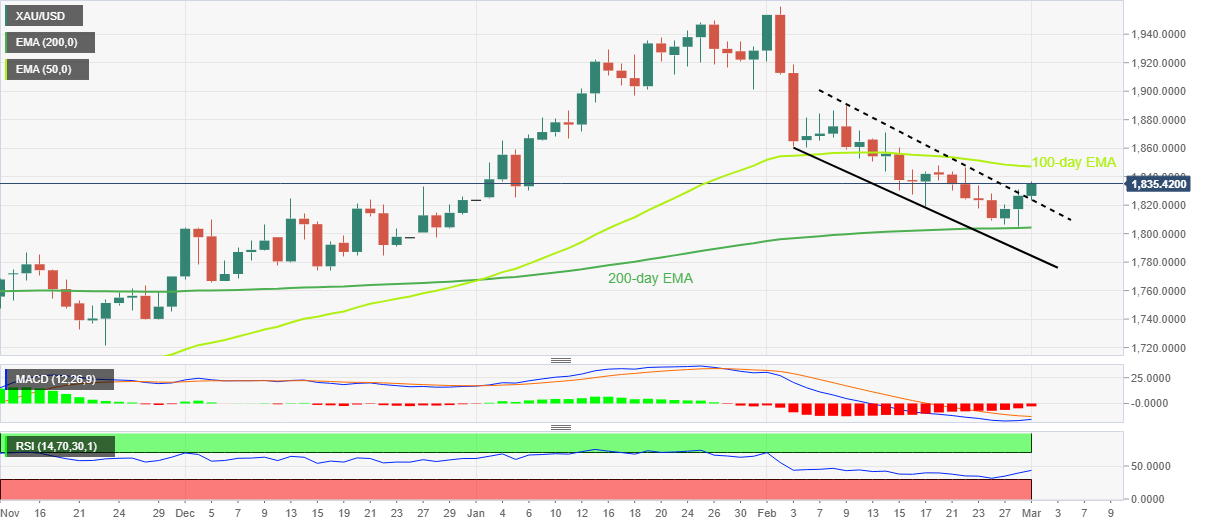
Trend: Limited upside expected
Gold price is extending a three-day recovery. FXStreet’s Dhwani Mehta analyzes XAU/USD technical outlook.
The 21 and 50 DMAs bearish crossover could remain a drag
“Gold price confirmed falling wedge formation on the daily chart after yielding a daily close above the falling trendline resistance at $1,813 on Tuesday. Should the upside break find its footing, XAU/USD could advance further toward the previous week’s high at $1,848, above which the $1,850 psychological level will come into play.”
“However, Gold price could run into strong offers at higher levels, as the 21 and 50-Day Moving Averages bearish crossover could remain a drag.”
“Any retracement could test the initial support at the $1,820 round figure, below which the two-month low of $1,805 will be in focus. The next downside target is seen at the $1,800 threshold.”
CME Group’s flash data for gold futures markets noted traders added around 4.5K contracts to their open interest positions on Tuesday, leaving behind the previous daily drop and maintaining the recent erratic performance unchanged. Volume followed suit and increased by around 57.2K contracts.
Gold now targets the $1850 region
Gold prices extended the bounce off February lows amidst rising open interest and volume on Tuesday. That said, the continuation of this rebound appears likely in the very near term and the precious metal could now challenge the key $1850 region per ounce troy.
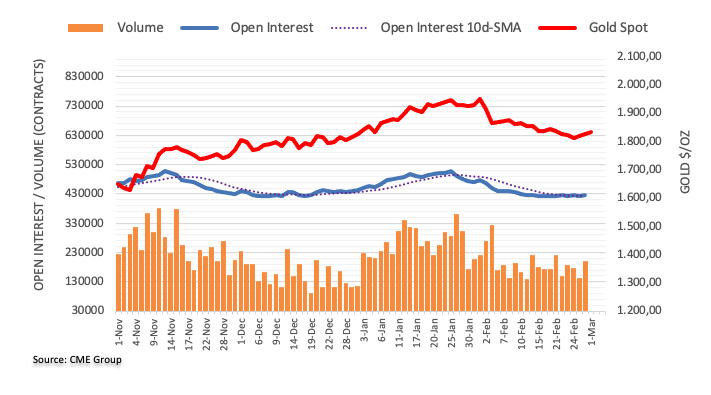
UOB Group’s Economist Lee Sue Ann and Market Strategist Quek Ser Leang suggested EUR/USD is now likely to trade within the 1.0530-1.0670 range in the near term.
Key Quotes
24-hour view: “We highlighted yesterday that the robust rebound in EUR could extend but a sustained rise above 1.0625 is unlikely. We indicated, the next resistance is at 1.0670. EUR rose to a high of 1.0645 in NY trade and then dropped sharply to end the day lower by 0.29% (1.0576). The underlying tone has weakened somewhat and EUR is likely to edge lower today. That said, any decline is unlikely to break the major support at 1.0530 (minor support is at 1.0550). Resistance is at 1.0600, followed by 1.0625.”
Next 1-3 weeks: “Yesterday (28 Feb, spot at 1.0605), we stated that a breach of 1.0625 would suggest that the EUR weakness that started about 2 weeks ago has ended and it has moved into a consolidation phase. EUR rose to 1.0645 before dropping to close at 1.0576 (-0.29%). Downward momentum has faded and EUR is likely to consolidate between 1.0530 and 1.0670 before heading lower at a later stage.”
- WTI crude oil rises for the second consecutive day, renews intraday high of late.
- Strong China PMI data bolster upbeat expectations from the world’s largest commodity user.
- Higher OPEC+ supplies, talks of more Russian Oil floating un-bid challenge WTI bulls.
- Fears of higher rates, inflation also keep a tab on energy benchmark ahead of US PMIs, official Oil inventories.
WTI crude oil renews its intraday high around $77.60 during the initial hour of Wednesday’s European session.
In doing so, the black gold marks another attempt to regain the $78.00 after the previous day’s pullback from a one-week high.
That said, the energy benchmark’s previous pullback could be linked to the US Dollar’s run-up amid hawkish Fed bets, as well as inflation fears, while the fears of more Oil supplies joined the force to challenge the commodity bulls afterward.
It’s worth mentioning that talks of higher supplies from the OPEC+ group, comprising the Organization of the Petroleum Exporting Countries (OPEC) and allies led by Russia, despite binding to the output cut commitments, exert downside pressure on the black gold price. On the same line could be the news shared via Bloomberg that says, “As many as 1.9 million barrels of Russian diesel-type fuel is currently in floating storage, the most since October 2020.” The news also mentioned that this phenomenon indicates some cargoes loaded from Russian ports without buyers.
It should be noted, however, that the mixed US data and strong prints of China’s Caixin and NBS Manufacturing PMIs for February, as well as the Non-Manufacturing PMI for the said month, pushes back the hawkish Fed concerns and favor hopes of more demand from the world’s biggest commodity user.
Looking ahead, the US S&P Global and ISM PMI details for February will be important for immediate directions ahead of the weekly official Oil inventory data from the US Energy Information Administration (EIA).
Technical analysis
A clear upside break of the 12-day-old descending trend line, previous resistance around $76.65, directs WTI crude oil buyers toward the 50-DMA hurdle of $78.00.
- USD/CAD takes offers to renew intraday low, reverses from “double top”.
- 100-HMA, two-week-old ascending trend line restrict immediate downside.
- RSI’s pullback from overbought territory, bearish MACD signals favor sellers.
- 200-HMA, 1.3530 act as crucial supports for Loonie pair bears to watch.
USD/CAD welcomes March with a bearish bias as it renews its intraday low near 1.3620 during early Wednesday morning in Europe. That said, the Loonie pair marked the biggest daily gain in a week the previous day, as well as posted the heaviest monthly jump since September 2022 by the end of February.
The quote’s latest pullback could be linked to its inability to cross the late February swing high of 1.3665. In doing so, the pair portrays the double top around 1.3660-65 region.
The chart formation also takes clues from the bearish MACD signals to lure sellers. On the same line could be the RSI (14) pullback from the overbought territory.
Hence, the USD/CAD pair is likely to register further downside. However, a convergence of the 100-Hour Moving Average (HMA) and an upward-sloping support line from mid-February, near 1.3580, appears a tough nut to crack for the bears.
Also adding to the downside filter are the 200-HMA and the weekly low, respectively near 1.3540 and 1.3530.
In a case where the USD/CAD drops below 1.3530 support, the pair confirms the bearish “double top” chart formation, which in turn suggests the theoretical fall towards 1.3400.
Alternatively, a sustained break of the 1.3660-65 hurdle could aim for January’s peak of 1.3685 and the last December’s high near 1.3700 before allowing the USD/CAD bulls a free zone to rule.
USD/CAD: Hourly chart
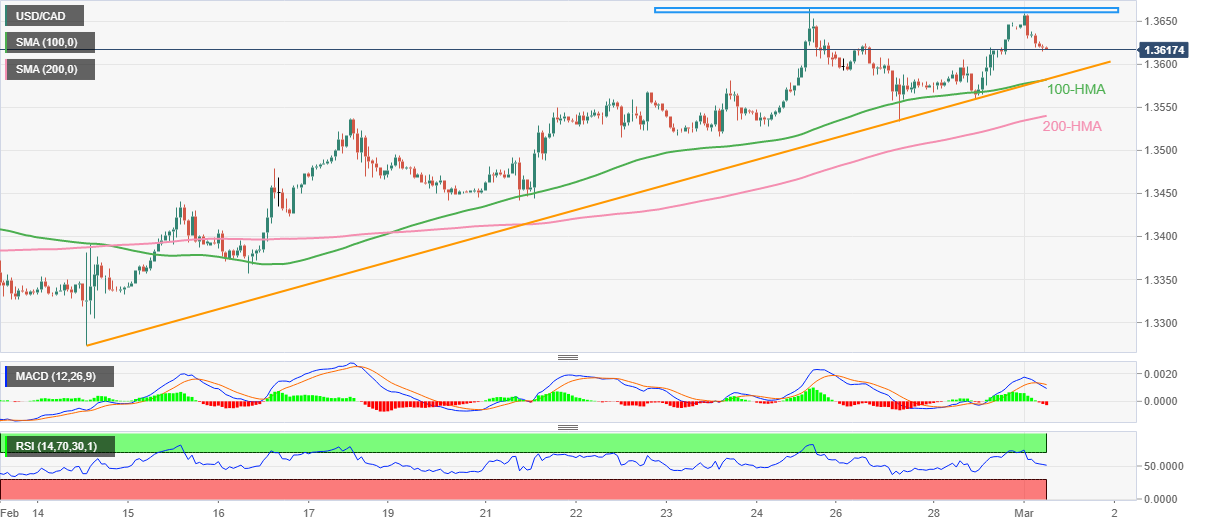
Trend: Limited downside expected
- AUD/USD is struggling to extend recovery above 0.6760, upside looks favored amid the risk-on impulse.
- Federal Reserve might turn more hawkish if US ISM Manufacturing PMI delivers a surprise jump.
- A sense of relief has been observed by the Reserve Bank of Australia as inflation has softened significantly.
- AUD/USD looks failing to turn bullish despite a responsive buying move amid an Inverted Flag formation.
AUD/USD has stretched its V-shape recovery move above to near the 0.6760 resistance in the early European session. The Aussie asset witnessed a sell-off in the Asian session after the release of the downbeat Australian Gross Domestic Product (GDP) and a sheer decline in the monthly Consumer Price Index (CPI). The downside bias in the Australian Dollar faded after the release of the upbeat Caixin Manufacturing PMI data, which infused fresh blood into the Aussie and resulted in a V-shape recovery.
S&P500 futures have turned positive after recovering significant losses posted in the Tokyo session, portraying a sheer recovery in the risk appetite theme. The US Dollar Index (DXY) has refreshed its day low below 104.47 as investors have ignored the uncertainty associated with hawkish Federal Reserve (Fed) bets. Also, the safe-haven assets are struggling to find a cushion as investors have underpinned the risk-on mood. Contrary to the positive market sentiment, the return offered on the 10-year US Treasury bonds looks still solid around 3.94%.
RBA senses relief as Australian Inflation softens and GDP trims
Investors dumped the Australian Dollar in the Asian session after the Australian Bureau of Statistics reported significantly lower monthly Consumer Price Index (CPI) figures than anticipation. The monthly Consumer Price Index (CPI) (Jan) dropped significantly to 7.4% from the expectations of 8.0% and the prior release of 8.4%. A mammoth decline in the inflation data is going to provide a big relief to Reserve Bank of Australia (RBA) policymakers.
The Reserve Bank of Australia has been making efforts in bringing down inflationary pressures by the continuation of policy tightening. Reserve Bank of Australia Governor Philip Lowe has already pushed its Official Cash Rate (OCR) to 3.35% in order to tame the stubborn inflation. And, more rates must be in pipeline to achieve price stability sooner.
Apart from the monthly CPI, Australian Gross Domestic Product (GDP) (Q4) has dropped to 0.5% from the consensus of 0.8% and Q3 figure of 0.6%. On an annualized basis, the GDP has remained in line with expectations at 2.7%. A decline in GDP numbers also showcases lower demand from households, which will trim inflation projections ahead as producers will be forced to scale down the prices of their offerings.
Upbeat Caixin Manufacturing PMI strengthens the Australian Dollar
It was widely anticipated that China’s manufacturing sector will outperform after the rollback of strict lockdown measures. Chinese administration and the People’s Bank of China (PBoC) are dedicated to spurring economic recovery by improving domestic demand. The IHS Markit reported the Caixin Manufacturing PMI data at 51.6, higher than the expectations of 50.2 and the former release of 49.2.
Apart from that, China’s National Bureau of Statistics (NBS) Manufacturing PMI (Feb) landed higher at 52.6 vs. the consensus of 50.5 and the prior release of 50.1. The Services Manufacturing PMI exploded to 56.3 against 54.4 released in January while the street was anticipating a downbeat figure at 49.7.
It is worth noting that Australia is the leading trading partner of China and a sharp recovery in the Chinese economy is also supportive of the Australian Dollar.
ISM Manufacturing PMI- the next trigger for the US Dollar
The street is awaiting the release of the United States Institute of Supply Management (ISM) Manufacturing PMI data. As per the consensus, the economic data is seen at 48.0 from the former release of 47.4. Apart from that, the New Orders Index that conveys forward demand is expected to rebound to 43.7 from the prior figure of 42.5.
It is worth noting that the Manufacturing PMI is in a contraction phase consecutively for the past three months. A figure below 50.0 is considered as a contraction in the extent of activities. Federal Reserve policymakers are expected to keenly watch the PMI figures as a surprise upside could strengthen the expectations of more hikes ahead.
AUD/USD technical outlook
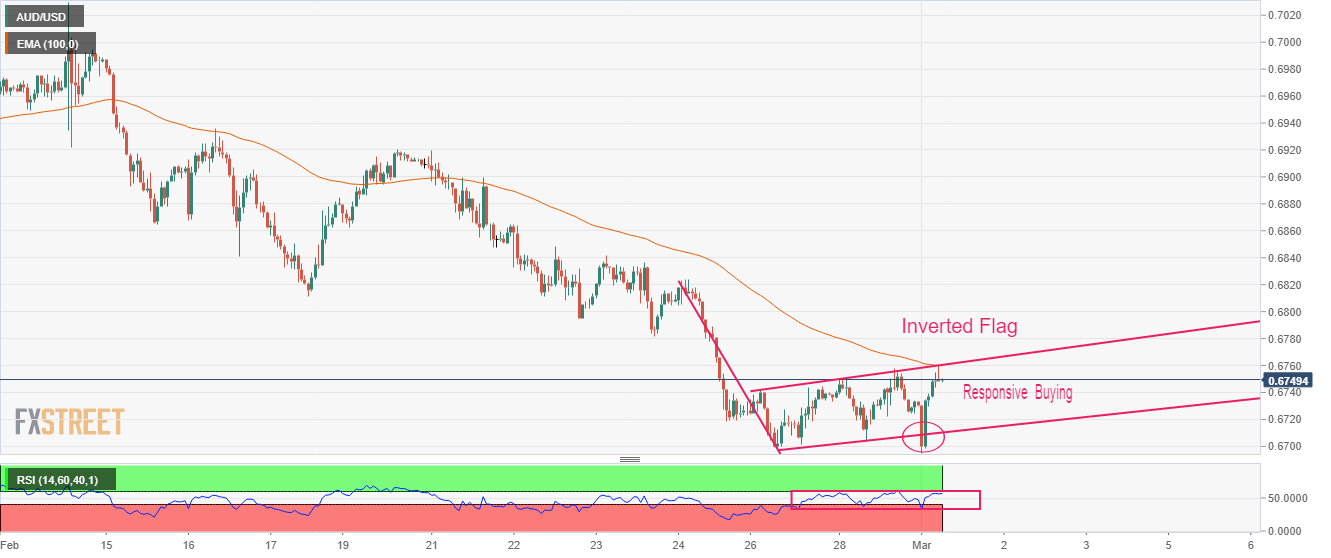
Despite a responsive buying action near the round-level support of 0.6700, the outlook for AUD/USD looks gloomy as the asset is forming an Inverted Flag chart pattern. The chart pattern indicates a sheer consolidation that is followed by a breakdown. Usually, the consolidation phase of the chart pattern serves as an inventory adjustment in which those participants initiate shorts, which prefer to enter an auction after the establishment of a bearish bias.
The 100-period Exponential Moving Average (EMA) around 0.6760 is acting as a barricade for the Aussie bulls.
Also, the Relative Strength Index (RSI) (14) is oscillating in the 40.00-60.00 range, indicating a consolidation ahead.
Bank of Japan (BoJ) board member Junko Nakagawa is back on the wires now, via Reuters, making some comments on the inflation and economic outlook.
Key quotes
Must look at various data in gauging price trend.
What we're aiming for is positive economic cycle accompanied by higher wages.
Want to spend some more time examining corporate bond market, when asked whether BoJ should take further steps to improve market functions as early as its March meeting.
There may be calls within BoJ to conduct comprehensive examination of policy framework, though I myself examine economic conditions at each policy meeting.
Related reads
- USD/JPY Price Analysis: Eyes another battle with the key DMAs above 136.00
- BoJ’s Nakagawa: Easy monetary policy is important for the time being, supports economy
- EUR/USD begins March month on a positive footing after the biggest monthly fall since September 2022.
- Cautious optimism in the market allows US Dollar to wobble near multi-day higher.
- Strong inflation data from Spain, France contrasts with downbeat US statistics to also underpin recovery moves.
- Germany’s HICP, US PMIs will be crucial for intraday directions.
EUR/USD picks up bids to refresh intraday high near 1.0595 heading into Wednesday’s European session. That said, the major currency pair marked the biggest monthly loss since the last September before marking the latest corrective bounce.
In doing so, the Euro pair takes clues from the broad US Dollar pullback amid a month-start sluggish session and pre-data anxiety. It’s worth noting that the upbeat prints of inflation numbers from Spain and France join China-inspired favor to the risk-on mood to also underpin the EUR/USD rebound.
That said, the preliminary readings of Spanish and French Consumer Price Index (CPI) details for February marked upbeat outcomes and bolstered the hawkish concerns surrounding the European Central Bank’s (ECB) next move on Tuesday.
On the contrary, the US Conference Board’s (CB) Consumer Confidence dropped for the second consecutive month to 102.9 versus 106.0 prior (revised) while US Housing Price Index drops 0.1% in December versus -0.6% market forecasts and -0.1% prior. Furthermore, Chicago Purchasing Managers’ Index for February eased to 43.6 from 44.3 previous readings and 45.0 market consensus whereas the Richmond Fed Manufacturing Index for the said month eased below 11.0 prior and -5.0 expected to -16.
It should be noted that strong prints of China’s Caixin and NBS Manufacturing PMIs for February joins the Non-Manufacturing PMI for the said month to mark an upbeat economic rebound in the world’s biggest industrial player and favored the risk profile. Even so, China Finance Minister Liu He said after the data release that the foundation of China's economic recovery is still not stable.
Against this backdrop, S&P 500 Futures turn positive after initially tracking Wall Street’s mild losses.
However, the firmer US Treasury bond yields and hawkish Fed bets, as well as the global inflation woes, keep the US Dollar on the bull’s radar. That said, the US Dollar Index (DXY) clings to mild losses near 104.85 after February’s impressive north-run.
Looking ahead, the first readings of Germany’s key inflation gauge for February, namely the Harmonized Index of Consumer Prices (HICP), could challenge the pair’s upside momentum on missing the upbeat 0.7% MoM forecasts, versus 0.5% prior. Also important to watch are the S&P Global and ISM PMI details for February.
Technical analysis
The EUR/USD pair’s multiple failures to cross the 50-bar Exponential Moving Average (EMA), around 1.0620, join the receding bullish bias of the MACD signals to favor sellers. On the flip side, a two-month-old ascending support line, near 1.0545, could restrict the short-term downside of the pair.
- GBP/USD is oscillating in a narrow range around 1.2040 ahead of BoE Bailey’s speech.
- Upbeat Caixin Manufacturing PMI data has ameliorated the negative market sentiment.
- The street looks less impressed by the Brexit deal and diverting attention to data publications for Pound Sterling’s outlook.
The GBP/USD pair is displaying a sideways auction after sustaining above 1.2020 in the early European session. The Pound Sterling is expected to remain sideways as investors are awaiting the release of the speech from Bank of England (BoE) Governor Andrew Bailey, which is scheduled for Wednesday.
The Cable is expected to stretch its recovery above 1.2040 vertically as the US Dollar Index (DXY) is expected to extend its losses amid a recovery in the risk-on market mood.
The USD Index is struggling to find feet as the release of the upbeat Caixin Manufacturing PMI data has ameliorated the negative market sentiment. S&P500 futures have recovered their entire losses generated in the Asian session now, portraying a sheer improvement in the risk appetite of the market participants. However, the 10-year US Treasury yields look still solid above 3.93%.
Going forward, the speech from BoE Governor Andrew Bailey will be of utmost importance. BoE Bailey is expected to provide cues about the likely monetary policy action ahead. A hawkish tone is expected from BoE Governor as the United Kingdom (UK) inflation is still in the double-digit figure despite a prolonged spree of rate hikes.
Meanwhile, the street seems not confident about the Pound Sterling outlook despite the Brexit deal. Economists at Commerzbank are of the view that “An agreement in connection with the Northern Ireland protocol is likely to have little influence on short-term inflation developments and as a result, the market is likely to return its attention to data publications and comments by BoE members again pretty quickly. In this context, we remain skeptical of Sterling.”
- Silver price extends the previous day’s recovery from the lowest levels since early November 2022.
- Sustained break of 100-HMA, bullish MACD signals and ascending trend channel keep buyers hopeful.
- Overbought RSI conditions challenge XAG/USD run-up past $21.20 hurdle, 200-HMA act as additional upside filter.
Silver price (XAG/USD) remains firmer around $21.10 as bulls extend the previous day’s rebound from the multi-day low during early Wednesday. In doing so, the bright metal marches with a two-day-old ascending trend channel while justifying the bullish MACD signals.
However, the overbought conditions of the RSI (14) join multiple technical hurdles around $21.20 to challenge the metal’s further upside momentum. Among the key resistances, the February 17 swing low and the 50% Fibonacci retracement level of the pair’s February 22-28 fall gain major attention. Also challenging the buyers is the upper line of the stated bullish channel.
Even if the XAG/USD rises past $21.20, the 200-Hour Moving Average (HMA) could challenge bullion buyers near $21.35.
Following that, a north-run towards the late February swing high near $22.00 can’t be ruled out.
On the contrary, a downside break of the 100-HMA, around $21.00 by the press time, could challenge the nearby bullish chart formation by poking the $20.90 support.
Should the quote successfully defies the ascending trend channel, the previous monthly low near $20.40 and the $20.00 psychological magnet will gain the market’s attention.
To sum up, the Silver price is likely to remain in recovery mode but the upside room appears limited.
Silver price: Hourly chart
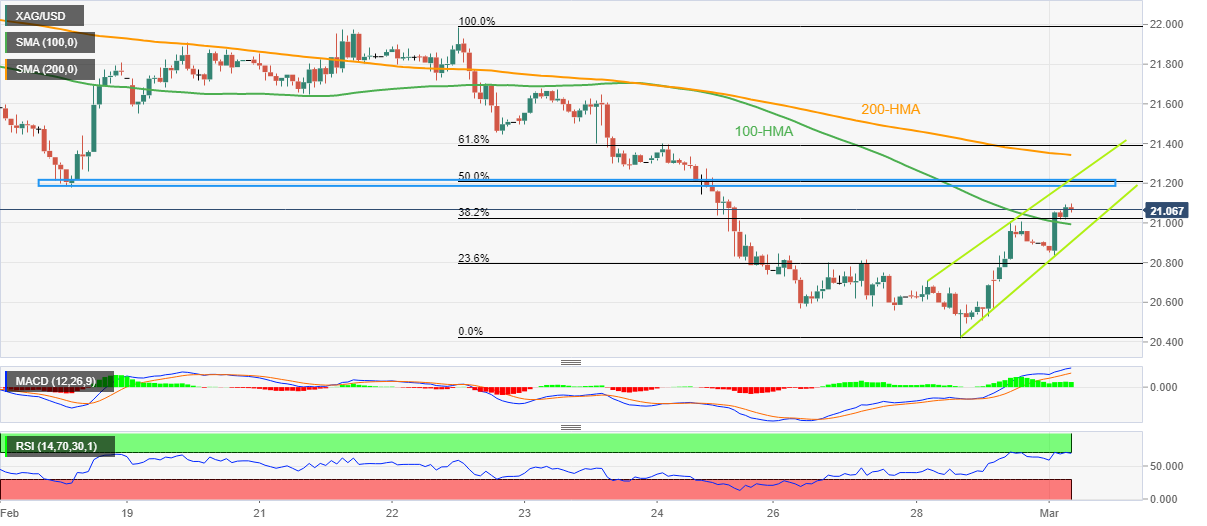
Trend: Limited upside expected
- USD/INR has turned volatile as investors are discounting India’s weak GDP numbers.
- India’s Q3 GDP has slipped lower to 4.4% from 6.3% and 13.5% figures recorded in Q2 and Q1 respectively.
- Upbeat Caixin Manufacturing PMI has improved investors’ risk appetite.
The USD/INR pair has shown a recovery move after dropping firmly to near 82.35 in the Asian session. The asset is displaying volatility as investors are discounting overnight sell-off in the US Dollar Index (DXY). The major is prone to the downside as the risk-off impulse has faded after the release of the upbeat Caixin Manufacturing PMI data.
The US Dollar Index (DXY) has sensed support after printing a day low at 104.47. The corrective move in the USD Index is the outcome of disappearing fears of more rates announcement from the Federal Reserve (Fed). Meanwhile, the alpha generated on the US government bonds looks still solid. At the press time, the 10-year US Treasury yields are hovering around 3.94%.
S&P500 futures are on the verge of shrugging their entire losses reported in the Asian session, portraying a meaningful rebound in the risk appetite of the market participants.
A power-pack performance is expected from the USD Index amid the release of the United States ISM Manufacturing PMI data. According to the preliminary estimates, the economic data is seen at 48.0 from the former release of 47.4. Apart from that, the New Orders Index that conveys forward demand is expected to rebound to 43.7 from the prior figure of 42.5.
The Indian Rupee remained in action on Tuesday over the release of the Gross Domestic Product (GDP) Q3 data. Restrictive monetary policy by the Reserve Bank of India (RBI) in wake of achieving price stability has resulted in a slowdown in economic activities. The Q3 GDP has dropped to 4.4% in which crude oil output has dropped firmly by 1.1% on an annual basis. In the Q2 and Q1, GDP was measured at 6.3% and 13.5% respectively.
- USD/IDR remains mildly bid for the second consecutive day despite upbeat Indonesia Inflation.
- Indonesia Inflation and Core Inflation both grew more than expected in February.
- Upbeat yields challenge US Dollar’s retreat after the biggest monthly gains since September 2022.
- US PMIs, risk catalysts eyed for immediate directions, Fed talks will be the key.
USD/IDR struggles to justify strong Indonesia Inflation early Wednesday as it picks up bid to $15,560 during the two-day uptrend at the latest. The reason could be linked to the mixed sentiment in the markets as traders brace for the key March month.
Indonesia's Inflation grew 5.47% YoY versus 5.44% expected and 5.28% prior but the MoM figures eased to 0.16% from 0.34% previous readings while crossing 0.11% market consensus. Further, Core Inflation dropped to 3.09% during the stated month versus 3.26% estimations and 3.27% prior.
Apart from the Indonesian inflation data, strong China PMI also should have favored the market sentiment and weighed on the USD/IDR prices. However, anxiety ahead of the key data/events, as well as firmer US Treasury bond yields seems to propel the USD/IDR prices.
That said, China’s Caixin Manufacturing PMI traces official activity data per NBS Manufacturing and Non-Manufacturing PMI to mark a strong economic rebound in February. Even so, China Finance Minister Liu He said after the data release that the foundation of China's economic recovery is still not stable.
Amid these plays, the S&P 500 Futures trace Wall Street’s mild losses around 3,960. Further, the US 10-year Treasury bond yields rose two basis points (bps) to 3.93% while the two-year counterpart rises four bps to 4.84% by the press time. With this, both the key bond coupons march towards the three-month high marked in February after printing the biggest monthly gain since September 2022.
Looking ahead, US S&P Global and ISM PMIs for February could direct immediate moves but major attention will be given to the next week’s monthly jobs report, Federal Reserve (Fed) Chairman Jerome Powell’s testimony and the Federal Open Market Committee (FOMC) monetary policy meeting for clear directions.
Technical analysis
Despite the latest run-up, the USD/IDR bulls need validation from the 50-DMA, as well as an upward-sloping resistance line from the mid-January, respectively near $15,265 and $15,300, to push back the bearish bias.
- Gold price is aiming to shift its business above $1,830.00 as investors shrug off hawkish Fed-inspired volatility.
- An upbeat Caixin Manufacturing PMI has infused fresh blood into the risk-sensitive assets.
- A surprise decline in the US PMI figures could impact the strong labor market.
Gold price (XAU/USD) has rebounded firmly above $1,830.00 in the Asian session and is aiming to shift its auction above the same. The precious metal has picked strength as investors’ risk appetite has improved after the release of the upbeat Caixin Manufacturing PMI data. Investors have cheered the strong performance of the Chinese manufacturing sector as it indicates that the economy is effectively on the path of economic recovery after dismantling pandemic controls.
S&P500 futures have recovered the majority of the losses reported in the Asian session. The US Dollar Index (DXY) has refreshed its day low at 104.57 as investors are turning a deaf ear to the fears associated with higher rates expectations from the Federal Reserve (Fed). The demand for US government bonds still looks gloomy as the return on 10-year US Treasuries is solid at 3.94%.
Wednesday’s session is going to be full of action as the United States Institute of Supply Management (ISM) will report February’s Manufacturing PMI. The economic data is seen at 48.0 lower than the former release of 47.4. The Manufacturing PMI has been contracting consecutively for the past three months as a figure below 50.0 is itself considered a contraction. A surprise decline in the PMI figures could impact the strong US labor market and lay-off could be witnessed ahead.
Gold technical analysis
Gold price has rebounded after testing the breakout of the Falling Channel chart pattern formed on an hourly scale. The precious metal is expected to display a sheer upside move as a bullish reversal has been confirmed after exploding the aforementioned chart pattern on the upside.
The Relative Strength Index (RSI) (14) has delivered a range shift move from the 40.00-60.00 dimension to the bullish vault of 60.00-80.00, which advocates more upside ahead.
Gold hourly chart

- USD/JPY picks up bids to snap two-day downtrend around 10-week high.
- Bullish MACD signals, sustained trading beyond two-week-old support line keep buyers hopeful.
- 100-DMA, 200-DMA challenges Yen pair buyers amid overbought RSI (14).
USD/JPY prints mild gains around 136.30-40 during early Wednesday morning in Europe. In doing so, the Yen pair snaps the previous two-day losing streak around the lowest levels since late December 2022. The recovery moves, however, gain little acceptance amid overbought RSI (14), as well as due to the presence of the key 100-DMA and 200-DMA.
Hence, the quote’s latest rebound needs validation from the 100-DMA and 200-DMA, respectively near 136.85 and 137.20, to convince buyers. Adding to the upside filter is the last December’s peak near 138.20.
Following that, the 140.00 round figure and late November 2022 high of 142.25 could lure the USD/JPY buyers.
On the flip side, a 13-day-long ascending support line, close to 135.35 at the latest, restricts the short-term pullback of the USD/JPY pair.
In a case where the USD/JPY price drops below the 135.35 support, the January 2022 peak near 134.75 can act as the additional check for the pair bears before aiming for the multiple support levels surrounding 131.00.
Overall, USD/JPY may trace bullish MACD signals to extend the run-up beyond the nearby support line but the room towards the north appears limited due to the existence of the key moving averages and overbought RSI conditions.
USD/JPY: Daily chart
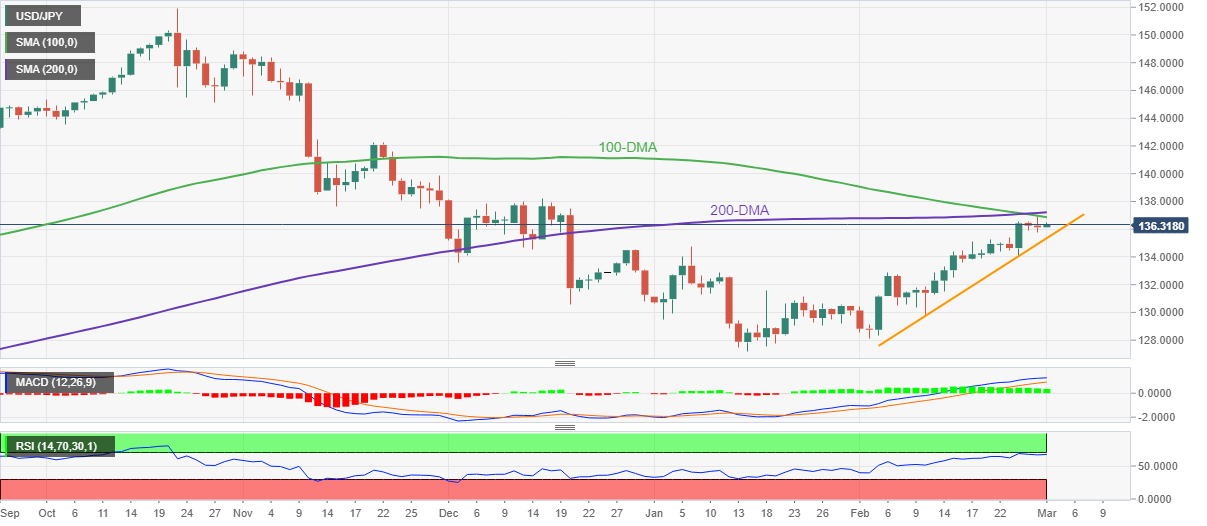
Trend: Limited upside expected
- USD/CHF takes offers to renew intraday high even as risk-aversion prevails.
- US Dollar struggles to track upbeat yields amid strong China data, softer statistics at home.
- Downbeat Swiss GDP, hawkish Fed bets favored buyers the previous day.
USD/CHF renews its intraday low around 0.9410 as bulls take a breather following the strong February performance during early Wednesday. In doing so, the Swiss currency pair fails to justify the market’s mildly offbeat tone amid fears of higher rates and inflation. The reason could be linked to China as recent activity data from the world’s largest industrial player came in impressive for February.
That said, China’s Caixin Manufacturing PMI traces official activity data per NBS Manufacturing and Non-Manufacturing PMI to mark a strong economic rebound in February. Even so, China Finance Minister Liu He said after the data release that the foundation of China's economic recovery is still not stable.
It should be noted that the month-start consolidation and the recently softer US data also seem to favor the USD/CHF bears. On Tuesday, the US Conference Board’s (CB) Consumer Confidence dropped for the second consecutive month to 102.9 versus 106.0 prior (revised) while US Housing Price Index drops 0.1% in December versus -0.6% market forecasts and -0.1% prior. On the same line, the S&P/Case-Shiller Home Price Indices grew 4.6% YoY during the said month compared to 6.1% market expectations and 6.8% previous readings. Furthermore, Chicago Purchasing Managers’ Index for February eased to 43.6 from 44.3 previous readings and 45.0 market consensus whereas the Richmond Fed Manufacturing Index for the said month eased below 11.0 prior and -5.0 expected to -16.
Even so, the market’s fears of higher inflation and interest rates keep the USD/CHF buyers hopeful. While portraying the mood, the S&P 500 Futures track Wall Street’s mild losses around 3,960. Further, the US 10-year Treasury bond yields rose two basis points (bps) to 3.93% while the two-year counterpart rises four bps to 4.84% by the press time. With this, both the key bond coupons march towards the three-month high marked in February after printing the biggest monthly gain since September 2022.
Apart from the risk-off mood, downbeat data at home also could keep the USD/CHF buyers hopeful. Swiss Gross Domestic Product (GDP) arrived at 0% in the fourth quarter (Q4) of 2022 vs. a growth of 0.3% and 0.2% recorded in the third quarter.
Moving forward, Swiss Real Retail Sales for January can direct immediate USD/CHF moves ahead of US activity data for the said month. However, major attention will be given to the next week’s monthly jobs report, Federal Reserve (Fed) Chairman Jerome Powell’s testimony and the Federal Open Market Committee (FOMC) monetary policy meeting for clear directions.
Technical analysis
USD/CHF pullback remains elusive unless the quote drops back below the 100-day Exponential Moving Average (EMA) level surrounding 0.9385.
- EUR/USD prints mild gains to lick its wounds after the biggest monthly loss since the September.
- Repeated failures to cross 50-EMA, receding bullish bias of MACD keep sellers hopeful.
- Ascending support line from early January lures Euro sellers.
EUR/USD picks up bids to refresh intraday high around 1.0580-85 as it prints mild gains to consolidate the biggest monthly slump fall in five during early Wednesday.
In doing so, the Euro pair seems to brace for the first readings of Germany’s key inflation number for February, namely the Harmonized Index of Consumer Prices (HICP), expected 0.7% MoM versus 0.5% prior.
That said, the quote’s multiple failures to cross the 50-bar Exponential Moving Average (EMA) join the receding bullish bias of the MACD signals to favor sellers.
Even if the EUR/USD price crosses the 50-EMA hurdle surrounding 1.0620, a downward-sloping resistance line from mid-February and 200-EMA, close to 1.0640 and 1.0695 in that order, could challenge the pair buyers.
It’s worth observing that multiple levels marked since January 09 highlight the 1.0765-70 horizontal area as the last defense of the EUR/USD bears.
Meanwhile, a two-month-old ascending support line, near 1.0545, could restrict the short-term downside of the EUR/USD pair.
Following that, lows marked during the last month and January, around 1.0530 and 1.0480 in that order, could lure the EUR/USD bears.
Adding to the downside filters are the lows marked during late December 2022 around 1.0450.
EUR/USD: Four-hour chart
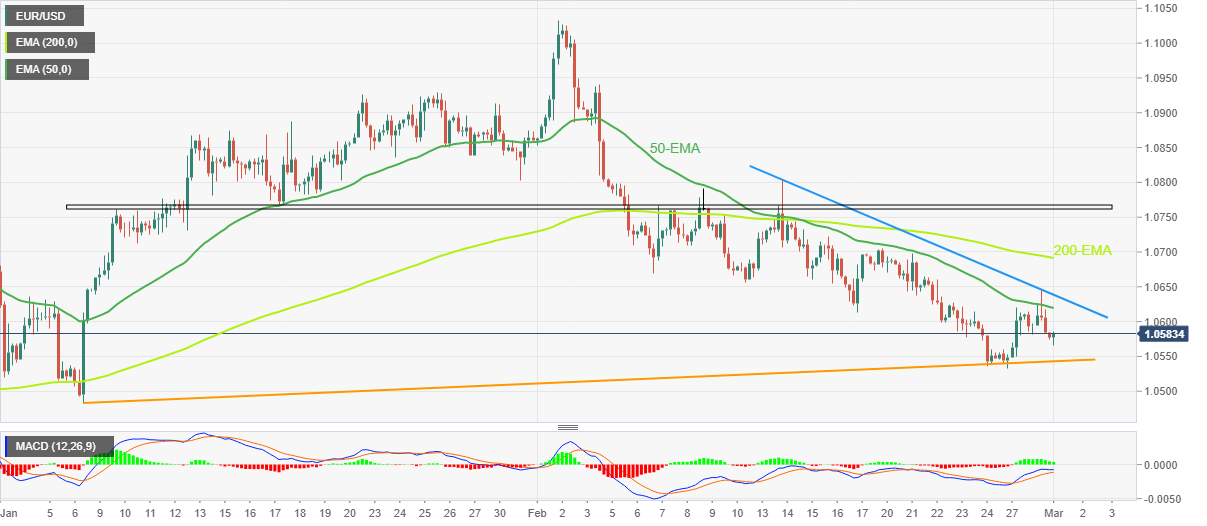
Trend: Further downside expected
- Market sentiment remains sour despite strong China activity data, mixed US statistics.
- Anxiety ahead of key Fed events scheduled during March, hawkish Fed bets join geopolitical woes to weigh on risk appetite.
- S&P 500 Futures stay pressured; US Treasury bond yields grind higher towards multi-day top.
- US S&P Global, ISM Manufacturing PMI for February decorates calendar.
Markets struggle to cheer the upbeat China data during early Wednesday as fears of higher inflation and interest rates join geopolitical concerns about Beijing and Russia to weigh on risk profile.
While portraying the mood, the S&P 500 Futures track Wall Street’s mild losses around 3,960. Further, the US 10-year Treasury bond yields rose two basis points (bps) to 3.93% while the two-year counterpart rises four bps to 4.84% by the press time. With this, both the key bond coupons march towards the three-month high marked in February after printing the biggest monthly gain since September 2022.
Recently, China’s Caixin Manufacturing PMI rose to 51.6 versus 50.2 expected and 49.2 for February. In doing so, the private manufacturing activity gauge traced the official numbers. Earlier in the day, China NBS Manufacturing PMI jumped to 52.6 compared to 50.5 market forecasts and 50.1 prior. More importantly, Non-Manufacturing PMI rallied to 56.3 versus analysts’ expectations of 49.7 and 54.4 previous readings.
Even so, China Finance Minister Liu He said after the data release that the foundation of China's economic recovery is still not stable.
Also a China-linked risk-negative catalyst is a concern that China President Xi Jinping is up for a big overhaul of government agencies, as signaled by Bloomberg, which in turn could increase the tension between the US and China.
Elsewhere, the sustained geopolitical tension between Ukraine and Russia, as well as fears of more supply-chain issues emanating from the UK and China, seems to propel the fears of higher inflation and more rate hikes. As a result, Reuters mentioned that the US central bank is expected to deliver two additional 25-basis-point rate hikes in March and May while adding, “Financial markets are betting on another increase in June.”
It’s worth observing that the recent US data appeared downbeat but failed to move a needle from the hawkish Fed bets. On Tuesday, the US Conference Board’s (CB) Consumer Confidence dropped for the second consecutive month to 102.9 versus 106.0 prior (revised) while US Housing Price Index drops 0.1% in December versus -0.6% market forecasts and -0.1% prior. On the same line, the S&P/Case-Shiller Home Price Indices grew 4.6% YoY during the said month compared to 6.1% market expectations and 6.8% previous readings. Furthermore, Chicago Purchasing Managers’ Index for February eased to 43.6 from 44.3 previous readings and 45.0 market consensus whereas the Richmond Fed Manufacturing Index for the said month eased below 11.0 prior and -5.0 expected to -16.
Looking ahead, US activity data for February can entertain the markets ahead of next week’s monthly jobs report. However, major attention will be given to Federal Reserve (Fed) Chairman Jerome Powell’s testimony and the Federal Open Market Committee (FOMC) monetary policy meeting for clear directions.
Also read: Forex Today: Fears remain the same, USD makes the most out of it
| Raw materials | Closed | Change, % |
|---|---|---|
| Silver | 20.906 | 1.22 |
| Gold | 1827.15 | 0.55 |
| Palladium | 1416.41 | -0.13 |
- AUD/JPY recovers from two-week low after strong China activity data for February.
- Previous support line from January 19 joins bearish MACD signals, steady RSI (14) to challenge bulls.
- Fresh selling needs a clear break of 91.30 to aim for 50-DMA.
AUD/JPY picks up bids to refresh intraday high around 91.80, reversing the initial fall to the fortnight’s low, as strong data from Australia’s key customer favor pair buyers during early Wednesday.
China’s Caixin Manufacturing PMI rose to 51.6 versus 50.2 expected and 49.2 for February. In doing so, the private manufacturing activity gauge traced the official numbers. Earlier in the day, China NBS Manufacturing PMI jumped to 52.6 compared to 50.5 market forecasts and 50.1 prior. More importantly, Non-Manufacturing PMI rallied to 56.3 versus analysts’ expectations of 49.7 and 54.4 previous readings.
With this, the cross-currency pair rises towards the support-turned-resistance line stretched from January 19, close to 92.00 by the press time.
The pair’s data-led bounce, however, lacks support from the MACD and RSI (14), as well as the GDP and inflation numbers from Australia. As a result, the AUD/JPY recovery remains doubtful.
Even if the AUD/JPY pair crosses the 92.00 hurdle, the 200-DMA level surrounding 93.15 appears a tough nut to crack for the bulls.
Alternatively, an immediate horizontal area near 91.30 precedes the 91.00 round figure and the 50-DMA support of near 90.95 to restrict the short-term AUD/JPY downside.
Following that, February’s low of 90.23 and the 90.00 psychological magnet will be in focus.
AUD/JPY: Daily chart
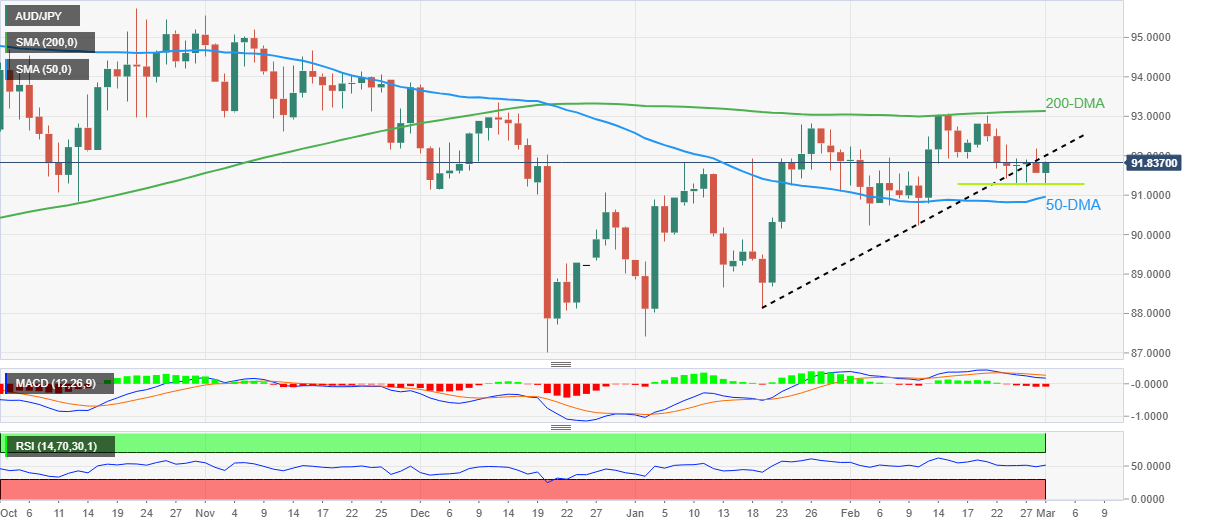
Trend: Limited recovery expected
- USD/CNH has dropped firmly below 6.94 on higher-than-anticipated Caixin Manufacturing PMI data.
- The IHS Markit has reported the Caixin Manufacturing PMI data at 51.6, higher than the expectations of 50.2.
- Investors’ risk appetite has improved marginally after upbeat China data.
The USD/CNH pair has sensed sheer selling pressure after the release of the upbeat Caixin Manufacturing PMI data. The asset has slipped below 6.9400 and is expected to deliver more losses as the US Dollar Index (DXY) has also displayed correction after kissing a high of 104.60.
The IHS Markit has reported the Caixin Manufacturing PMI data at 51.6, higher than the expectations of 50.2 and the former release of 49.2. The upbeat PMI data has infused confidence among the market participants that the Chinese economy is effectively on the path of economic recovery after a long lockdown period.
Apart from that, China’s National Bureau of Statistics (NBS) Manufacturing PMI (Feb) has landed higher at 52.6 vs. the consensus of 50.5 and the prior release of 50.1. The Services Manufacturing PMI has exploded to 56.3 against 54.4 released in January while the street was anticipating a downbeat figure at 49.7.
Upbeat China’s economic activity data has improved the risk appetite of the market participants. S&P500 futures have trimmed half of the losses reported in the Asian session. The US Dollar Index (DXY) has corrected to near 104.55 and is likely to remain on tenterhooks ahead of the release of the United States ISM Manufacturing PMI data. As per the projections, the economic data is seen at 48.0 from the former release of 47.4. Apart from that, the New Orders Index that conveys forward demand is expected to rebound to 43.7 from the prior figure of 42.5.
- AUD/USD rebounds from multi-day low on upbeat data from key customer.
- China’s official and Caxin PMIs flash upbeat figures for February.
- Downbeat Aussie GDP, inflation data joined risk-off mood to print recent trough.
AUD/USD picks up bids to reverse early losses to around 0.6730 after China data pleased Aussie bulls, after an initial disappointment from the statistics at home, during early Wednesday.
China’s Caixin Manufacturing PMI rose to 51.6 versus 50.2 expected and 49.2 for February. In doing so, the private manufacturing activity gauge traced the official numbers. Earlier in the day, China NBS Manufacturing PMI jumped to 52.6 compared to 50.5 market forecasts and 50.1 prior. More importantly, Non-Manufacturing PMI rallied to 56.3 versus analysts’ expectations of 49.7 and 54.4 previous readings.
Also read: China's Caixin Manufacturing PMI expands to 51.6 in February vs. 50.2 expected
It’s worth noting that the downbeat prints of Australia’s fourth-quarter (Q4) Gross Domestic Product (GDP) and Monthly Consumer Price Index (CPI) data for January earlier drowned the AUD/USD pair towards refreshing the two-month low. Talking about that, Aussie Q4 GDP came in lower than expected 0.8% and 0.6% prior readings while flashing 0.5% quarterly growth. The yearly GDP growth, however, matches 2.7% market consensus, down from 5.9% prior. On the same line was the monthly CPI data for January as it dropped to 7.4% versus 8.0% expected and 8.4% prior.
Elsewhere, fears of more inflation and higher rates seem to have weighed on the market sentiment and propelled the US Treasury bond yields, while also exerting downside pressure on the stock futures. The same joins chatters that China President Xi Jinping is up for a big overhaul of Chinese government agencies and a likely increase in the US-China tension, signaled by Bloomberg.
To sum up, AUD/USD cheers upbeat data from the key customer to lure buyers but the upside bias remains absent amid the hawkish Fed concerns and inflation fears. That said, the US ISM Manufacturing PMI for February will be important for intraday directions.
Technical analysis
AUD/USD bulls need validation from the 200-DMA hurdle surrounding 0.6800 to retake control.
- NZD/USD bulls move back in following firm China data.
- NZD/USD eyes a fresh high for the day.
NZD/USD was under pressure by some 0.2% on the day following in the footsteps of the Australian Dollar that tumbled on a batch of disappointing data on Wednesday. However, at the time of writing, NZD/USD is trading at 0.6185, off its lows on a positive spin from China.
Australia reported Gross Domestic Product and the monthly Consumer Price Index as follows:
- Australia Weighted CPI YoY Jan: 7.4% (est 8.0%, prev 8.4%).
- Australia GDP SA QoQ Q4: 0.5% (est 0.8%, prev 0.6%) - Australia GDP YoY Q4: 2.7% (est 2.7%, prev 5.9%).
The outcome has weighed heavily on the Aussie that now has shorts moving in for the first time this week following Monday's initial balance, pulling the Kiwi lower in a failed upside breakout scenario. This potentially leaves prospects of a sell-high opportunity for the London and US sessions as shorts dominate the space in a strong US Dollar environment. The greenback is being supported on the US rate futures that have priced in the Federal Reserve's target policy rate peaking at 5.4% in September and the Fed's policy rate is currently in a 4.50%-4.75% target range.
Meanwhile, we have some data coming out from China today that could be supportive. So far, China's Manufacturing Purchasing Managers Index (PMI) and the official Non-manufacturing PMIs have been released as follows:
- China Manufacturing PMI Feb: 52.6 (est 50.6, prev 50.1).
- China Non-Manufacturing PMI Feb: 56.3 (est 54.9, prev 54.4).
AUD found some solace here which would also be expected to support the Kiwi. Chinese Caixin manufacturing PMI came in with an actual 51.6 (forecast 50.7, previous 49.2) which is also supportive.
- USD/CAD is struggling to extend gains above 1.3660 as USD Index corrects, upside bias still intact.
- The Canadian Dollar is facing immense offers after a downbeat Gross Domestic Product (GDP) (Q4) data.
- Oil prices are reviving firmly on upbeat Caixin Manufacturing PMI data.
The USD/CAD pair has sensed a halt in its upside momentum near 1.3660 in the Asian session. The upside momentum in the Loonie asset has cooled down a bit, however, the upside bias is still intact. The Loonie asset is expected to recapture the previous week’s high around 1.3665 as the US Dollar is getting strengthened further led by rising fears of further policy tightening by the Federal Reserve (Fed).
Losses have deepened by the S&P500 futures in the Asian session as the United States recession has come into the picture amid hawkish Fed bets. The US Dollar Index (DXY) has sensed barricades around 104.70, however, the risk aversion theme is still solid.
The yields offered on US treasury bonds have strengthened further as investors are expecting a mega rate hike from the Fed considering February’s economic indicators, which are promising a rebound in the inflationary pressures. The 10-year US Treasury yields have scaled to 3.94%, at the time of writing.
Meanwhile, the Canadian Dollar is facing immense offers after a downbeat Gross Domestic Product (GDP) (Q4) data. The annualized GDP remained flat lower than the expectations of 1.5% and the former release of 2.3%. While the monthly GDP (Dec) contracted by 0.1% vs. a flat consensus.
Flat GDP numbers might not be lucrative for Canada’s economic outlook but are favorable for the Bank of Canada (BoC), which is making efforts in bringing down persistent inflation. It is worth noting that BoC Governor Tiff Macklem has already paused the policy tightening spell after pushing rates to 4.5%, considering that the current monetary policy is restrictive enough to trim inflationary pressures for now.
On the oil front, oil prices have rebounded firmly after an upbeat China’s Caixin Manufacturing PMI data. The economic data has landed at 51.6, higher than the consensus of 50.2 and the former release of 49.2. It is worth noting that Canada is the leading exporter of oil to the United States and higher oil prices will strengthen the Canadian Dollar.
China's Caixin Manufacturing PMI returns to expansion with 51.6 in February vs. 50.2 expected and 49.2 previous, courtesy of the renewed increases in output, new orders and employment.
Key points
Suppliers' delivery times improve at quickest rate for eight years.
Business confidence strengthens to near two-year high.
Wang Zhe, Senior Economist at Caixin Insight Group said, “The recovery in manufacturing activity came as the most recent wave of Covid-19 infections subsided.”
“Both manufacturing supply and demand expanded last month, as production gradually returned to normal while both domestic and external demand improved after a Covid policy shift,” Wang added.
AUD/USD erases losses above 0.6700
The upbeat print of the Chinese Manufacturing PMI has saved the day for the Aussie Dollar, as AUD/USD is erasing Australian GDP-induced losses to trade flat at 0.6726, at the time of writing.
- GBP/USD remains pressured after reversing from the short-term key resistance confluence.
- Convergence of 200-EMA, one-month-old descending trend line challenges Cable buyers.
- Double bottoms around 1.1920-15 restricts short-term downside of the pair.
GBP/USD holds lower ground near the intraday bottom surrounding 1.2010, picking up bids of late, as bears keep the reins during early Wednesday. In doing so, the Cable pair justifies the previous day’s pullback from an important resistance, as well as the looming bear cross on the MACD.
While the failure to cross the 1.2110 hurdle, comprising 200-Exponential Moving Average (EMA) and a one-month-old downward-sloping resistance line, keeps the GBP/USD bears hopeful, a clear break of the 1.2100 threshold becomes necessary for the seller’s conviction.
Following that, the “double bottom” bullish formation around 1.1920-15 will be crucial to watch as a downside break of the same won’t hesitate to drag the GBP/USD price towards January’s low near 1.1840.
Alternatively, the pair’s recovery past the 1.2110 resistance confluence needs to cross a one-week-long horizontal resistance near 1.2150 to convince GBP/USD buyers.
In that case, the mid-February swing high of 1.2270 appears the imminent target for the bulls ahead of aiming for the previous monthly top surrounding 1.2400.
It should, however, be noted that the pair’s sustained trading beyond 1.2400 will be difficult as the multiple tops around 1.2445-50 could challenge the bulls afterward.
To sum up, GBP/USD is likely to decline further but the downside room appears limited.
GBP/USD: Four-hour chart
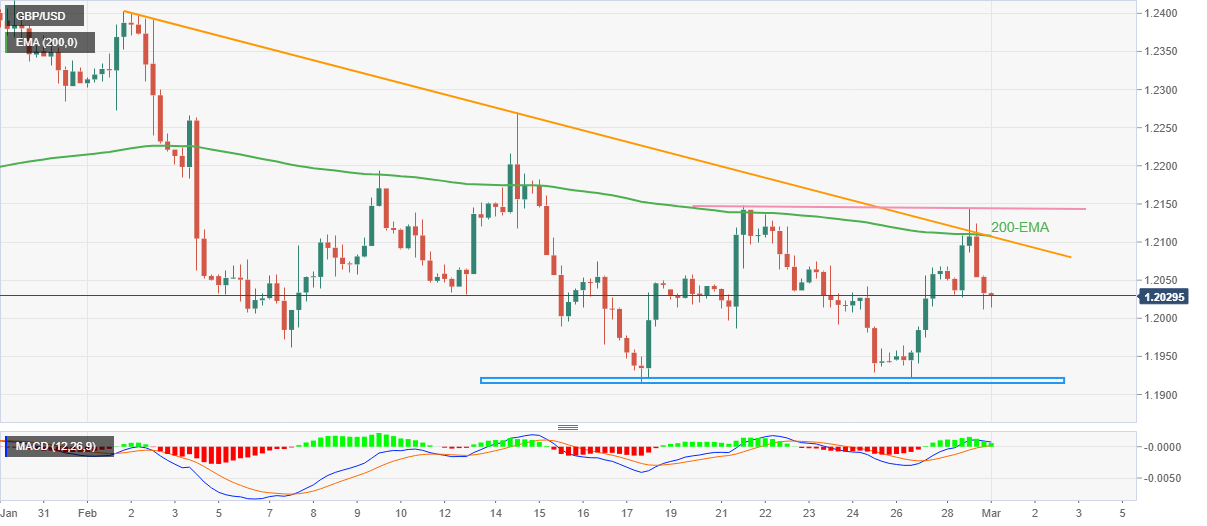
Trend: Limited downside expected
Bank of Japan (BoJ) board member Junko Nakagawa is making his scheduled speech on Wednesday, noting that “easy monetary policy is important for the time being, as it supports the economy.
Additional comments
BoJ will maintain easy policy while taking steps to curb side-effects.
Recent rise in inflation driven by spike in prices for a handful of goods, which will likely clearly slow their pace of increase.
The Bank's decision to widen the band around its yield target has led to a rise in yields, but its merits of improving biond markets outweighs.
Japan's economy is likely to continue to expand above potential growth.
If corporate inflation expectations overshoot, that could prod more firms to pass on higher costs to customers.
There is strong uncertainty on how much wages will rise.
There is risk prices may come under downward pressure if wage hikes do not proceed as much as expected.
Focusing on how much wage hikes will spread among smaller firms.
BoJ will maintain easy policy while taking steps to curb side-effects.
Recent rise in inflation driven by spike in prices for a handful of goods, which will likely clearly slow their pace of increase.
Market reaction
USD/JPY is defending minor bids on the above dovish BoJ commentary. The pair is adding 0.06% on the day to trade at 136.27, as of writing.
China's Manufacturing Purchasing Managers Index (PMI) and the official Non-manufacturing PMIs have been released as follows:
- China Manufacturing PMI Feb: 52.6 (est 50.6, prev 50.1).
- China Non-Manufacturing PMI Feb: 56.3 (est 54.9, prev 54.4).
AUD/USD update
AUD/USD has been trying to correct but the data has done little to help dig the bulls out of a hole despite sizeable beats so far. However, it is early days since the release and the bulls could find a lifeline there.
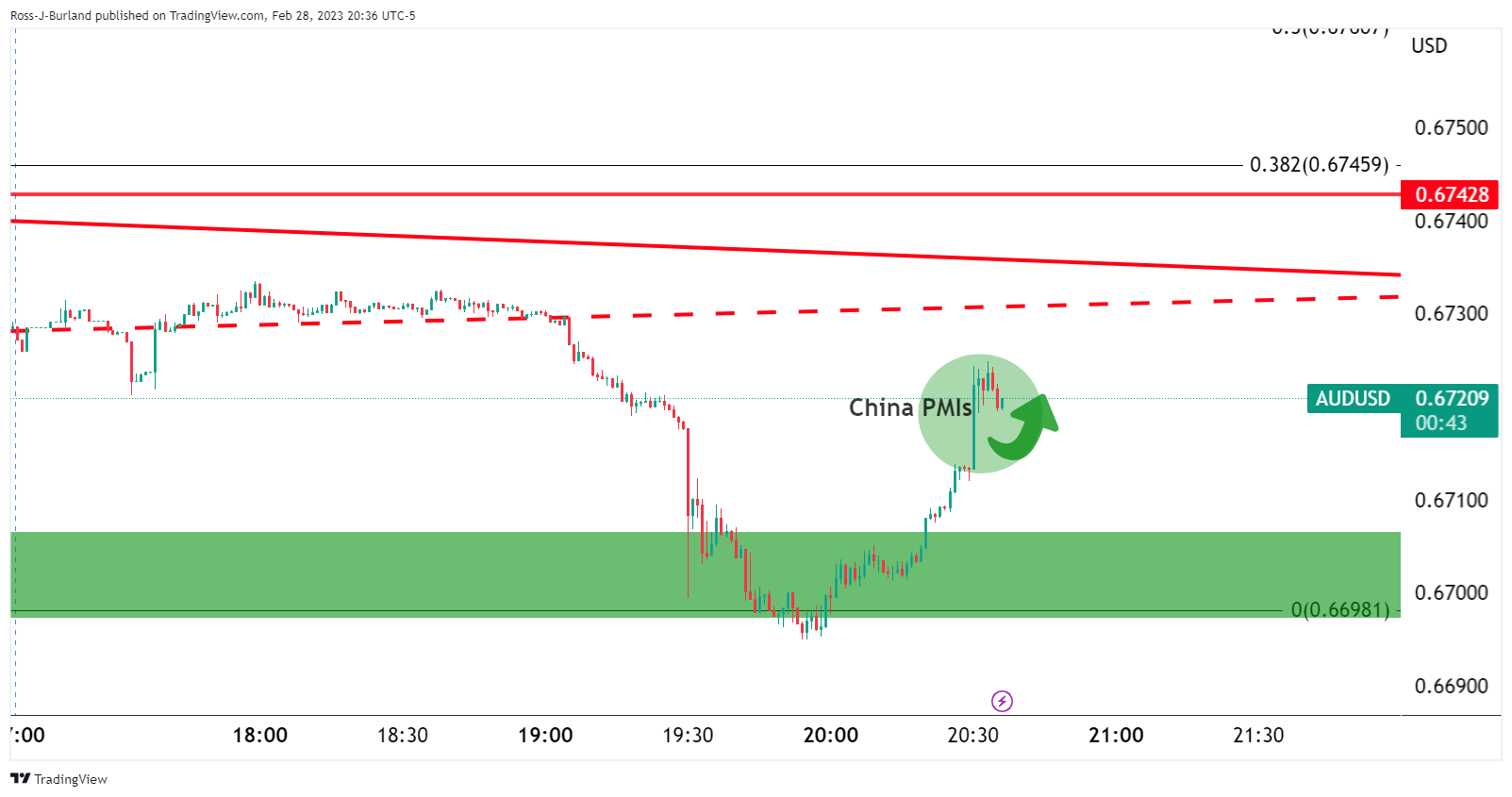
Earlier, Australia's data dump, including Gross Domestic Product and the monthly Consumer Price Index weighed on the Aussie as follows:

Consequently, AUD/USD has now broken a trendline support and was resisted by the 50% mean reversion of the prior bearish impulse on Tuesday:

Despite the positive upturn in data from China PMIs, the combination of today's Chinese and Australian data would be expected to continue to weigh on the Aussie as aggressive Australian monetary tightening is likely cooling the Australian economy. This could cast a more dovish sentiment over the Reserve Bank of Australia.
About the China PMIs
The Manufacturing Purchasing Managers Index (PMI) released by the China Federation of Logistics and Purchasing (CFLP) studies business conditions in the Chinese manufacturing sector. Any reading above 50 signals expansion, while a reading under 50 shows contraction. As the Chinese economy has influence on the global economy, this economic indicator would have an impact on the Forex market.
The official non-manufacturing PMI, released by China Federation of Logistics and Purchasing (CFLP), is based on a survey of about 1,200 companies covering 27 industries including construction, transport and telecommunications. It's the level of a diffusion index based on surveyed purchasing managers in the services industry and if it's above 50.0 indicates industry expansion, below indicates contraction.
In recent trade today, the People’s Bank of China (PBOC) set the yuan at 6.9400 vs. the estimated 6.9409.
About the fix
China maintains strict control of the yuan’s rate on the mainland.
The onshore yuan (CNY) differs from the offshore one (CNH) in trading restrictions, this last one is not as tightly controlled.
Each morning, the People’s Bank of China (PBOC) sets a so-called daily midpoint fix, based on the yuan’s previous day's closing level and quotations taken from the inter-bank dealer.
- Gold price retreats from the highest levels in one week, renews intraday low of late.
- Firmer United States Treasury bond yields underpin US Dollar strength and weigh on XAU/USD price.
- Hawkish Fed concerns, inflation fears keep Gold bears hopeful as the key March month begins.
- US ISM Manufacturing, Services PMI will direct immediate XAU/USD moves.
Gold price (XAU/USD) takes offers to refresh intraday low around $1,823 while paring the weekly gains amid early Wednesday. In doing so, the bright metal bears the burden of the firmer United States Treasury bond yields, as well as the US Dollar, while paying little heed to the recently downbeat US data. The XAU/USD retreat could be linked to the hopes of worsening inflation woes and higher interest rates, as well as fears emanating from China.
Gold price drops on strong United States Treasury bond yields
Gold price returns to the bear’s table, after an absence for two days, as the United States Treasury bond yields keep portraying the market’s fears of inflation and higher rates. That said, the benchmark 10-year Treasury bond yields rise three basis points (bps) to 3.94% while the two-year counterpart rises four bps to 4.84% by the press time. It’s worth noting that both these key bond coupons gained the most since September 2022 during the last month.
It’s worth noting that the higher inflation woes could be linked to the sustained geopolitical tension between Ukraine and Russia, as well as fears of more supply-chain issues emanating from the UK and China. Adding strength to the fears of more costs could be the late effects of previously announced easy money policies and government stimulus to defend the respective economies from Covid, as well as the geopolitical woes.
That said, Federal Reserve (Fed) officials appear the most hawkish on interest rates after witnessing the latest bout of strong US data while the other key central bankers, namely from the European Central Bank (ECB) and Bank of England (BoE), also vouch for the higher rates.
While the yields are up, the US Dollar Index (DXY) also begins March month on the positive side after snapping the four-month downtrend in February. That said, the DXY renews intraday high above 105.00 by the press time.
Pre-Fed fears also weigh on XAU/USD
Apart from the strong United States Treasury bond yields and the US Dollar, anxiety ahead of the key testimony from Federal Reserve (Fed) Chairman Jerome Powell and the Federal Open Market Committee (FOMC) monetary policy meeting also weighs on the sentiment and the Gold price. It should be noted that the recent headlines from Bloomberg suggesting a big overhaul of Chinese government agencies and a likely increase in the US-China tension seem to add to the market’s risk-off mood and please the XAU/USD sellers. While portraying the mood, S&P 500 Futures track Wall Street’s mild losses, down 0.47% intraday near 3,960.
US data fails to please Gold buyers
It’s worth noting that Tuesday’s downbeat prints of the second-tier US data failed to lure the Gold buyers amid a broad risk-off mood and the firmer US Dollar. That said, the US Conference Board’s (CB) Consumer Confidence dropped for the second consecutive month to 102.9 versus 106.0 prior (revised) while US Housing Price Index drops 0.1% in December versus -0.6% market forecasts and -0.1% prior. On the same line, the S&P/Case-Shiller Home Price Indices grew 4.6% YoY during the said month compared to 6.1% market expectations and 6.8% previous readings. Furthermore, Chicago Purchasing Managers’ Index for February eased to 43.6 from 44.3 previous readings and 45.0 market consensus. Additionally, the Richmond Fed Manufacturing Index for the said month eased below 11.0 prior and -5.0 expected to -16 for the said month.
Moving on, Caixin Manufacturing PMI for February precedes the US ISM Manufacturing PMI for the said month to direct intraday moves of the Gold price. However, major attention should be given to the risk catalysts for clear directions.
Gold price technical analysis
The Gold price marks another pullback from the 50-bar Simple Moving Average (SMA), retreating towards the two-week-old resistance-turned-support near $1,819 by the press time.
Even so, the metal’s sustained break of the immediate resistance line joins the bullish signals from the Moving Average Convergence and Divergence (MACD) indicator to keep Gold buyers hopeful. Adding strength to the upside bias for the XAU/USD could be the upbeat Relative Strength Index (RSI) line placed at 14.
It’s worth noting that the recent low surrounding $1,805 and a downward-sloping support line from early February, close to $1,785 by the press time, could lure the XAU/USD bears past $1,819.
Alternatively, an upside break of the 50-SMA level surrounding $1,819 needs validation from multiple tops marked during February around $1,848, $1,870 and $1,890.
Gold price: Four-hour chart
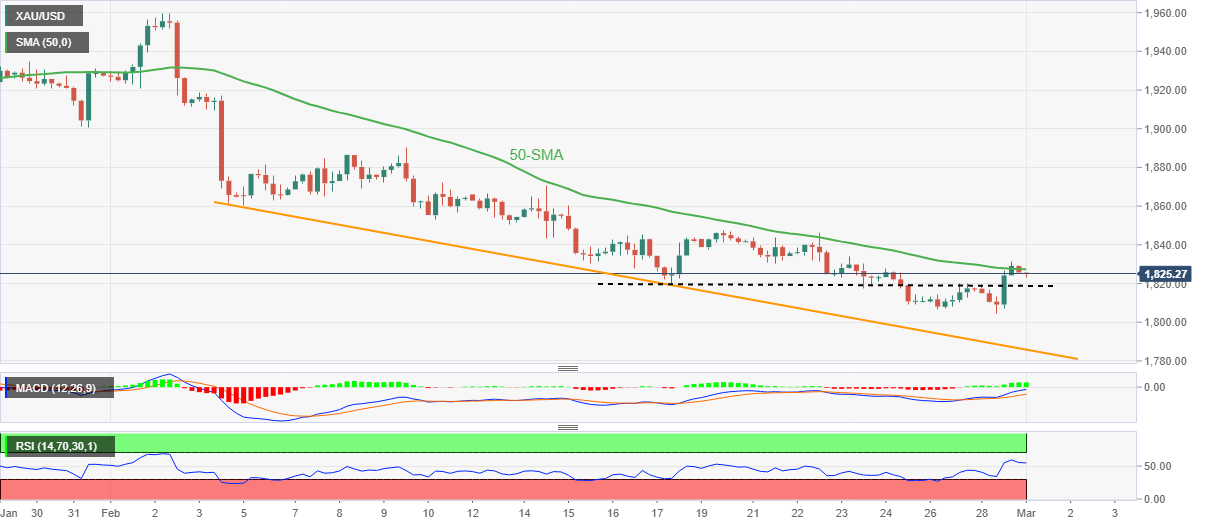
Trend: Limited downside expected
- AUD/NZD has refreshed the monthly low below 1.0850 amid a decline in Australian inflation figures.
- Australia’s monthly CPI has dropped dramatically to 7.4% from the consensus of 8.0% and the prior release of 8.4%.
- The New Zealand Dollar and the Australian Dollar will remain in action amid the release of the Caixin Manufacturing PMI data.
The AUD/NZD pair has been significantly offered by the market participants after a sheer drop in the Australian monthly Consumer Price Index (CPI) data. Longer-period patience from Reserve Bank of Australia (RBA) policymakers looks fruitful now as the monthly CPI has dropped dramatically to 7.4% from the consensus of 8.0% and the prior release of 8.4%.
The street was considering the Australian economy as a laggard in the FX domain, which has not shown signs of deceleration in the pace of soaring inflation yet. No doubt, RBA Governor Philip Lowe has already pushed the Official Cash Rate (OCR) to 3.35% to bring down sticky inflation, more rate hikes are still favored as it would be premature considering a victory in the battle against galloping price pressures.
Apart from the Australian inflation data, Gross Domestic Product (GDP) (Q4) figures landed lower than anticipation. The Australian Bureau of Statistics has reported a decline in the GDP (Q4) data to 0.5% from the consensus of 0.8% and Q3 figure of 0.6%. On an annualized basis, the GDP has remained in line with expectations at 2.7%. A decline in GDP numbers also showcases lower demand from households, which will trim inflation projections ahead.
The New Zealand Dollar and the Australian Dollar will remain in action amid the release of the Caixin Manufacturing PMI data. As per the estimates, the IHS Markit will report an improvement in the economic data to 50.2 against the prior release of 49.2.
This week, New Zealand’s Retail Sales (Q4) data contracted by 0.6% while the street was expecting an expansion of 1.5%. A decline in the households’ demand is likely to soften kiwi inflation ahead as firms will be forced to offer products and services at lower prices to match the current demand levels.
- AUD/USD has dropped sharply to near 0.6700 as a sheer decline in Australian monthly CPI and subdued GDP has trimmed hawkish RBA bets.
- Australian monthly CPI has dropped significantly to 7.4% from the expectations of 8.0% and the prior release of 8.4%.
- The Australian GDP (Q4) has landed at 0.5% vs. the 0.6% released in Q3.
The AUD/USD pair has slipped sharply to near 0.6700 as the Australian Bureau of Statistics has reported mixed Gross Domestic Product (GDP) (Q4) data. The GDP data has landed at 0.5% in Q4, lower than the consensus of 0.8% and Q3 figure of 0.6%. On an annualized basis, the GDP has remained in line with expectations at 2.7%.
The monthly Consumer Price Index (CPI) (Jan) has dropped significantly to 7.4% from the expectations of 8.0% and the prior release of 8.4%. A mammoth decline in the inflation data is going to provide a big relief to Reserve Bank of Australia (RBA) policymakers.
RBA Governor Philip Lowe might continue its policy-tightening spell as the road to price stability is far from over.
A recent survey from Bloomberg claims that the Australian economy will fall into a recession while the United States economy is expected to dodge the recession situation. It is extremely difficult to predict a terminal rate for a central bank whose economy has not shown any evidence of inflation softening yet. Therefore, the chances of an Australian recession are extremely higher as the roadmap for achieving price stability in the Australian economy is full of struggles.
Going forward, the release of the Caixin Manufacturing PMI data will keep the Australian Dollar volatile. According to the consensus, IHS Markit will report an improvement in the Caixin Manufacturing PMI at 50.2, higher than the prior release of 49.2. The Chinese economy is on the path of a quick recovery after the rollback of lockdown curbs, therefore, a decent performance is anticipated by the market participants.
It is worth noting that Australia is the leading trading partner of China and upbeat PMI figures will strengthen the Australian Dollar ahead.
Meanwhile, the risk aversion theme is getting strengthened further amid bearish cues from the S&P500 futures. The 500-US stocks basket futures have ramped up their losses in the Asian session after a weak Tuesday as fears of more rates by the Federal Reserve (Fed) are deepening worries of a slowdown ahead. The US Dollar Index (DXY) has sensed a minor loss in the upside momentum near 104.60, however, the upside bias has not been ruled out yet.
- AUD/JPY takes offers to add to previous pullback from one-week high after upbeat Aussie GDP.
- Australia Q4 GDP eased to 0.5% QoQ versus 0.8% expected and 0.6% prior, monthly CPI eases for January.
- Market sentiment remains depressed as yields regain upside momentum after sluggish end to February.
- China PMIs, BoJ talks and risk catalysts eyed for clear directions.
AUD/JPY drops to 91.36 while refreshing the intraday low on lower-than-expected Aussie economic growth during early Wednesday. In doing so, the risk-barometer pair also takes clues from the market’s sour sentiment amid hopes of higher rates and worsening inflation fears. With this, the cross-currency pair also pays little heed to the dovish bias surrounding the Bank of Japan (BoJ), as signalled by the incoming policymakers’ latest speeches.
Australia’s fourth-quarter (Q4) Gross Domestic Product (GDP) figures came in lower than expected 0.8% and 0.6% prior readings while flashing 0.5% quarterly growth. The yearly GDP growth, however, matches 2.7% market consensus, down from 5.9% prior. On the same line is the nation’s monthly Consumer Price Index (CPI) data for January as it dropped to 7.4% versus 8.0% expected and 8.4% prior.
Also read: Breaking: Aussie data dump crashes AUD/USD
Earlier in the day, Australia’s S&P Global Manufacturing PMI for February improved to 50.5 versus 50.1 analysts’ expectations.
Apart from the downbeat Aussie GDP, the market’s sour sentiment also weighed on the AUD/JPY pair. The same contradicts the dovish BoJ talks.
Risk profile remains weak during early Wednesday as the all-important March month begins, which comprises Federal Reserve (Fed) Chairman Jerome Powell’s testimony and the Federal Open Market Committee (FOMC) monetary policy meeting. It should be noted that the escalating fears of more supply crunch and inflation pressure also contribute to the risk-off mood.
While portraying the same, S&P 500 Futures track Wall Street’s mild losses whereas the US 10-year Treasury bond yields regain upside momentum targeting the 4.0% hurdle after witnessing a pullback late Tuesday.
Looking forward, China’s official activity data for February precedes Caixin Manufacturing PMI for the said month to direct intraday AUD/JPY moves. However, major attention should be given to the risk catalyst and the Bank of Japan (BoJ) talks as the incoming board struggles to defend the Japanese central bank’s ultra-easy monetary policy.
Technical analysis
A daily closing below the six-week-old ascending support line, now resistance around 92.00, keeps AUD/JPY bears hopeful of probing the previous monthly low surrounding 90.90.
Australia's data dump, including Gross Domestic Product and the monthly Consumer Price Index have been released and have crushed AUD/USD by around 20 pips on the miss of expectations.
- Australia Weighted CPI YoY Jan: 7.4% (est 8.0%, prev 8.4%).
- Australia GDP SA QoQ Q4: 0.5% (est 0.8%, prev 0.6%) - Australia GDP YoY Q4: 2.7% (est 2.7%, prev 5.9%).
AUD/USD update
As a result, AUD/USD dropped as follows:

AUD/USD has now broken a trendline support, invalidating the thesis for a stronger correction in the meantime, resisted by the 50% mean reversion of the prior bearish impulse:

The data would be expected to continue to weigh on the Aussie as aggressive monetary tightening is likely cooling the economy and therefore cast a move dovish sentiment over the Reserve Bank of Australia.
About the Gross Domestic Product
The Gross Domestic Product released by the Australian Bureau of Statistics is a measure of the total value of all goods and services produced by Australia. The GDP is considered as a broad measure of the economic activity and health. A rising trend has a positive effect on the AUD, while a falling trend is seen as negative (or bearish) for the AUD.
About the monthly Consumer Price Index
The monthly Consumer Price Index (YoY), released by the RBA and republished by the Australian Bureau of Statistics, is a measure of price movements by the comparison between the retail prices of a representative shopping basket of goods and services. The purchasing power of AUD is dragged down by inflation. The CPI is a key indicator to measure inflation and changes in purchasing trends. A high reading is seen as positive (or bullish) for the AUD, while a low reading is seen as negative (or bearish). Note: This indicator started to be published in 2022 and it updates the price change for the last 12 months in Australia in a monthly basis, instead of the quarterly period of the main Australian CPI.
| Index | Change, points | Closed | Change, % |
|---|---|---|---|
| NIKKEI 225 | 21.6 | 27445.56 | 0.08 |
| Hang Seng | -157.57 | 19785.94 | -0.79 |
| KOSPI | 10.21 | 2412.85 | 0.42 |
| ASX 200 | 33.6 | 7258.4 | 0.47 |
| FTSE 100 | -58.82 | 7876.28 | -0.74 |
| DAX | -16.29 | 15365.14 | -0.11 |
| CAC 40 | -27.62 | 7267.93 | -0.38 |
| Dow Jones | -232.39 | 32656.7 | -0.71 |
| S&P 500 | -12.09 | 3970.15 | -0.3 |
| NASDAQ Composite | -11.44 | 11455.54 | -0.1 |
- EUR/USD bears pile in and burn stubborn bulls.
- Euro shorts are moving in on 1.0570 as US Dollar firms.
EUR/USD slid on Tuesday to a low of 1.0573 but that was not the whole story. Earlier in the day, the Euro found bids on the back of higher-than-expected French inflation data, which sent short-dated euro zone yields to their highest in at least a decade. Then, at the start of the US day, the pair rallied to 1.0645 when US data showed signs that the Fed's rate hikes were beginning to have their intended effect and in contrast to a slew of prior inflationary outcomes.
''Base effects from last year’s Russian invasion of Ukraine should start to bring annual inflation down from March, but the ECB will be primarily concerned with sequential monthly inflation increases,'' analysts at ANZ Bank said. ''German and euro area inflation data will be released in coming days and will provide a more complete inflation backdrop for the March Governing Council meeting.''
Meanwhile, the US Dollar was weighed when US Consumer Confidence unexpectedly fell in February, dropping to 102.9 from a 106 reading in January, well below the forecasted 108.5. On top of that, the S&P CoreLogic Case Shiller national home price index rose just 5.8% year-on-year but dropped 0.5% in December while the Chicago PMI business survey for February also came in weaker-than-expected.
Looking ahead, the US Nonfarm Payrolls employment data for February on March 10 and then the Consumer Price Index on March 14 will be key drivers in terms of the expectations over the Fed's interest rate policy. Meanwhile, for the immediate future, ISM manufacturing PMI should continue reflecting the fragility of the sector in February (market f/c: 45.5) while the final estimate to the S&P Global manufacturing PMI will likely confirm this too, analysts at Westpac said. ''Meanwhile, construction spending is expected to remain subdued in January given softening demand (market f/c: 0.2%). Minneapolis Federal Reserve president Neel Kashkari is also due to speak.''
- EUR/JPY picks up bids to reverse the previous day’s pullback from 10-week high.
- Strong inflation data from Spain, France join hawkish ECB talks to keep buyers hopeful.
- Incoming BoJ officials defend easy money policy to favor JPY bears.
- Preliminary readings of Germany’s HICP data for February eyed for fresh impulse.
EUR/JPY regains upside momentum past 144.00 as Tokyo opens on Wednesday. In doing so, the cross-currency pair picks up bids to dash the previous day’s U-turn from the highest levels since late December amid cautious optimism in the market.
That said, the quote reversed from the multi-day high on Tuesday as the Yen pair cheered mixed economics while struggling to respect overall hawkish comments from the incoming Bank of Japan (BoJ) officials. However, upbeat inflation data from France and Spain renewed the quote’s upside momentum afterward.
It should be noted that the incoming Bank of Japan (BoJ) Deputy Governor Shinichi Uchida testified before the Japanese parliament’s Upper House while defending the central bank’s easy money policy. In doing so, Uchida rules out hopes of altering the 2.0% inflation target, as well as hopes of bolstering the Yield Curve Control (YCC) policy.
Talking about the data, downbeat prints of Japan's Industrial Production (IP) for January contrasted with a welcome growth in the nation’s Retail Trade numbers but failed to provide any clear directions to the USD/JPY. That said, Japan’s IP shrunk 4.6% in January versus -2.6% expected and 0.3% prior growth. However, the Retail Trade grew 1.9% MoM on a seasonally adjusted basis from 1.1% prior and -0.2% market forecasts.
Elsewhere, preliminary readings of Spanish and French Consumer Price Index (CPI) details for February marked upbeat outcomes and bolstered the hawkish concerns surrounding the European Central Bank’s (ECB) next move, which is in contrast with the BoJ bias.
As a result, mostly downbeat Japanese data joins the monetary policy divergence between the ECB and the BoJ to keep the EUR/JPY buyers hopeful.
Moving on, a light calendar in Japan may allow the EUR/JPY bulls to keep the reins during early Wednesday. However, the first readings of Germany’s key inflation gauge for February, namely the Harmonized Index of Consumer Prices (HICP), could challenge the pair’s upside momentum on missing the upbeat 0.7% MoM forecasts, versus 0.5% prior.
Technical analysis
Unless providing a daily close below the 100-day Exponential Moving Average (EMA), around 142.10 by the press time, the EUR/JPY pair appears capable of crossing the downward-sloping resistance line from late October 2022, close to 144.50 at the latest.
- USD/JPY is advancing towards 137.00 amid the Japanese Yen’s weakness due to dovish BoJ commentaries.
- The major contributor to the elevated inflation in the Japanese economy is the higher import prices.
- S&P500 futures have extended their losses after a bearish Tuesday, portraying a further decline in investors’ risk appetite.
The USD/JPY pair has extended its recovery above 136.26 in the Asian session. The responsive buying action in the asset from 135.80 looks so confident amid weakness in the Japanese Yen as Bank of Japan (BoJ) policymakers are considering the current expansionary monetary policy as appropriate to maintain the 2% inflation confidently.
National Consumer Price Index (CPI) in Japan has reached to multi-decade high near 4.2%. However, the major contributor to the elevated inflation is the higher import prices, not the strong wage gains and any resilience in the domestic demand. Therefore, the BoJ policymakers are advocating more stimulus in the economy so that the pre-pandemic growth levels could be achievable.
After dovish commentary from BoJ Governor Nominee Kazuo Ueda, BoJ Deputy Governor Ryozo Himino favored the sustenance of easy monetary policy to spurt the overall demand in the Japanese economy. However, he assured that a time will come when an exit from the ultra-loose monetary policy will be optimal.
Meanwhile, the risk profile is also not supporting the risk-sensitive assets as more rate hikes are highly expected from the Federal Reserve to strengthen its competence against the stick United States inflation. S&P500 futures have extended their losses after a bearish Tuesday, portraying a further decline in the risk appetite of the market participants.
The US Dollar Index (DXY) is gathering strength to stretch its upside momentum above 104.60 ahead. The USD Index is expected to display a power-pack action after the release of the US ISM Manufacturing PMI data. The street is anticipating a continuation of the contraction spell ahead.
| Pare | Closed | Change, % |
|---|---|---|
| AUDUSD | 0.67289 | 0.02 |
| EURJPY | 144.047 | -0.28 |
| EURUSD | 1.05745 | -0.28 |
| GBPJPY | 163.757 | -0.19 |
| GBPUSD | 1.20219 | -0.26 |
| NZDUSD | 0.61852 | 0.36 |
| USDCAD | 1.36461 | 0.53 |
| USDCHF | 0.94201 | 0.82 |
| USDJPY | 136.223 | 0.07 |
- US Dollar Index seesaws around monthly support line as bulls keep the reins.
- Softer US data, mixed geopolitical headlines challenge DXY bulls.
- Upbeat European data contrast with hawkish Fed rate concerns as US PMIs loom.
- Bulls remain hopeful amid expectations of worsening inflation woes.
US Dollar Index (DXY) bulls flirt with the 105.00 hurdle during Wednesday’s sluggish Asian session, following a stellar rebound marked a few hours ago. In doing so, the US Dollar’s gauge versus the six major currencies portrays the market’s cautious mood as traders brace for the key data/events lined up during the all-important March month, comprising Federal Reserve (Fed) Chairman Jerome Powell’s speech and Fed’s monetary policy meeting.
The DXY witnessed a pullback early Tuesday amid cautious optimism in the market and month-end consolidation. Adding strength to the pullback moves was mixed US data. However, hawkish concerns surrounding Fed’s interest rate moves recalled the US Dollar buyers afterward. It’s worth noting that the DXY marked the biggest monthly gains since September 2022, not to forget that it snapped a four-month downtrend, in February.
That said, the US Conference Board’s (CB) Consumer Confidence dropped for the second consecutive month to 102.9 versus 106.0 prior (revised) while US Housing Price Index drops 0.1% in December versus -0.6% market forecasts and -0.1% prior. On the same line, the S&P/Case-Shiller Home Price Indices grew 4.6% YoY during the said month compared to 6.1% market expectations and 6.8% previous readings. Furthermore, Chicago Purchasing Managers’ Index for February eased to 43.6 from 44.3 previous readings and 45.0 market consensus. Additionally, the Richmond Fed Manufacturing Index for the said month eased below 11.0 prior and -5.0 expected to -16 for the said month.
Even so, Reuters reported that the US central bank is expected to deliver two additional 25-basis-point rate hikes in March and May while adding, “Financial markets are betting on another increase in June.”
While portraying the mood, Wall Street closed mixed and the US Treasury bond yields marked minor losses while the US Dollar Index (DXY) regained upside momentum in the last hour to end February on a firmer footing, by marking the first monthly gain in five.
Moving on, China’s official activity data for February precedes the US ISM Manufacturing PMI for the said month to direct intraday moves of the US Dollar Index. However, major attention should be given to the Fed's concerns for a clear guide.
Technical analysis
The DXY’s successful trading beyond the one-month-old ascending support line, close to 104.85 by the press time, joins the bullish MACD signals and upbeat RSI (14) line, to keep the US Dollar Index buyers hopeful of breaking a downward-sloping resistance line from early December 2022, near 105.30 at the latest.
© 2000-2024. All rights reserved.
This site is managed by Teletrade D.J. LLC 2351 LLC 2022 (Euro House, Richmond Hill Road, Kingstown, VC0100, St. Vincent and the Grenadines).
The information on this website is for informational purposes only and does not constitute any investment advice.
The company does not serve or provide services to customers who are residents of the US, Canada, Iran, The Democratic People's Republic of Korea, Yemen and FATF blacklisted countries.
Making transactions on financial markets with marginal financial instruments opens up wide possibilities and allows investors who are willing to take risks to earn high profits, carrying a potentially high risk of losses at the same time. Therefore you should responsibly approach the issue of choosing the appropriate investment strategy, taking the available resources into account, before starting trading.
Use of the information: full or partial use of materials from this website must always be referenced to TeleTrade as the source of information. Use of the materials on the Internet must be accompanied by a hyperlink to teletrade.org. Automatic import of materials and information from this website is prohibited.
Please contact our PR department if you have any questions or need assistance at pr@teletrade.global.
